Our hotel is only one street back from the centre of the Old Town, so I when I got up this morning I decided to take a quick walk into the Long Market before breakfast to take some photos of the famous street before all the tourists were up. It was probably about 08:30 so not that early… but it worked. There was no one around. The Long Market was established in about the 13th century as a merchant road that led to a large marketplace away from the river, and it became the city’s main thoroughfare. It also became known as the Royal Route in the 15th to 16th centuries because it served as the precessional road for visiting Polish royalty – the monarchs would visit the city and be entertained in the tenement houses along the road, and during the various feasts the city council have fireworks displays here. The most prominent and of course, wealthy, citizens of the Royal City of Gdańsk lived along this route.
The Long Market was established in about the 13th century as a merchant road that led to a large marketplace away from the river, and it became the city’s main thoroughfare. It also became known as the Royal Route in the 15th to 16th centuries because it served as the precessional road for visiting Polish royalty – the monarchs would visit the city and be entertained in the tenement houses along the road, and during the various feasts the city council have fireworks displays here. The most prominent and of course, wealthy, citizens of the Royal City of Gdańsk lived along this route.
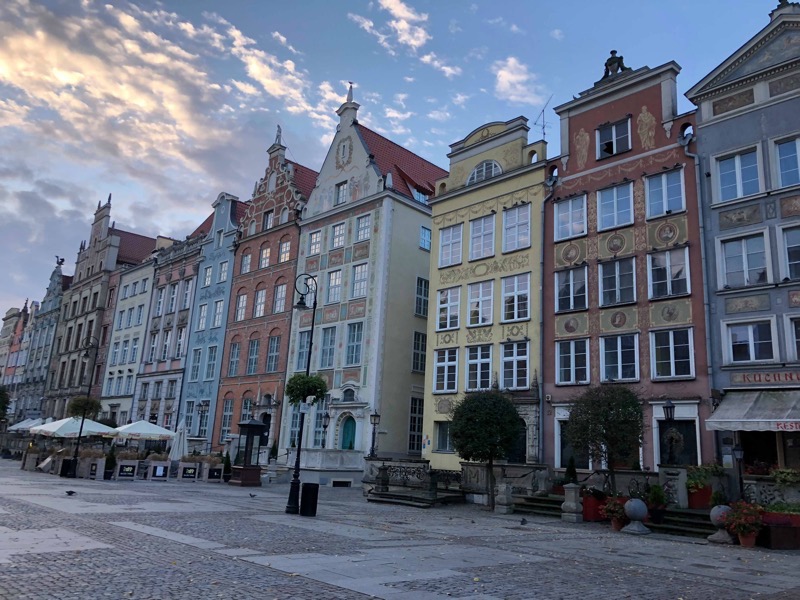
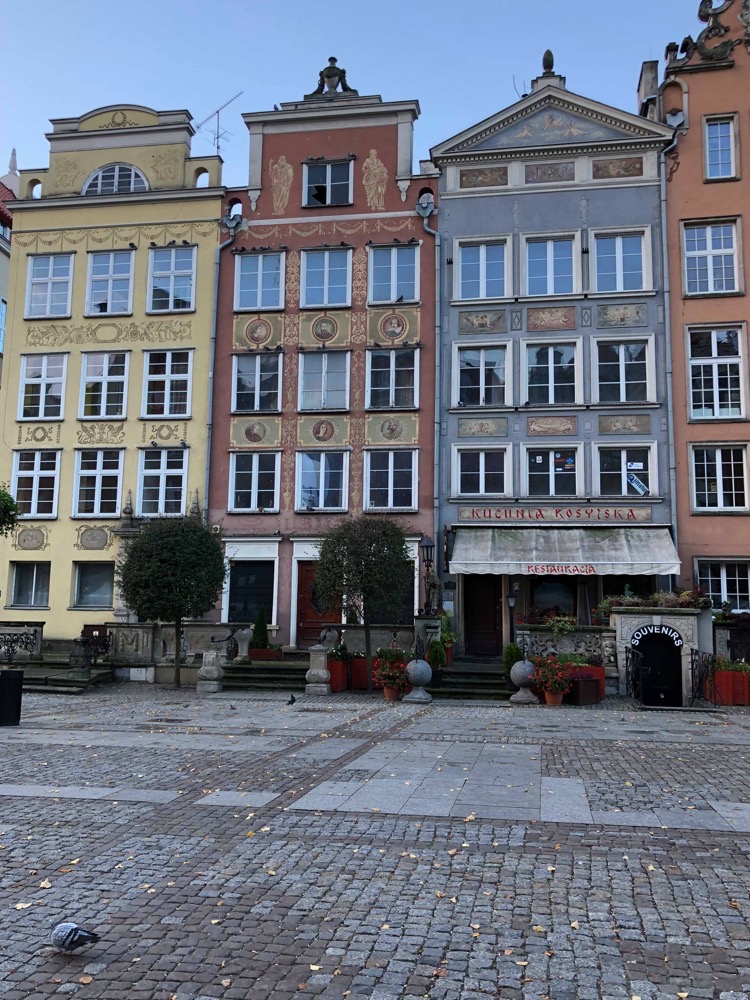
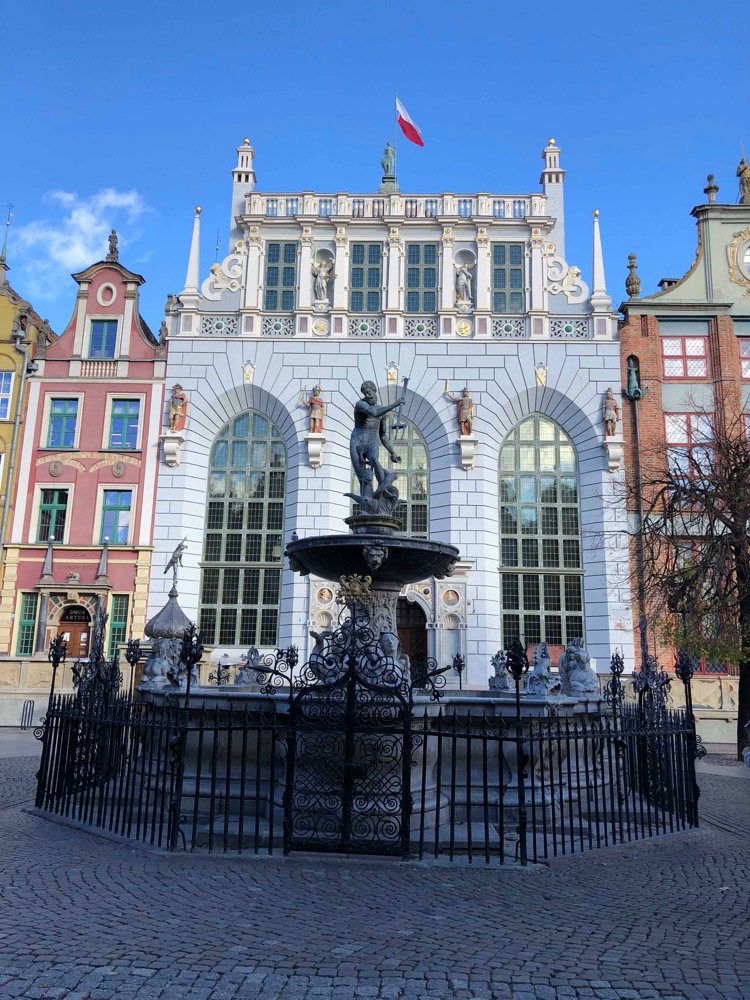
 After breakfast, we struck out to explore properly. Refreshingly most of the Old Town is laid out in a grid so instead of winding through confusing little streets, you could stroll down nice straight cobblestoned streets that would also allow you to (mostly) get far enough back to photograph the architectural gates that seemed to be at the end of most roads in the area.
After breakfast, we struck out to explore properly. Refreshingly most of the Old Town is laid out in a grid so instead of winding through confusing little streets, you could stroll down nice straight cobblestoned streets that would also allow you to (mostly) get far enough back to photograph the architectural gates that seemed to be at the end of most roads in the area. All the drainage down pipes have these fantastical stone dragons and gargoyles spitting water into the street – and for a short arse like me, most of them are at shoulder or head height, so they seem like they’d be a bit hazardous in really wet weather!
All the drainage down pipes have these fantastical stone dragons and gargoyles spitting water into the street – and for a short arse like me, most of them are at shoulder or head height, so they seem like they’d be a bit hazardous in really wet weather!
 The decorative details on all the buildings is just overwhelming, everywhere you look is something new and interesting whether it some stonework, wrought ironwork, frescos, tiles or sculpture… it’s a veritable feast for the eyes.
The decorative details on all the buildings is just overwhelming, everywhere you look is something new and interesting whether it some stonework, wrought ironwork, frescos, tiles or sculpture… it’s a veritable feast for the eyes.
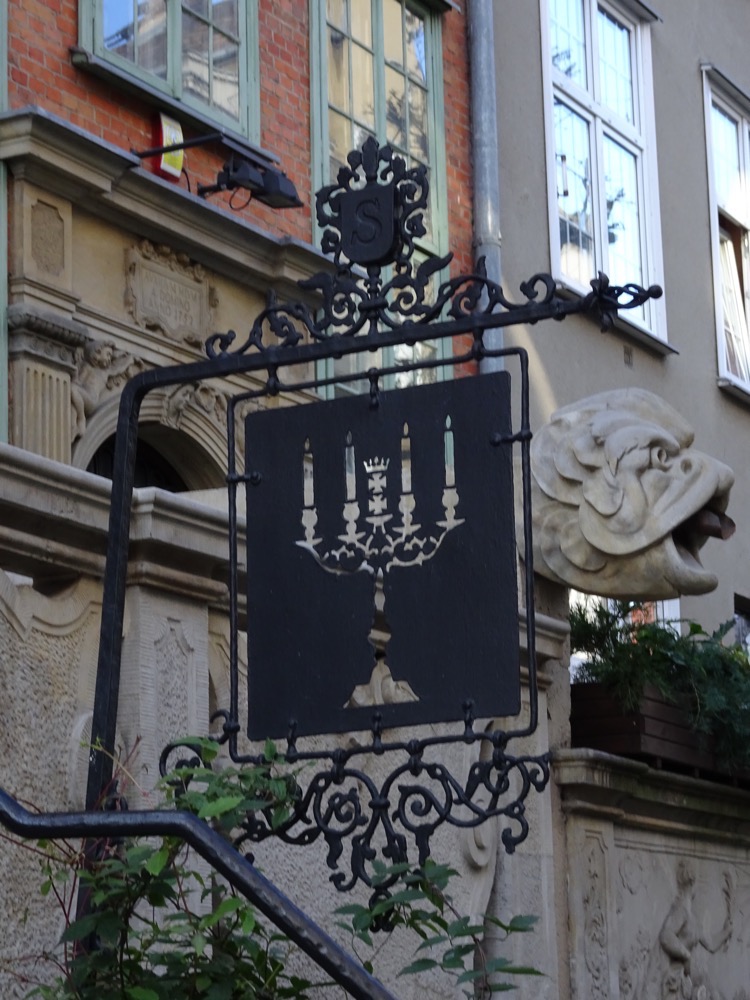
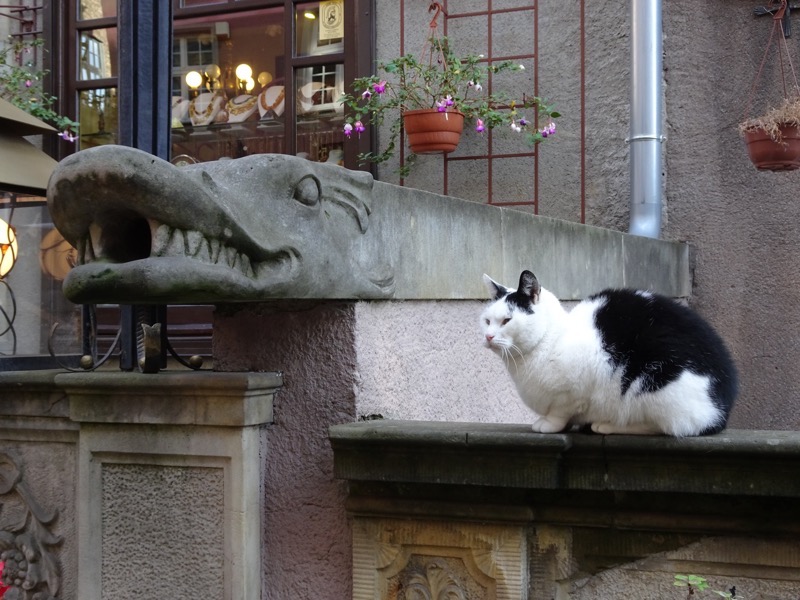 This is known to be the oldest surviving original building in Gdańsk, knowing as Gotyk House which was built in 1453.
This is known to be the oldest surviving original building in Gdańsk, knowing as Gotyk House which was built in 1453.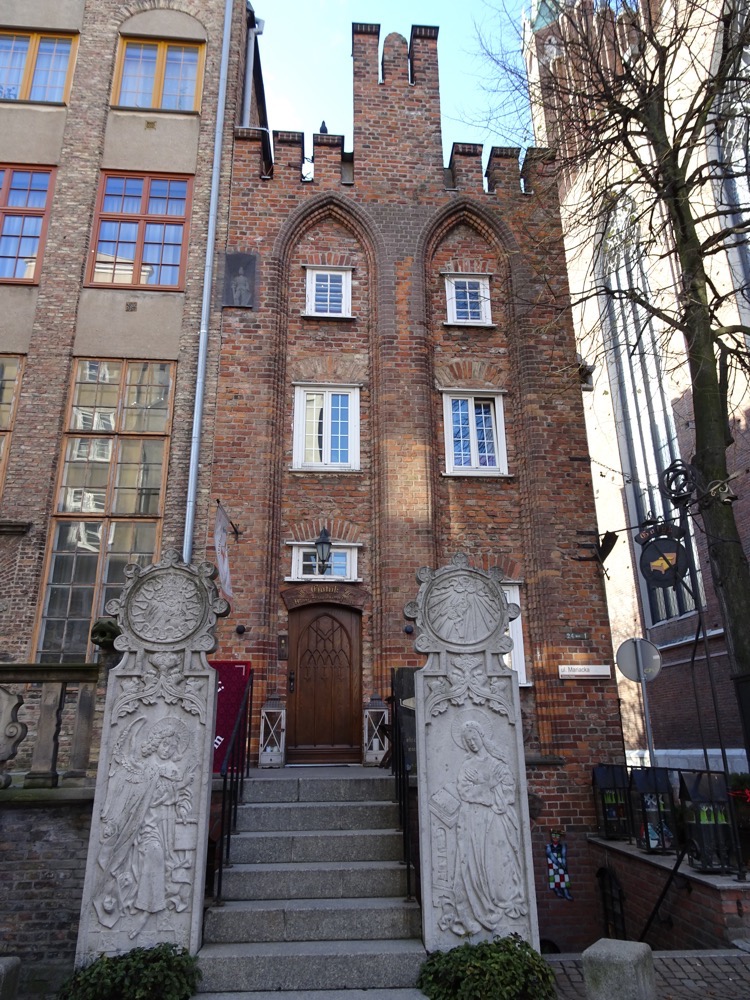 The tennement houses are lovely…
The tennement houses are lovely…
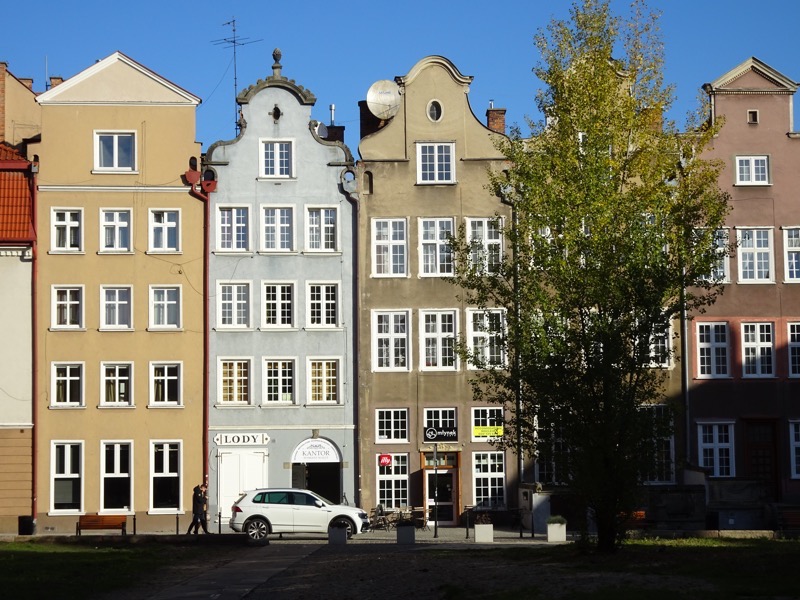 … I want one! Red please. 🙂
… I want one! Red please. 🙂 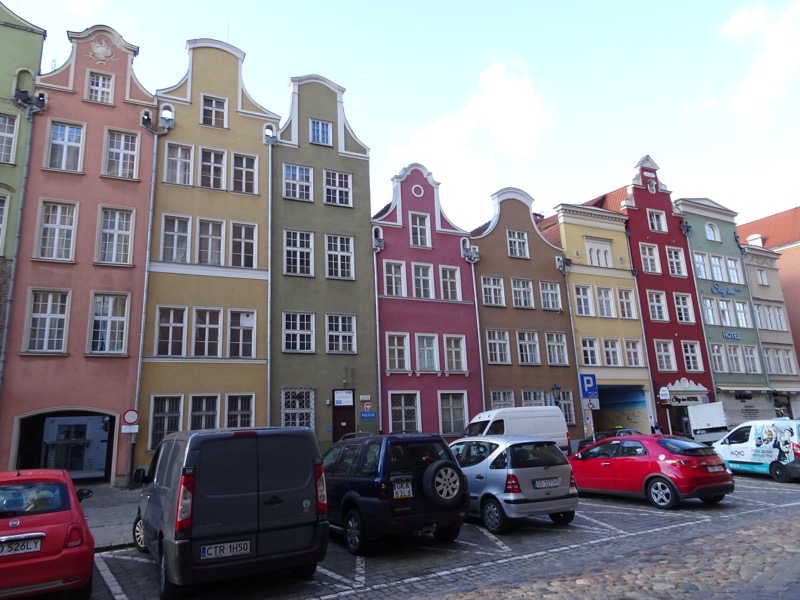
We were making our way to St. Mary’s Church which is more formally know as (wait for it, ahem,) the Basilica of the Assumption of the Blessed Virgin Mary, or even cooler in Polish: the Bazylika Mariacka Wniebowzięcia Najświętszej Maryi Panny w Gdańsku! How’s that for a mouthful. St Mary’s is a Roman Catholic that saw it’s construction begin in either 1379 or 1343, they’re not sure. It is considered to be one of the top three largest brick chuches in the entire world with a volume of somewhere around 185,000m3 and 190,000m3 (no idea why they measure churches for volume but there it is … the other two are the San Petronio Basilica in Bologna at 258,000 m3 (better add that to my list) and Munich’s Frauenkirche which I have a sneaky suspicion we saw back in ’95 and it is roughly the same size as this St Mary’s.
Between 1536 and 1572 the church was used for both Roman Catholic masses and Lutheran services right up until 1945, when Danzig became Polish Gdańsk. It seems the church is mostly known this unusual arrangement, and for its enormous size – it is 105.5m long, 66m and can fit roughly 25,000 people inside. 
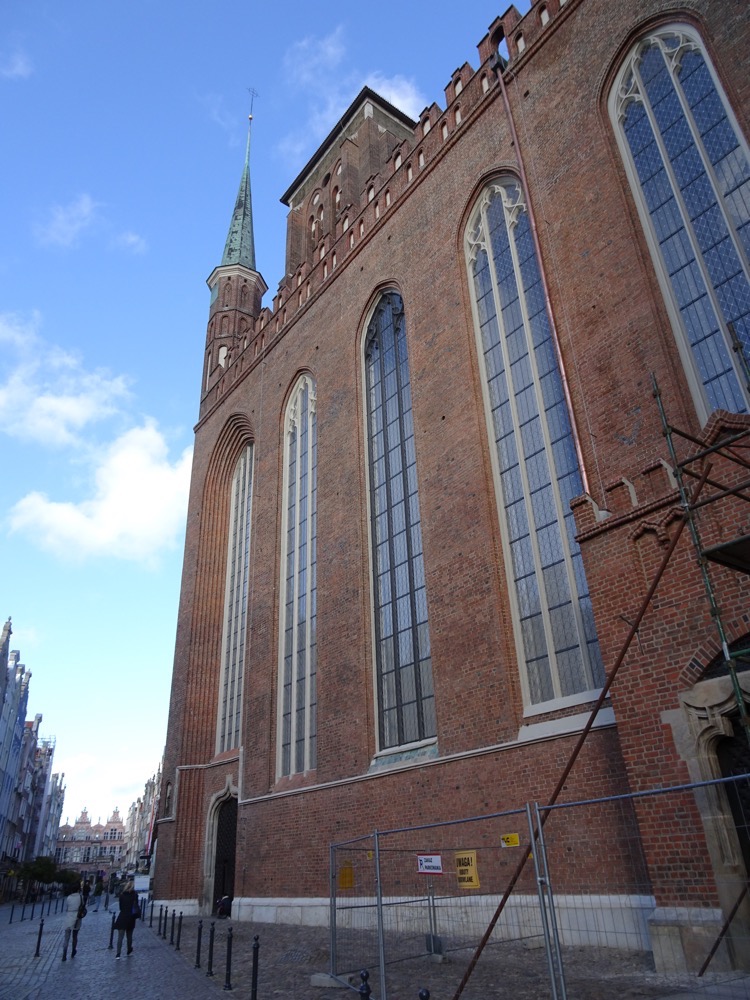
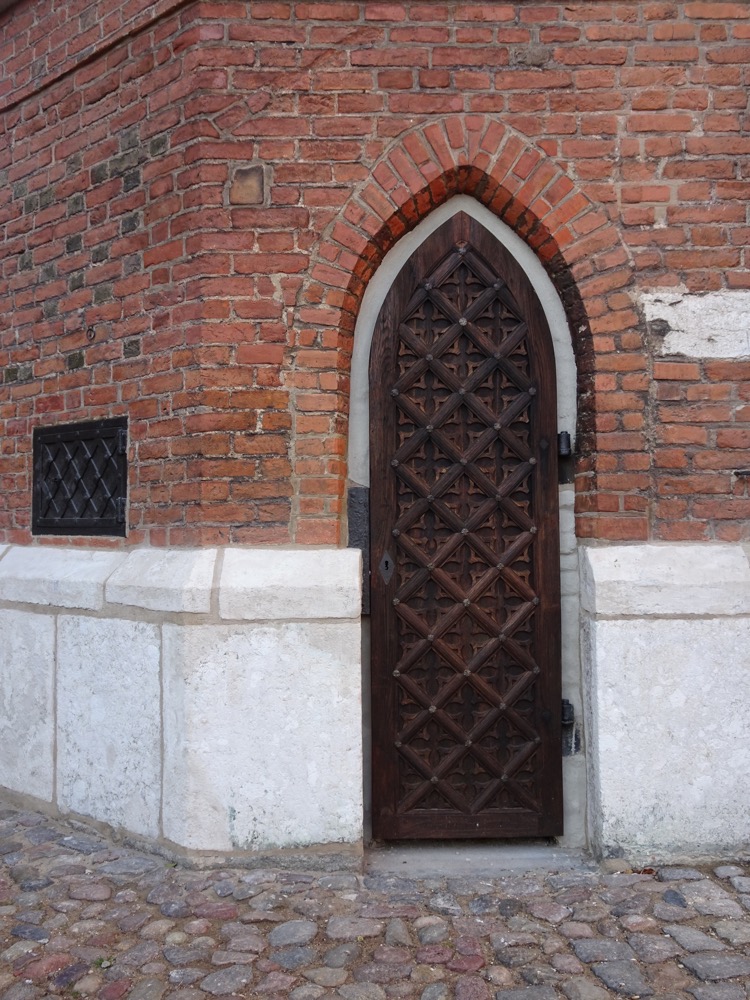 Inside the church is surprisingly stark (like the Frauenkirche in Munich), which was confusing when I first walked in and said to yale, ‘I thought this was a catholic church but it looks kinda Lutheran in here.’, and was again confused when I saw a confessional a bit later… but the dual denomination situation described above kinda explains that I guess.
Inside the church is surprisingly stark (like the Frauenkirche in Munich), which was confusing when I first walked in and said to yale, ‘I thought this was a catholic church but it looks kinda Lutheran in here.’, and was again confused when I saw a confessional a bit later… but the dual denomination situation described above kinda explains that I guess.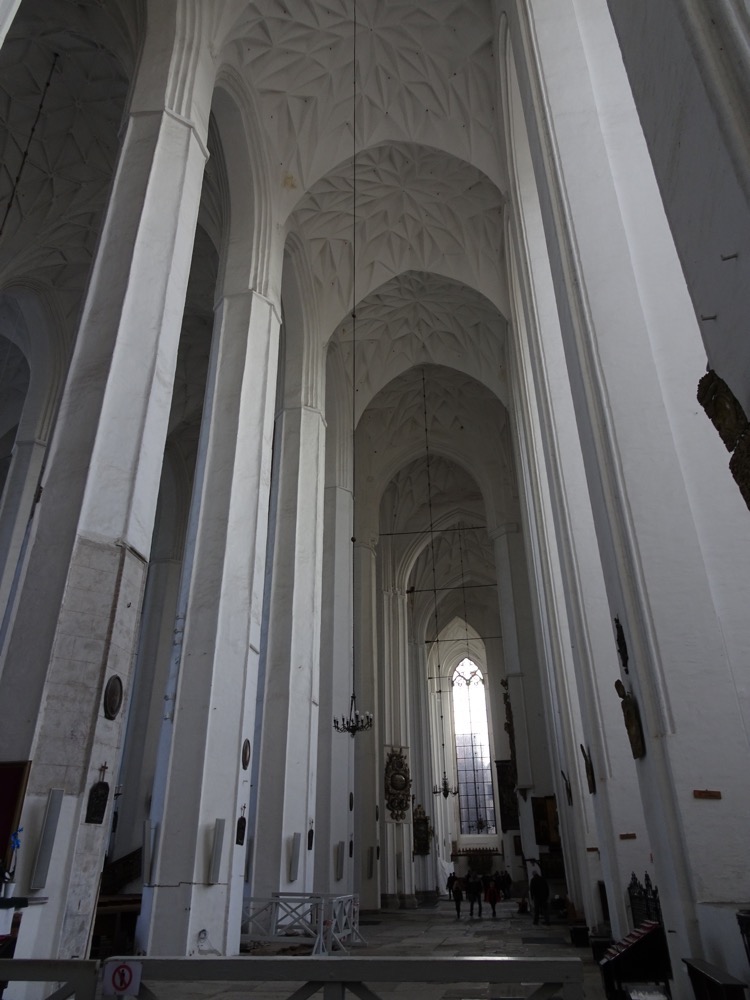
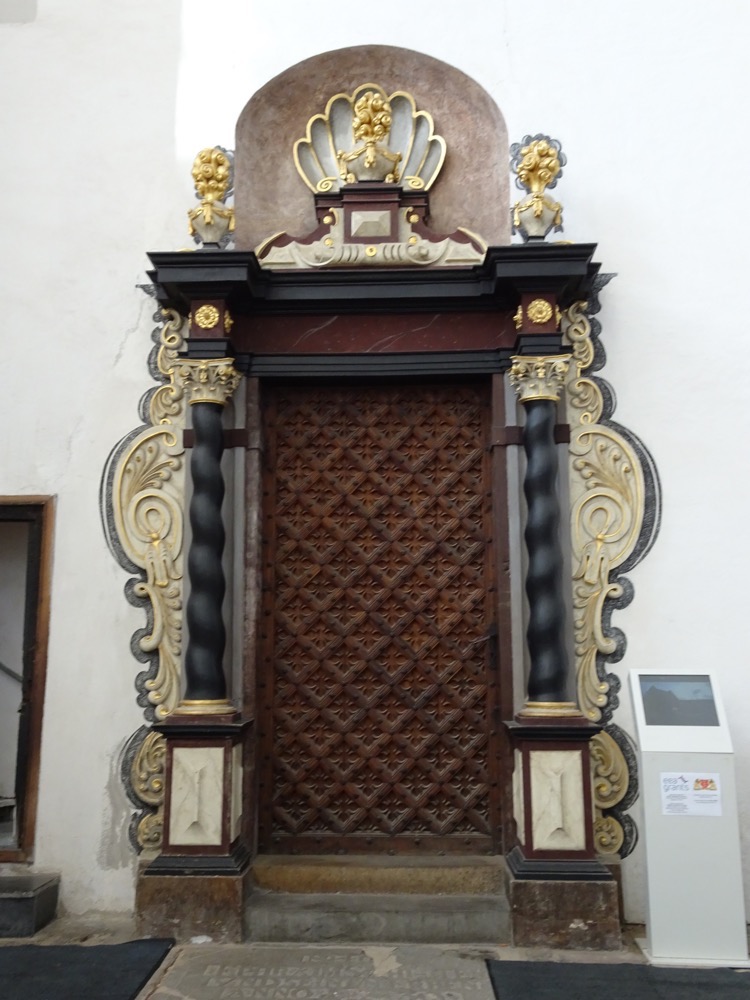 The enormous baptismal font is unusually placed almost right inside the door – about 50m from the nave.
The enormous baptismal font is unusually placed almost right inside the door – about 50m from the nave.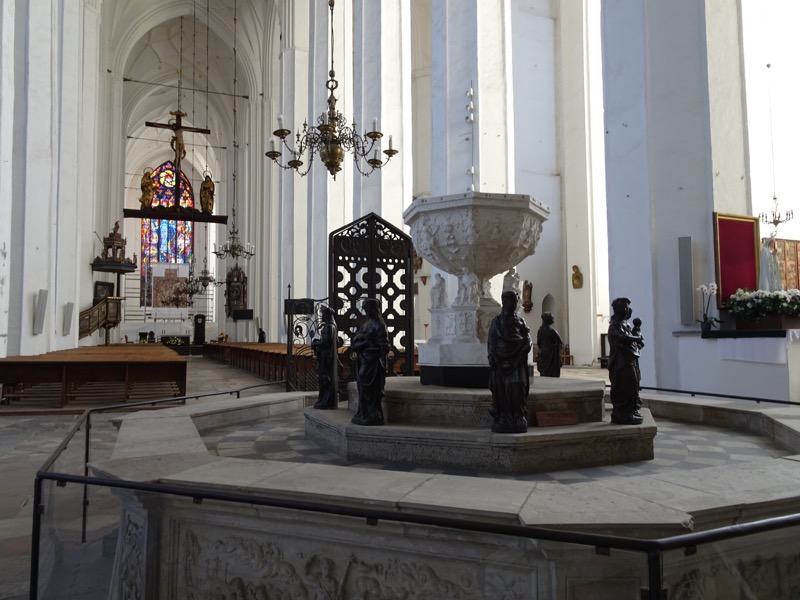 We saw this fancy commercial votive candle system – copyrighted in Ireland… sometimes I think we forget that big churches are more run as big business these days.
We saw this fancy commercial votive candle system – copyrighted in Ireland… sometimes I think we forget that big churches are more run as big business these days.
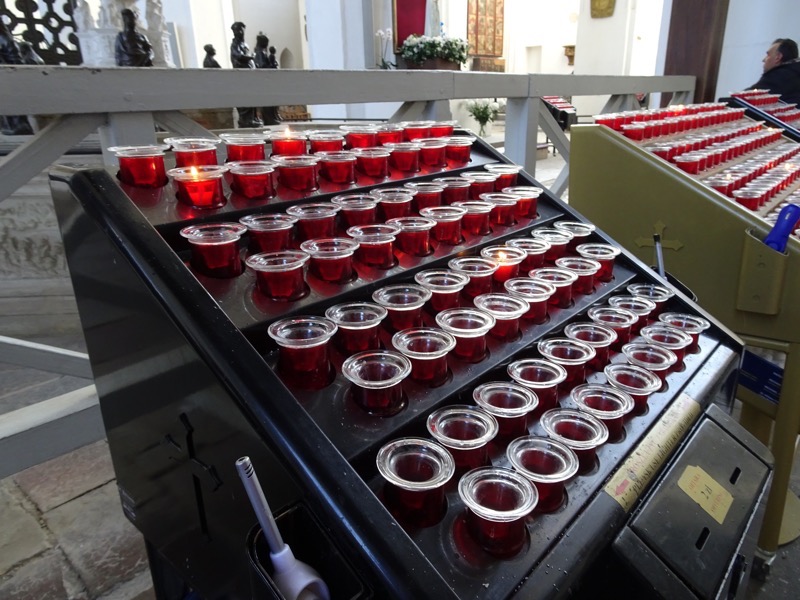 Anyway, St. Mary’s is a triple-aisled hall church with a triple-aisled transept – which basically means that the main nave and the two adjacent transepts are of roughly similar length, height and width. The building is an excellent example of late Gothic architecture. In the late 1500s to early 1600s the church was rebuilt and enlarged somewhat with the final footprint of the church not being achieved until over 150 years since the initial construction had started.
Anyway, St. Mary’s is a triple-aisled hall church with a triple-aisled transept – which basically means that the main nave and the two adjacent transepts are of roughly similar length, height and width. The building is an excellent example of late Gothic architecture. In the late 1500s to early 1600s the church was rebuilt and enlarged somewhat with the final footprint of the church not being achieved until over 150 years since the initial construction had started.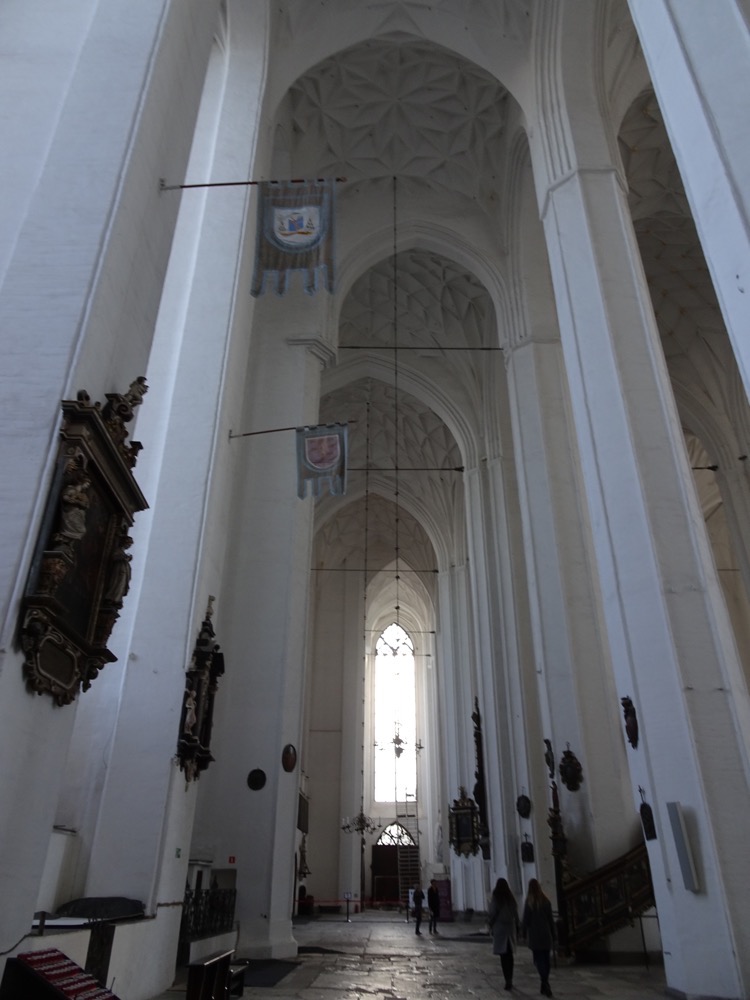 There are so many different donation boxes in this church – all different sizes, and marked to all different causes/saints/purposes.
There are so many different donation boxes in this church – all different sizes, and marked to all different causes/saints/purposes.
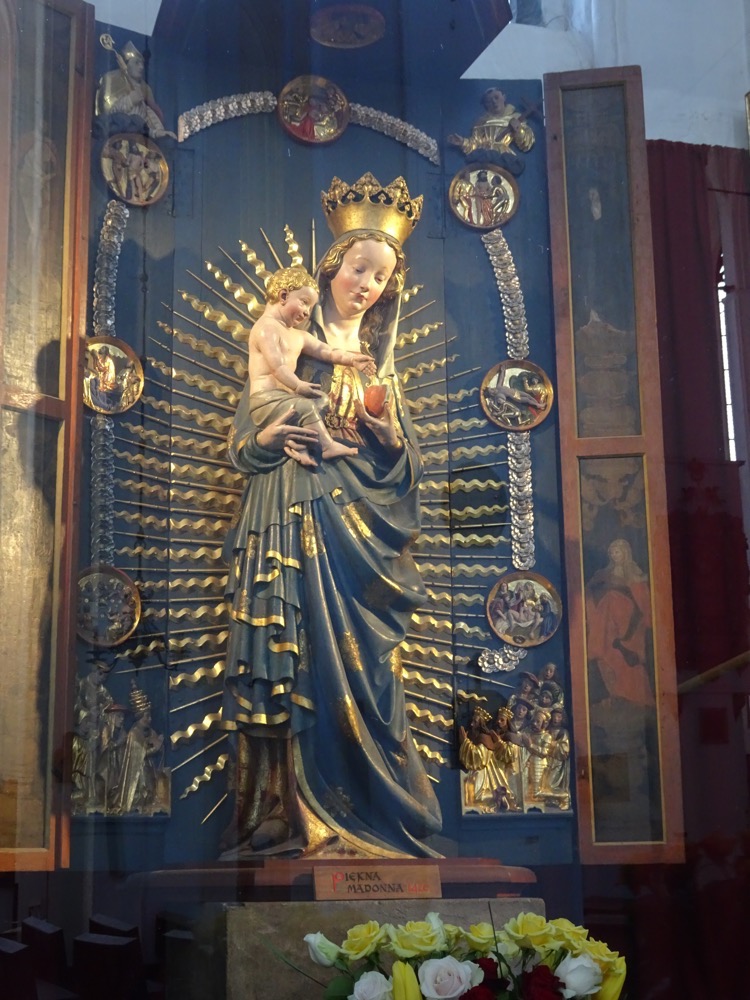 Embroidered banner: ‘God, Honour and Homeland’. No idea what period, but I want to say, late 19th or 20th centuries, just because this place isn’t climate controlled and the goldwork isn’t that tarnished.
Embroidered banner: ‘God, Honour and Homeland’. No idea what period, but I want to say, late 19th or 20th centuries, just because this place isn’t climate controlled and the goldwork isn’t that tarnished.
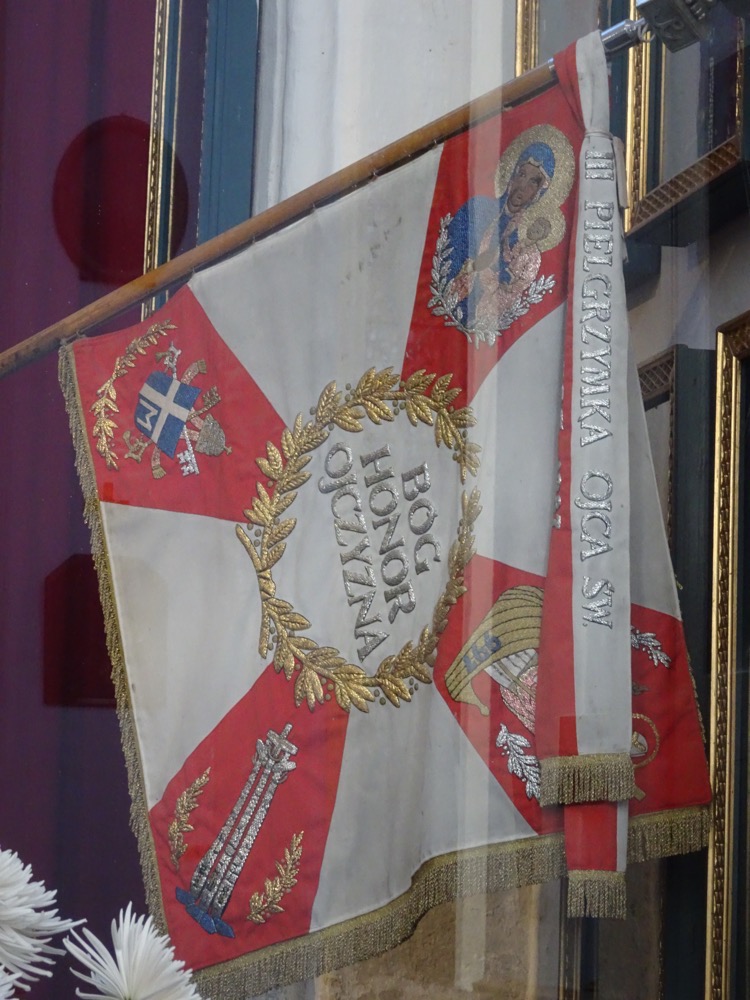
The Pulpit is pretty impressive – another later period addition from 1762. Apparently designed by Johann Heinrich Meissner and the oil paintings decorating it were done by Isaac van den Block.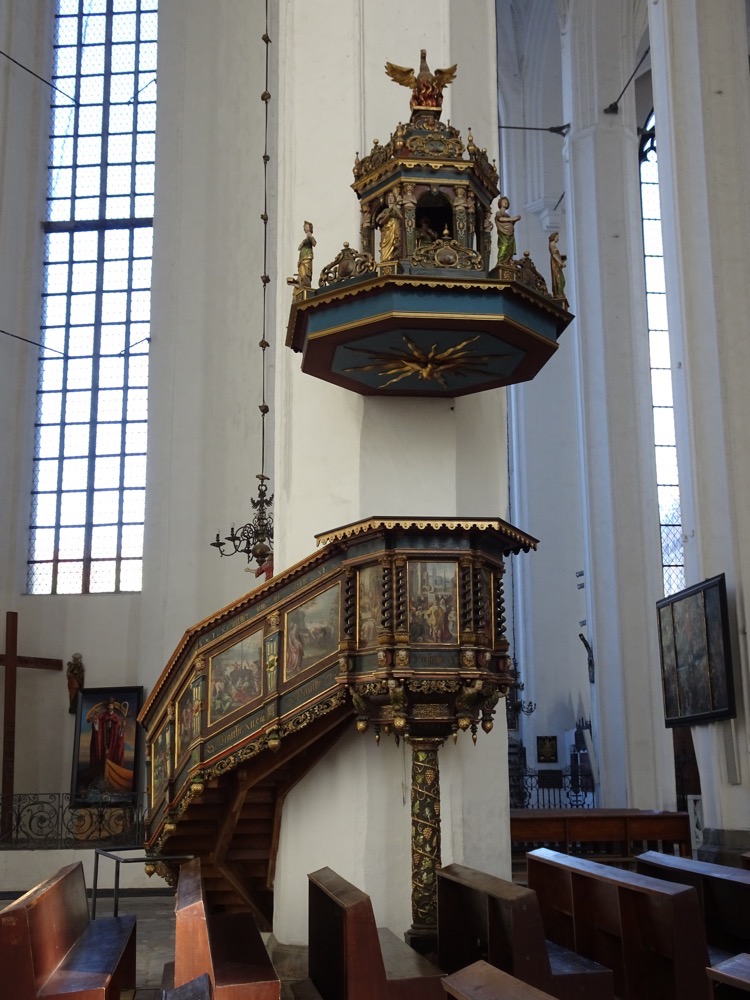


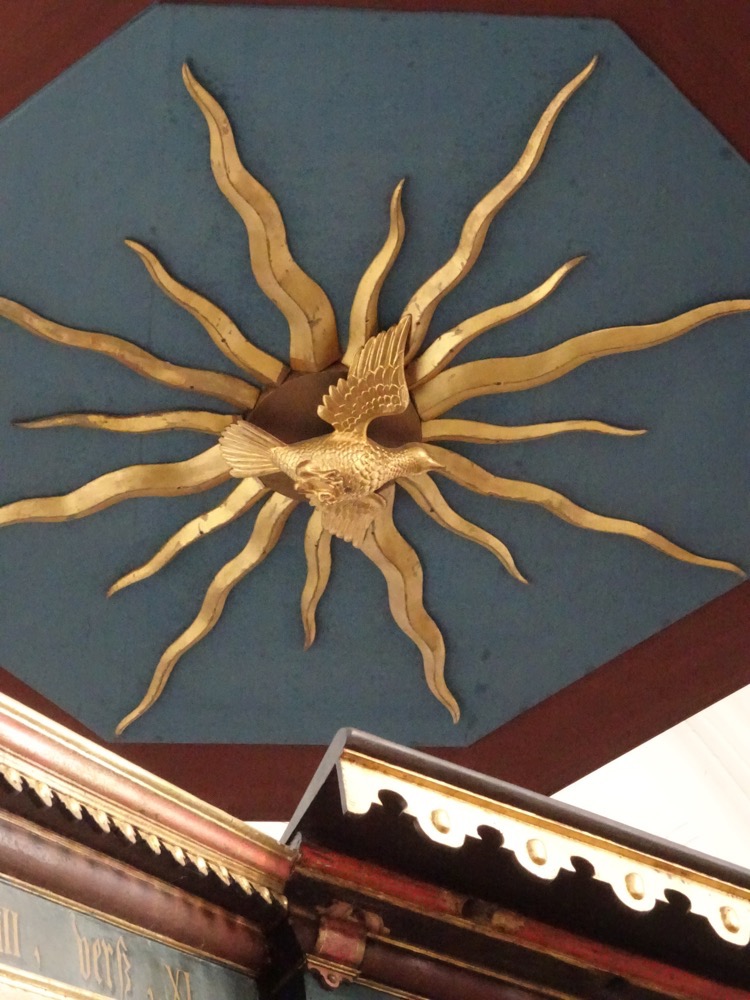

To the left of the pulpit you can find the Rajnold Chapel, where there is a 19th century replica of Hans Memling’s famous triptych, “The Last Judgement”. The original is kept in the town’s National Museum – it was painted between 1467 and 1471.and the painting itself has quite a cool history. It was commissioned by Angelo Tani, an agent of the Medici at Bruges, but the painting was captured at sea by Paul Beneke, a privateer from Danzig. Apparently it took a lengthy lawsuit against the Danzig Hanseatic League to see it returned to Italy. Eventually it somehow made its way back to St Mary’s, but of course was then moved to the National Museum for preservation.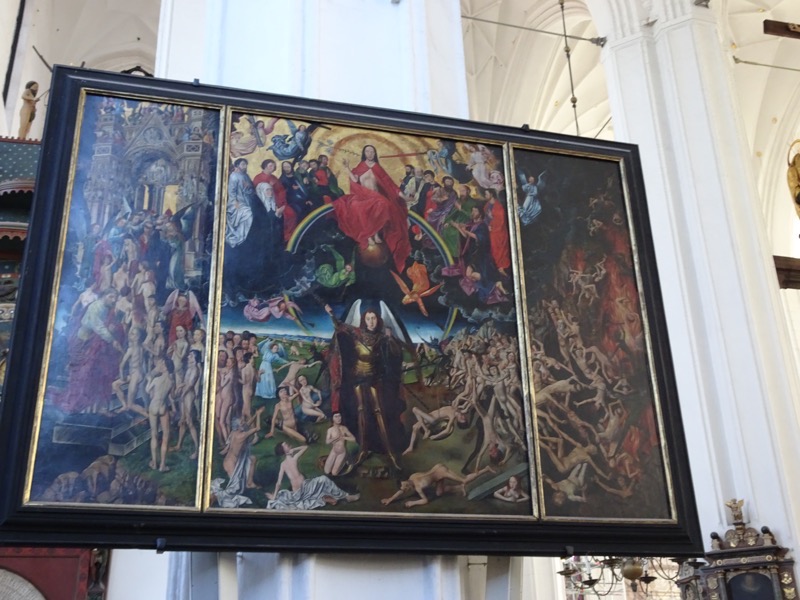 The central panel shows Jesus sitting in judgment, while St Michael is weighing souls and sending the damned to Hell, while the saved are being guided to heaven by St Peter and angels.
The central panel shows Jesus sitting in judgment, while St Michael is weighing souls and sending the damned to Hell, while the saved are being guided to heaven by St Peter and angels.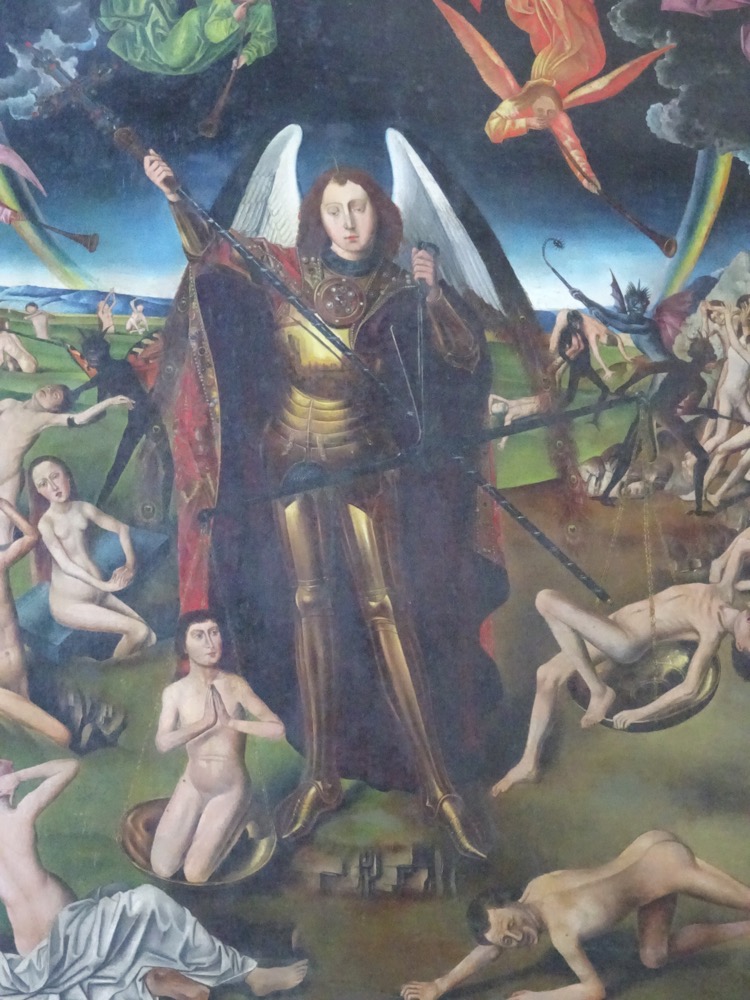
I can’t find any information on this artwork at all…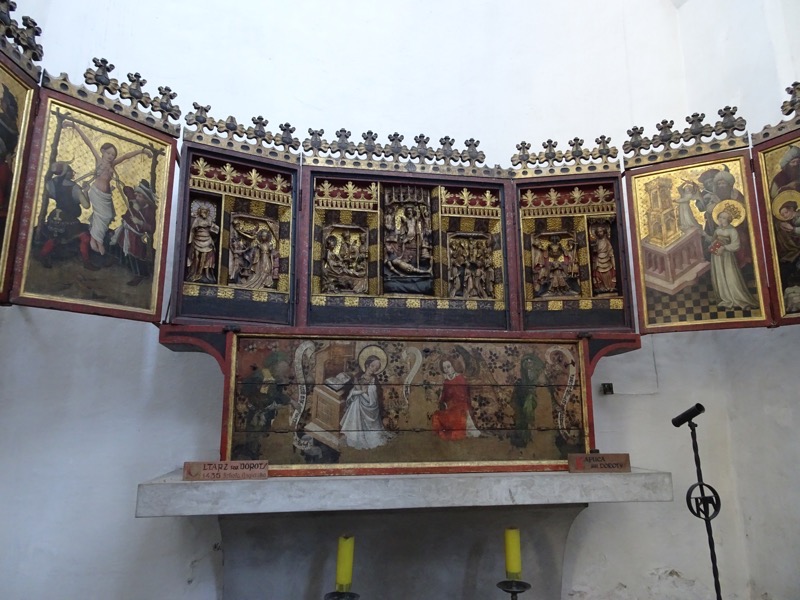
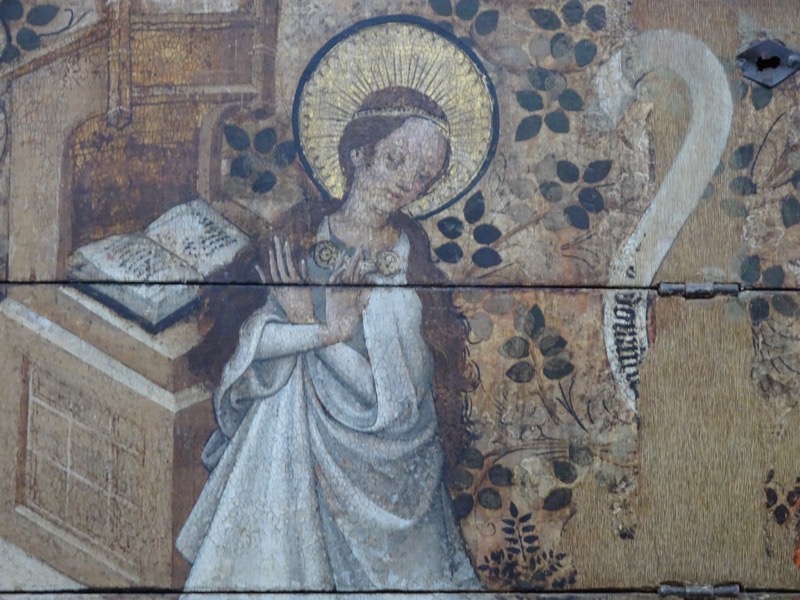 but here is your little bit o’ medieval weirdness for the day:
but here is your little bit o’ medieval weirdness for the day: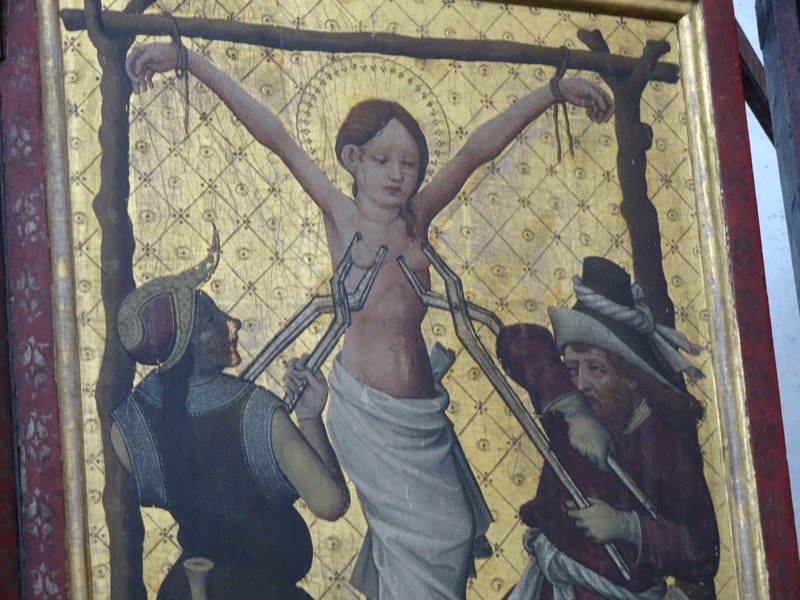 This rather incongruous memorial was to remember the 96 victims of a plane crash in Smolensk on 10th April 2011. Lech Kaczyński, the fourth President of the Republic of Poland, was on the Polish Air Force Tu-154 when it crashed outside of Smolensk, as was his wife, First Lady and Economic Minister for Poland at the time.
This rather incongruous memorial was to remember the 96 victims of a plane crash in Smolensk on 10th April 2011. Lech Kaczyński, the fourth President of the Republic of Poland, was on the Polish Air Force Tu-154 when it crashed outside of Smolensk, as was his wife, First Lady and Economic Minister for Poland at the time. Directly opposite this very modern memorial is an enormous medieval astronomical clock. Standing 14m tall, it is said to have been constructed by Hans Düringer between 1464 and 1470. Like every other monumental medeival astronomical clock, it is said that Düringer had his eyes put out after he made it so he could not make another – which begs the question: why would a medieval master clockmaker accept such a commission if ultimately he was going to be blinded to stop him from replicating his work?! Dunno… urban myths alive and well in the middle ages.
Directly opposite this very modern memorial is an enormous medieval astronomical clock. Standing 14m tall, it is said to have been constructed by Hans Düringer between 1464 and 1470. Like every other monumental medeival astronomical clock, it is said that Düringer had his eyes put out after he made it so he could not make another – which begs the question: why would a medieval master clockmaker accept such a commission if ultimately he was going to be blinded to stop him from replicating his work?! Dunno… urban myths alive and well in the middle ages.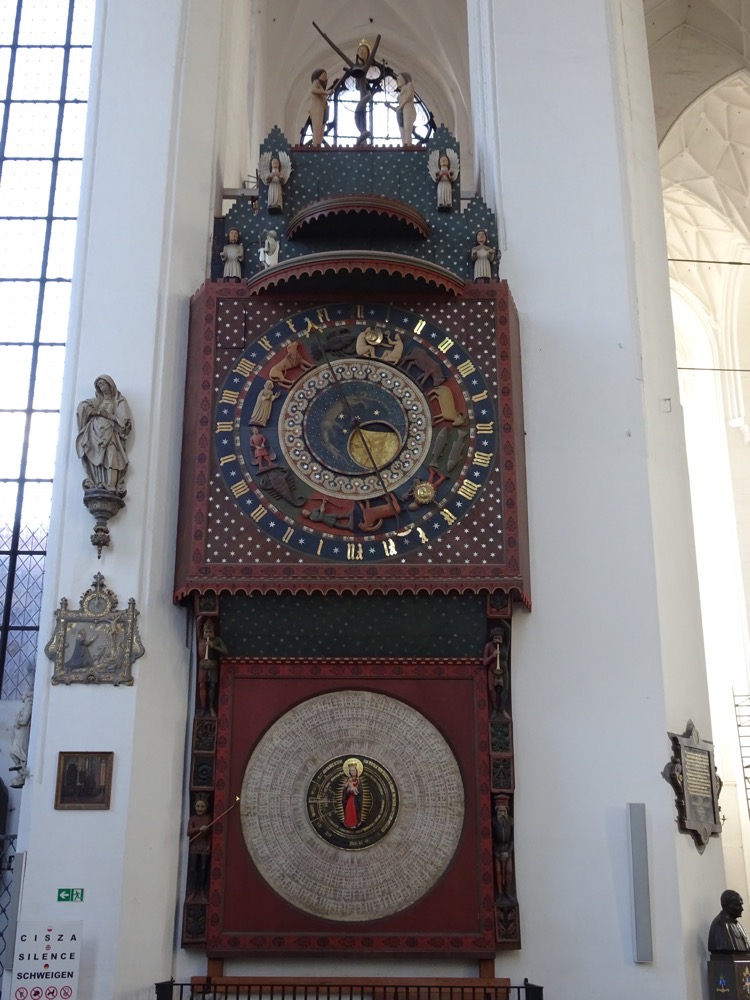 The clock has some pretty complex dials that show time, date, phases of the moon, the position of the moon and sun in relation to the zodiac signs, and the calendar of saints.
The clock has some pretty complex dials that show time, date, phases of the moon, the position of the moon and sun in relation to the zodiac signs, and the calendar of saints. 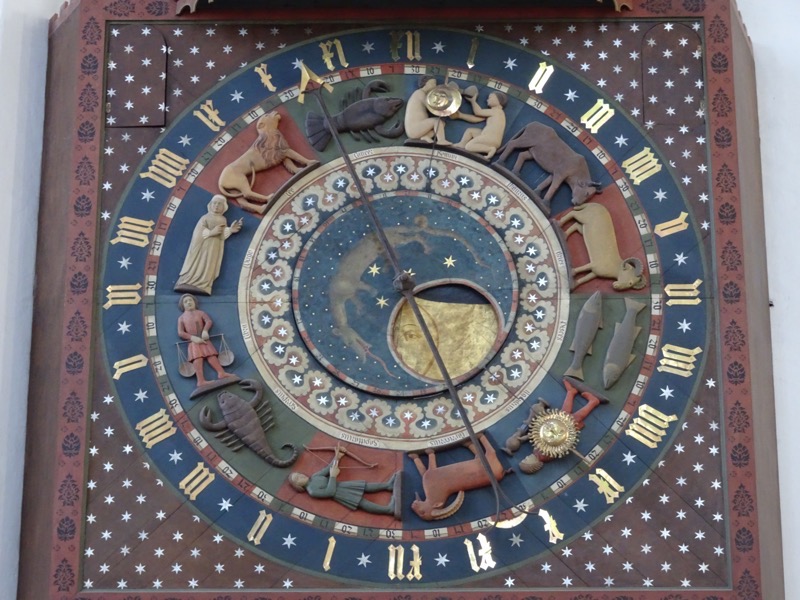
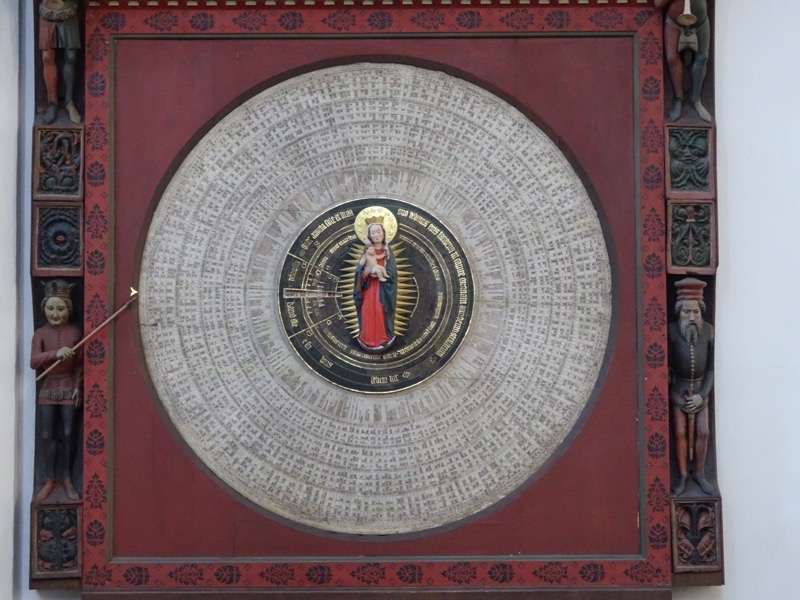
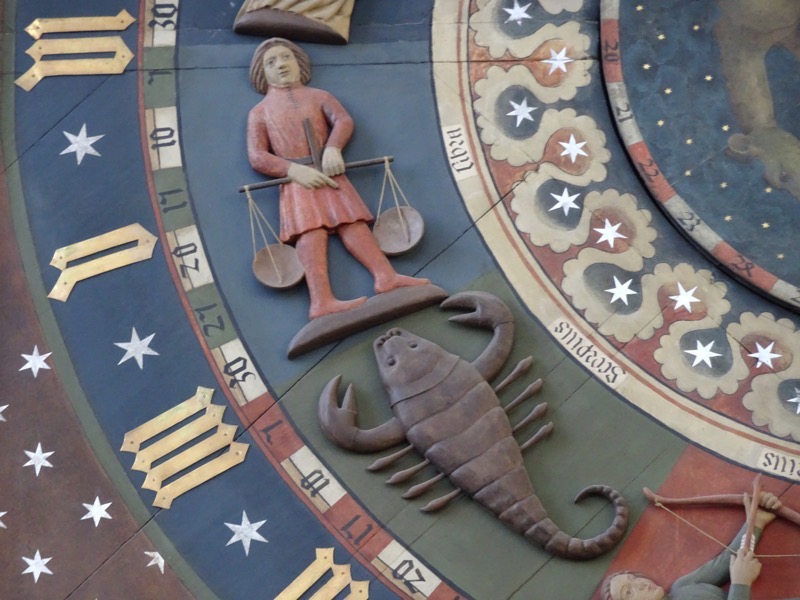
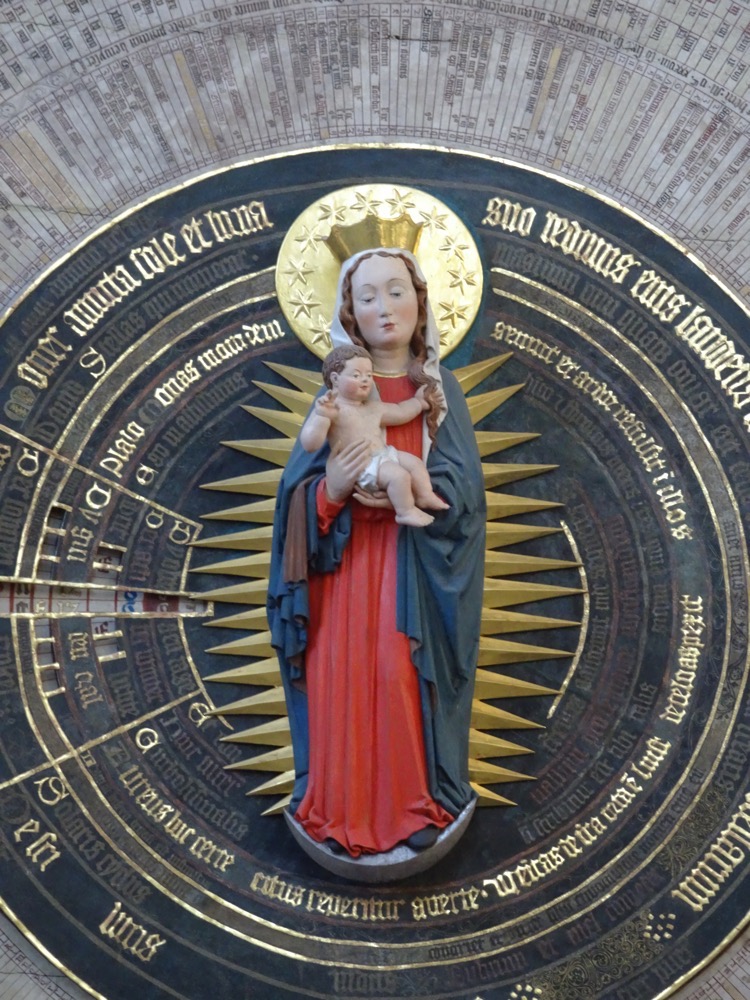 Another unlabelled, anonymous fresco/sculpture.
Another unlabelled, anonymous fresco/sculpture.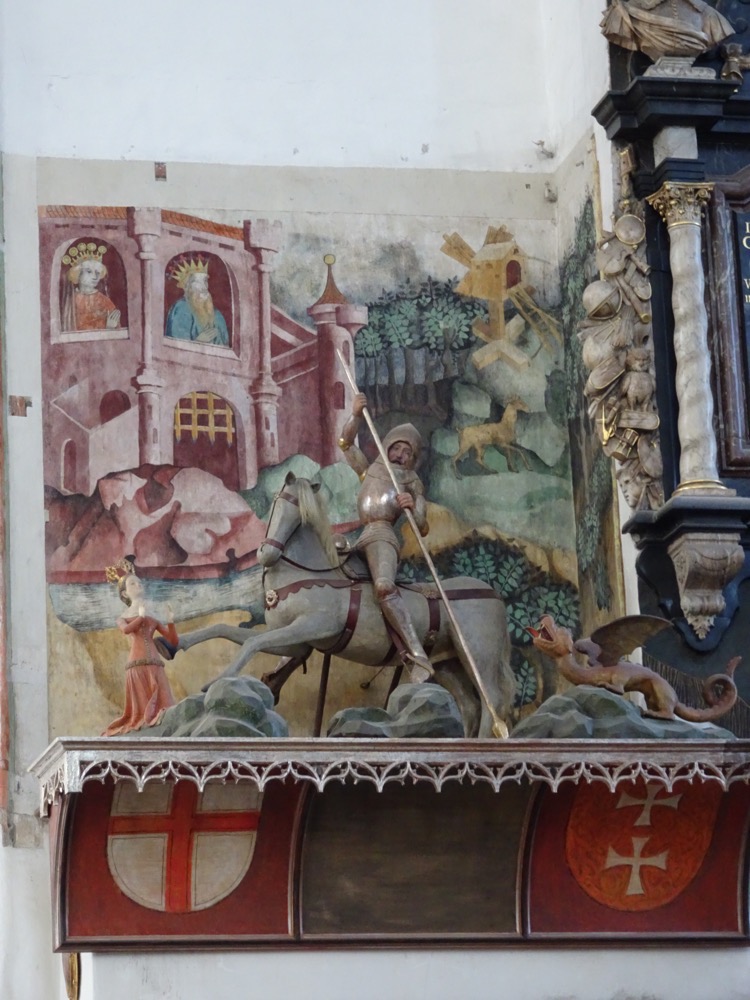
The original high altar was created in 1511–1517 by Michael of Augsburg is currently undergoing restoration, right here in the church. They have the space, so why not I guess.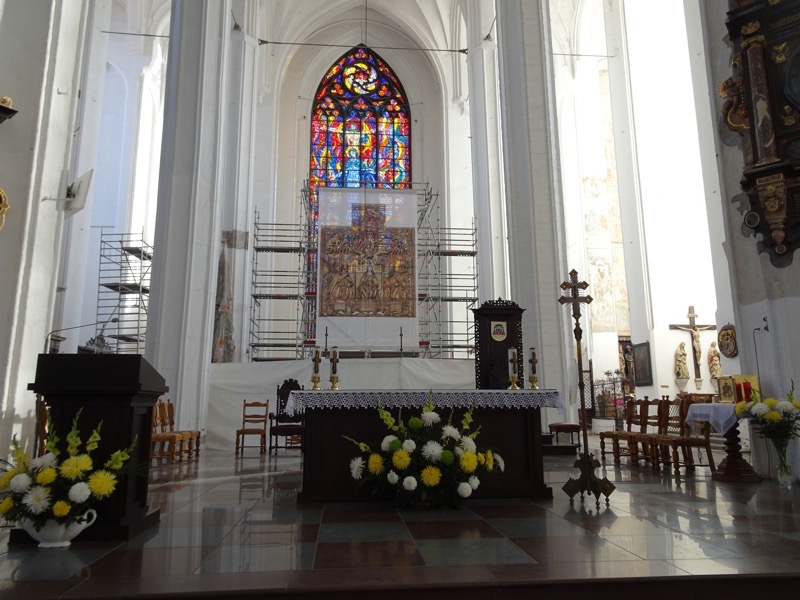 You can see the altar all pulled apart, and restorers were working on it while we were visiting.
You can see the altar all pulled apart, and restorers were working on it while we were visiting.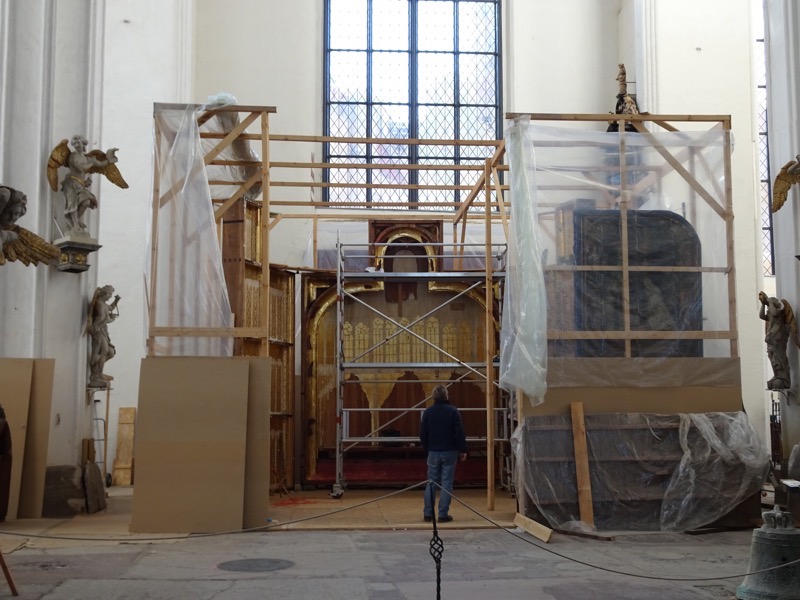
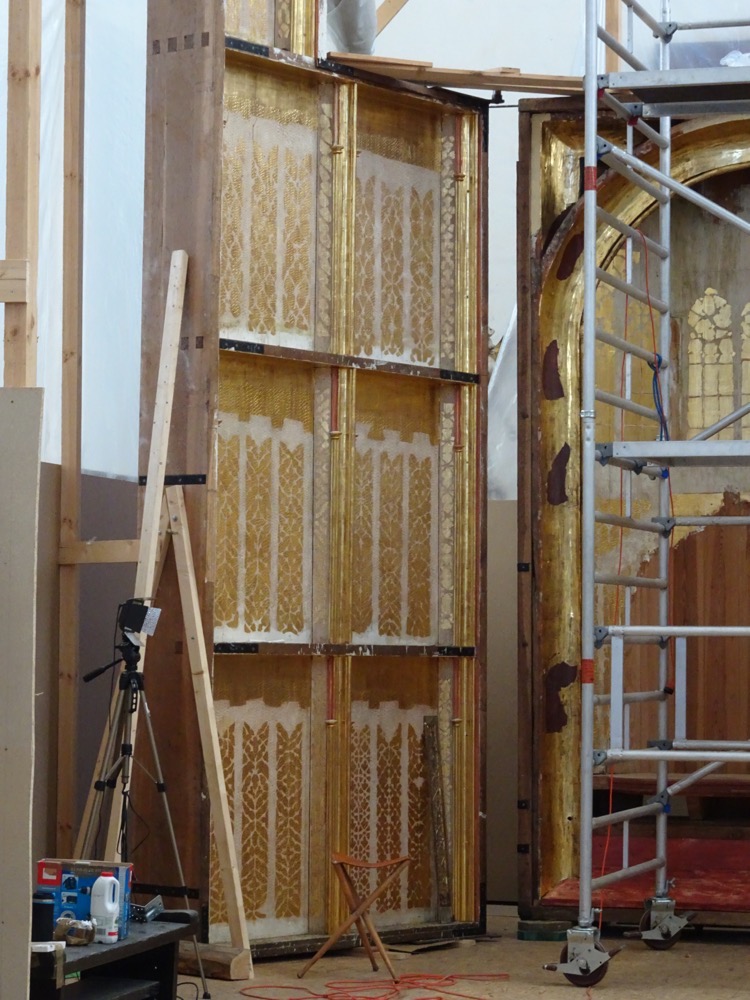
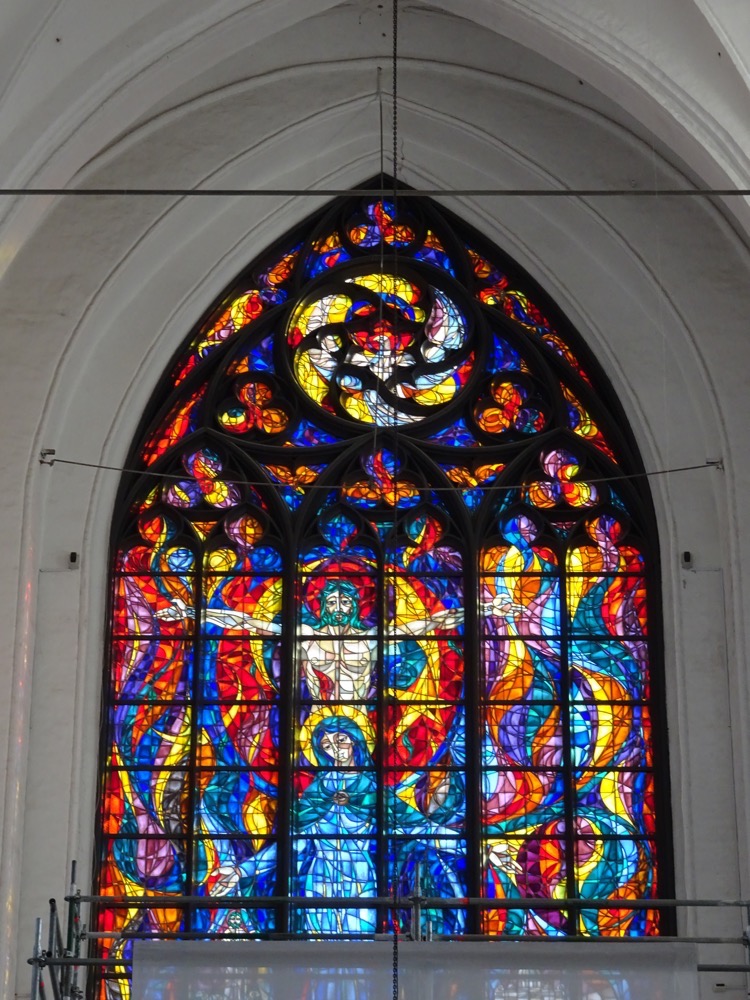 From the altar looking back down the nave – it really is an enromous church.
From the altar looking back down the nave – it really is an enromous church.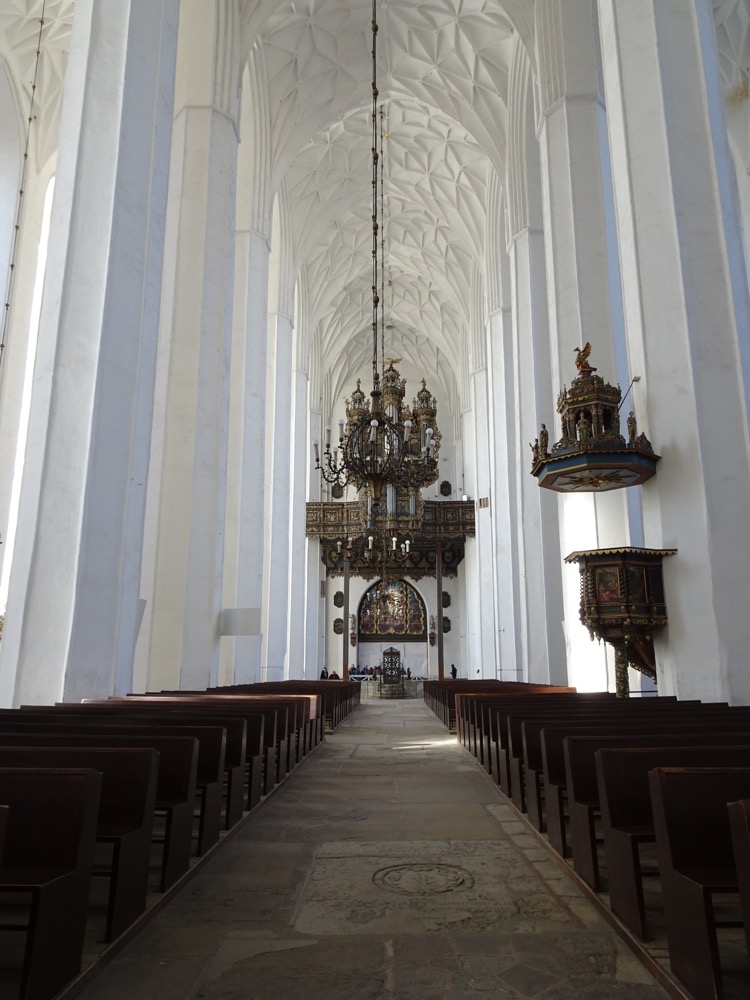 I think this is a representation of the ten commandments from 1485… there is supposed to be a piece here of that nature, though the artist is unknown.
I think this is a representation of the ten commandments from 1485… there is supposed to be a piece here of that nature, though the artist is unknown.
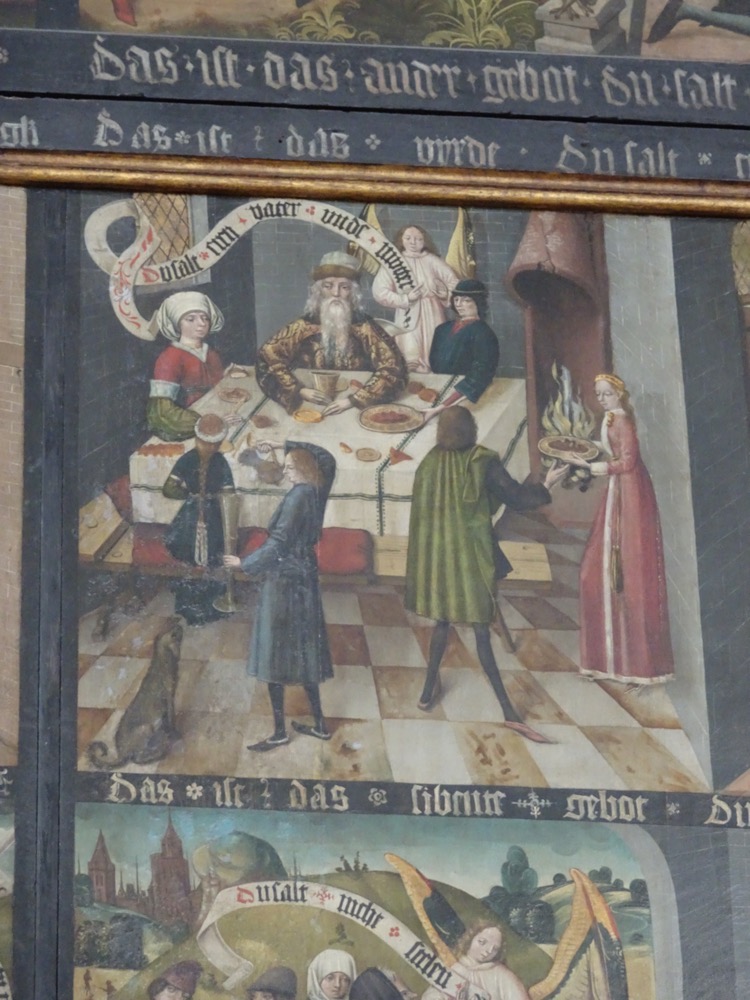
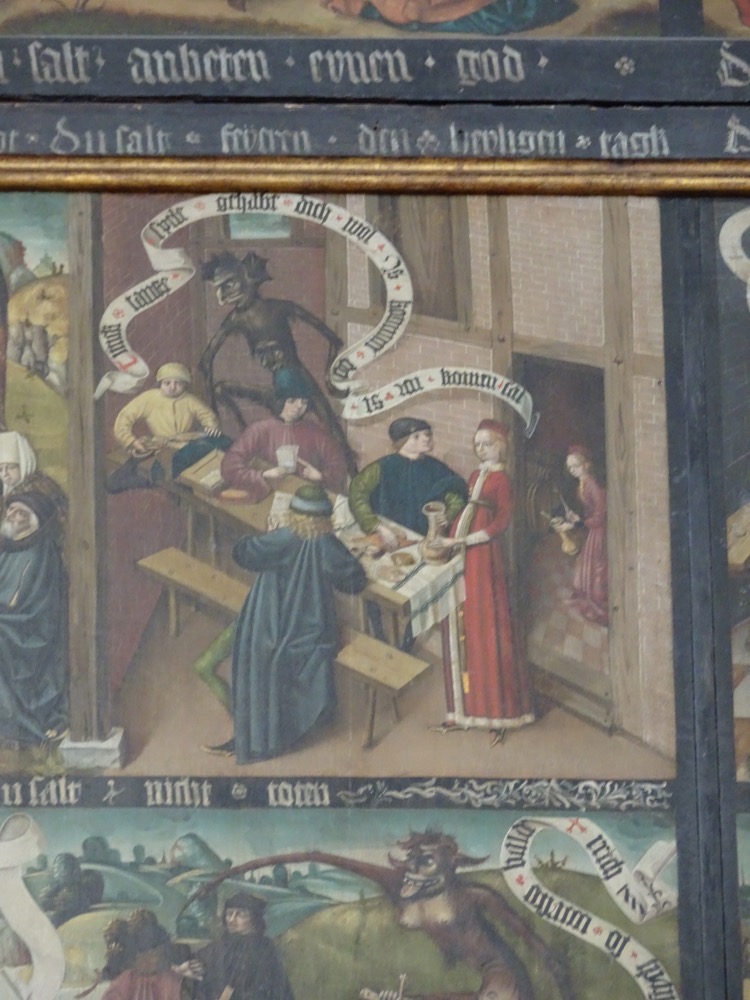
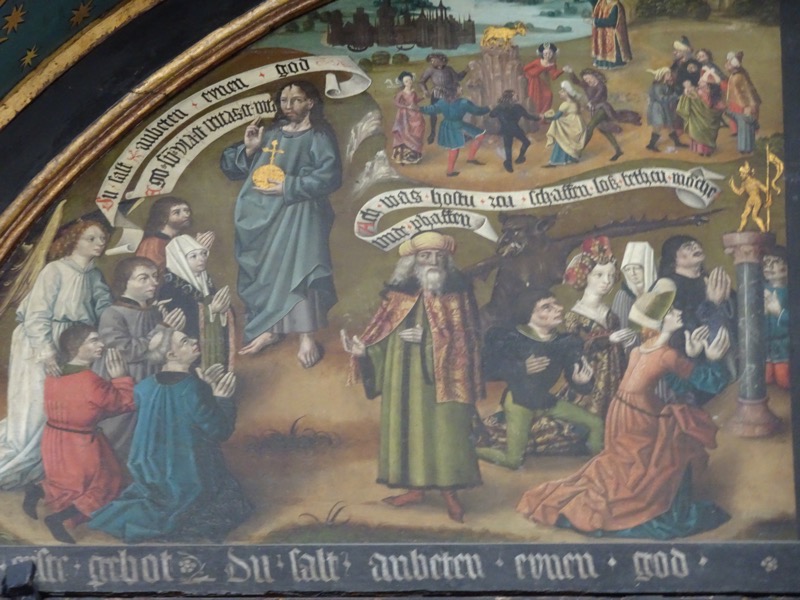 Organ – no real church is complete without one.
Organ – no real church is complete without one.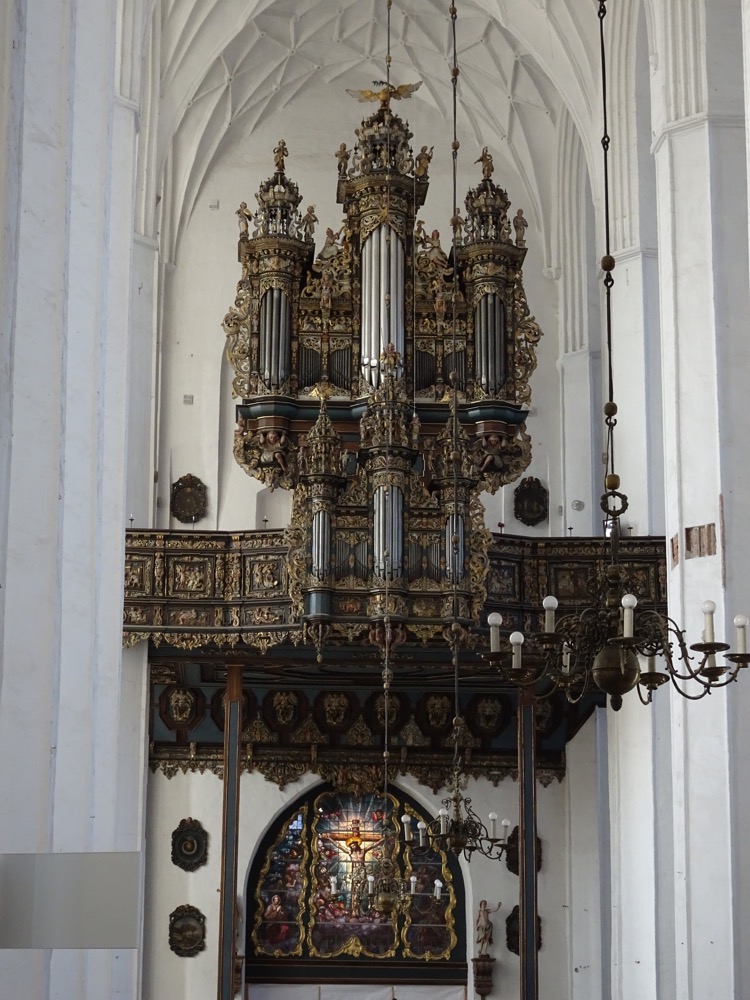
 More medieval paintings with no information or attribution 🙁
More medieval paintings with no information or attribution 🙁 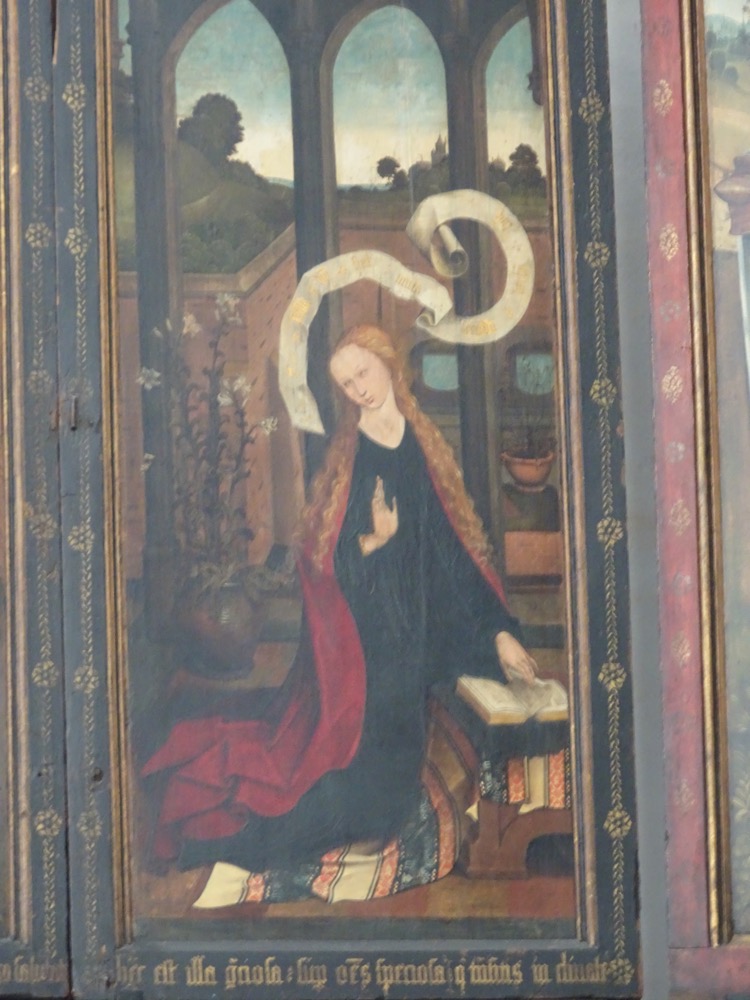
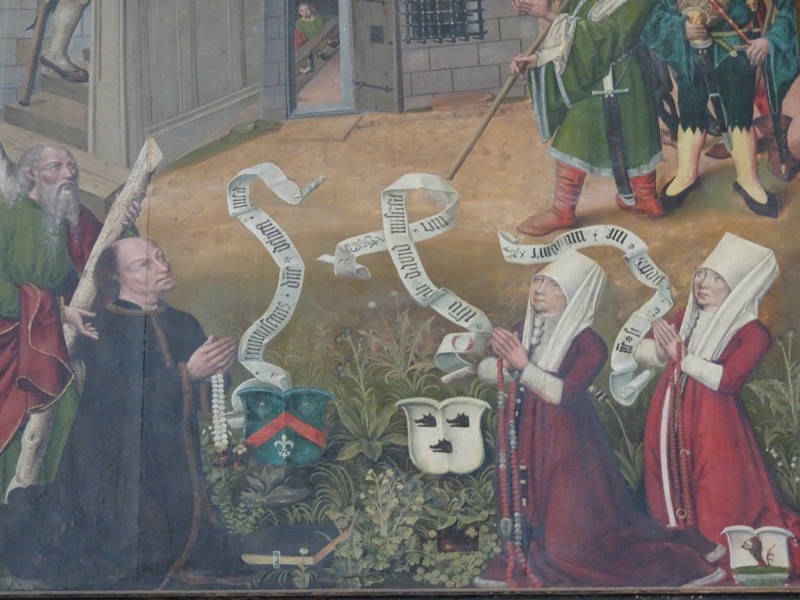 Photographing these paintings in this evironment is worse than in a musuem under glass – the camera just can’t handle the brightness ration from the stark white walls and the glare forming from them on the surface of the canvasses is almost impossible to avoid.
Photographing these paintings in this evironment is worse than in a musuem under glass – the camera just can’t handle the brightness ration from the stark white walls and the glare forming from them on the surface of the canvasses is almost impossible to avoid.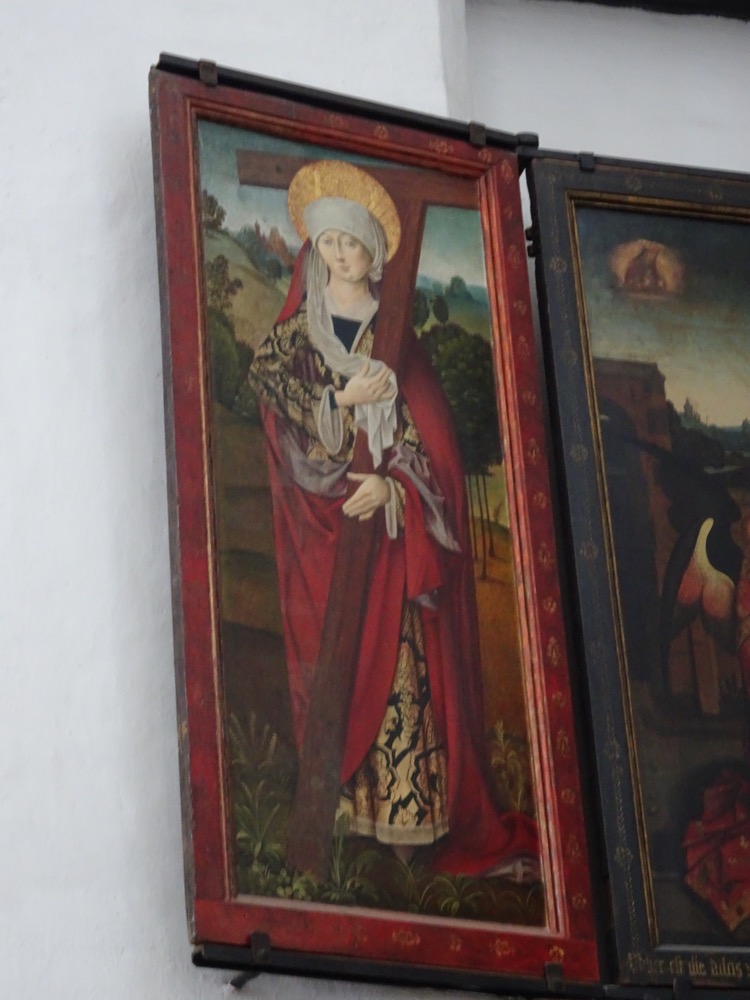
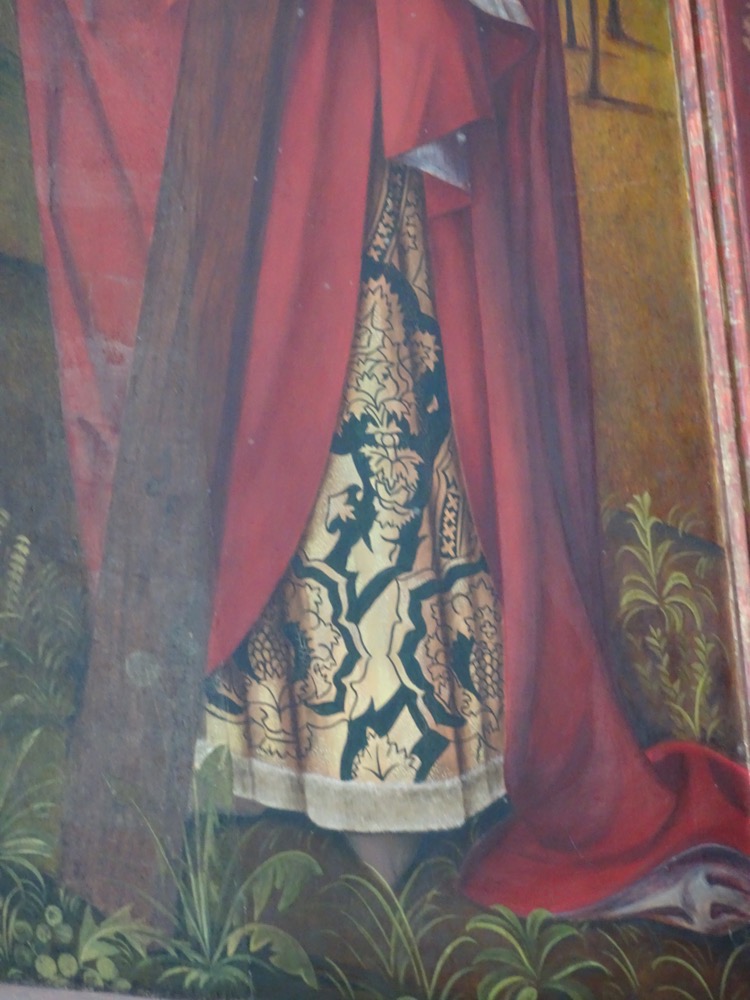
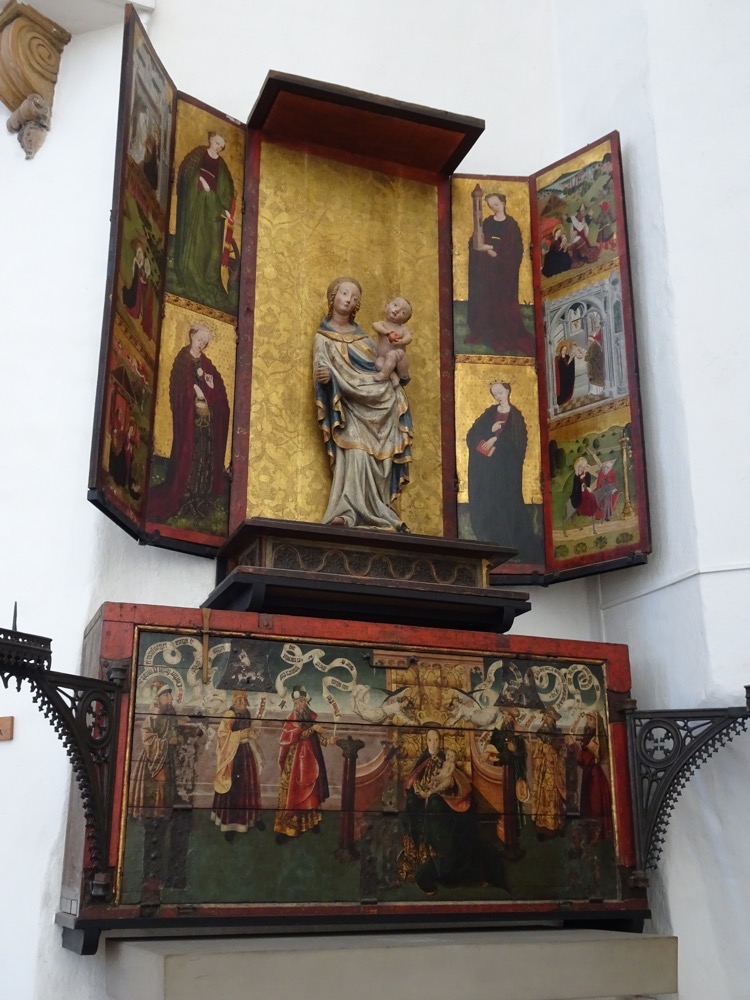


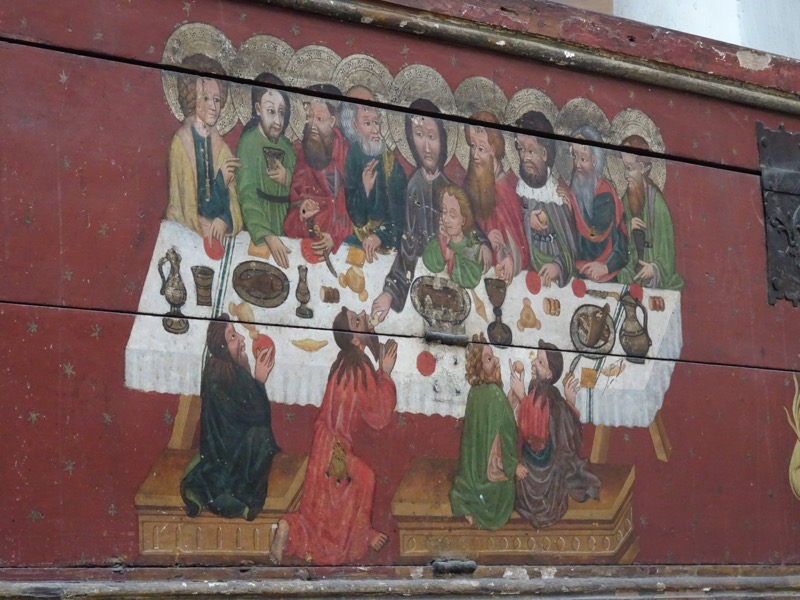
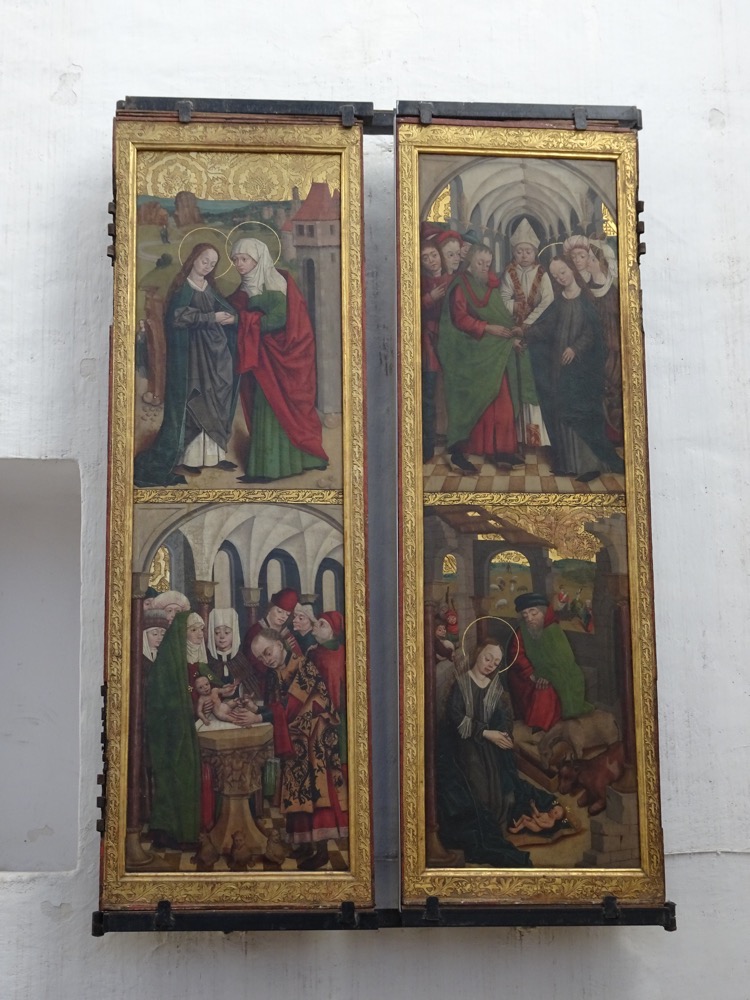
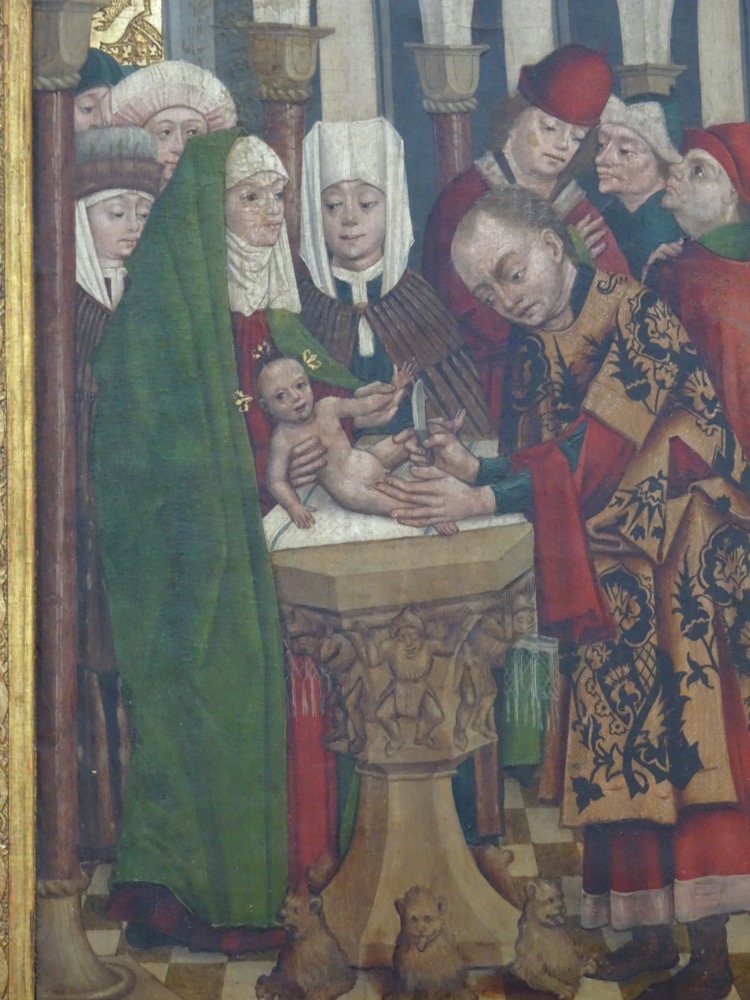
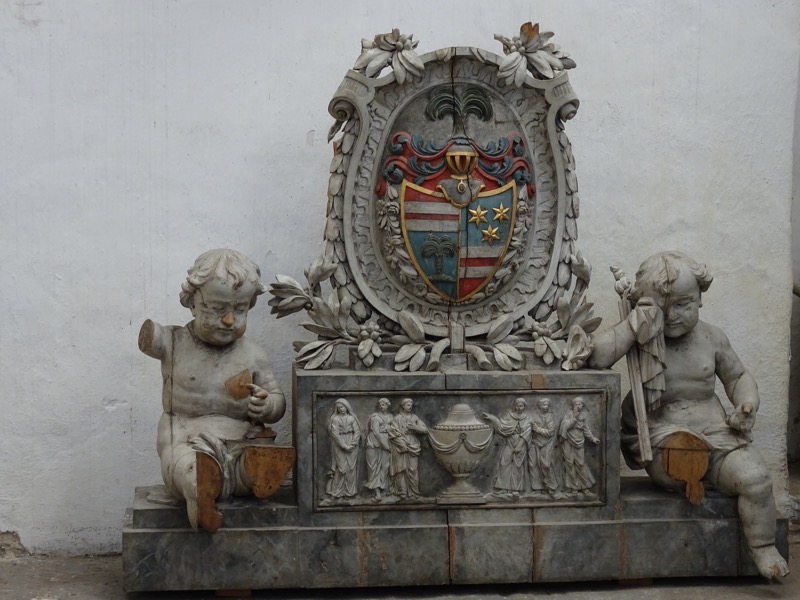 This is me… looking at all these cool paintings and then not being able to find any information on them whatsoever.
This is me… looking at all these cool paintings and then not being able to find any information on them whatsoever.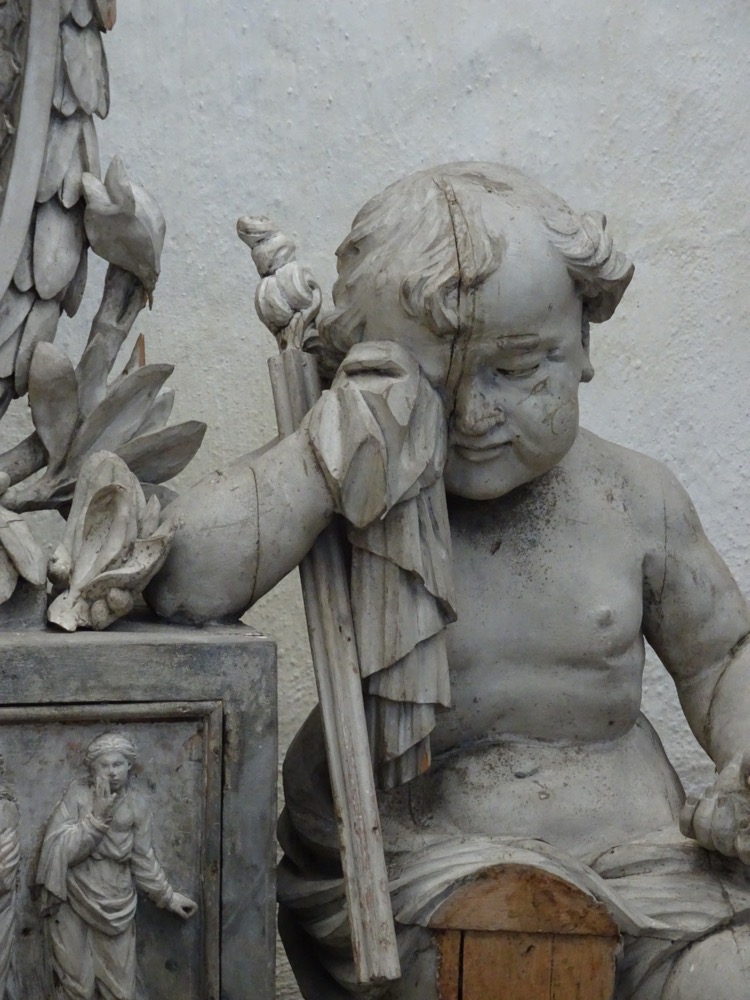
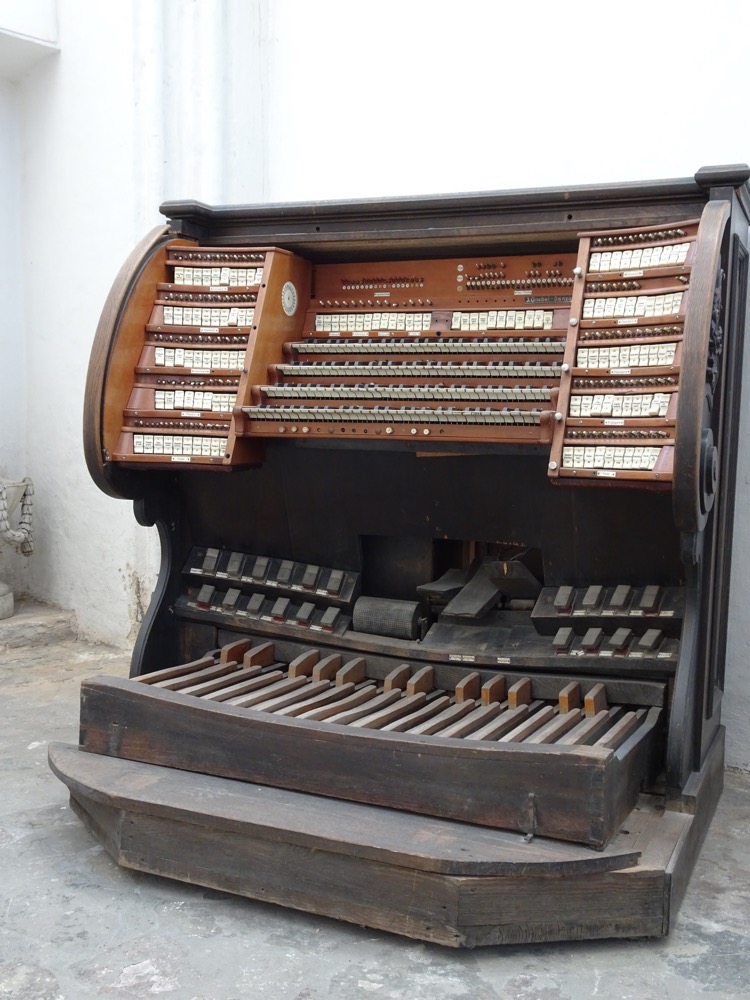

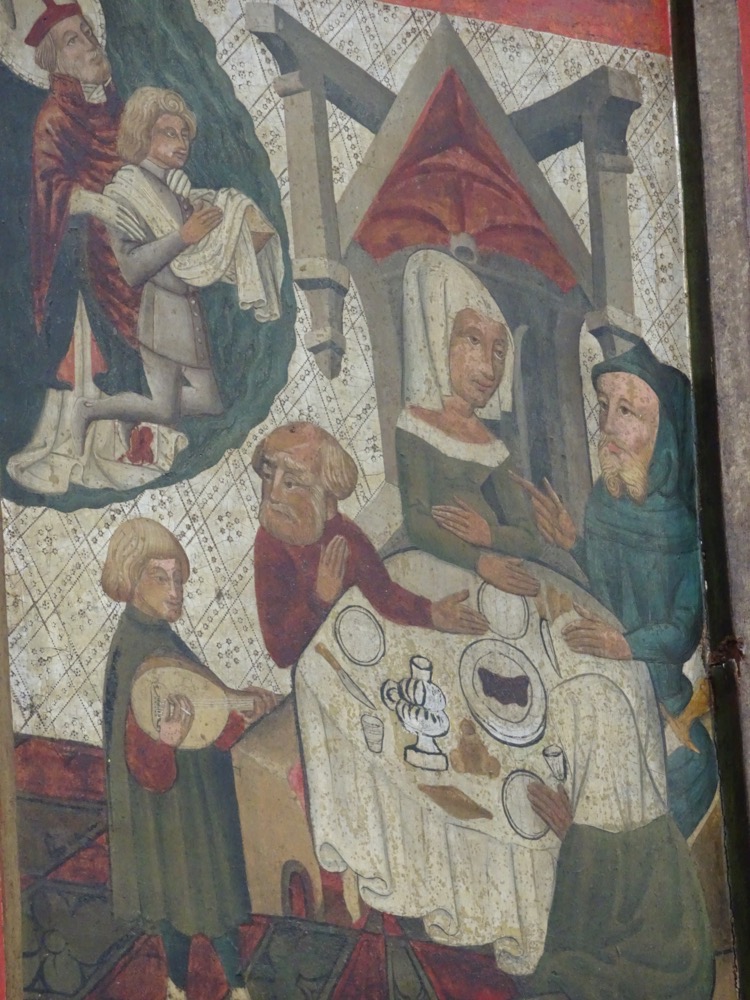
After we left the quiet enormousness of St Mary’s we went for a walk down the Long Lane which runs parallel to the Long Market and ends at the Gdańsk Great Armory.
The Great Armory in Gdańsk or The Arsenal is the most decorative secular mannerist building in the town. Towards the end of the 16th century, a growing military threat from Sweden prompted the Gdańsk burghers and merchants to prepare for war. Given there was a lack of suitable warehousing for war equipment they designed this purpose-built arsenal building. To build the arsenal, the burghers hired the most eminent architect of the era, Antony van Obberghen, because a warehouse can’t just be a warehouse, right? And work on the armoury began in 1602 to 1605. It was made of small red Dutch bricks with sandstone decorations and covered in rich gilding. It actually looks like four separate tenement houses (especially from above) but it actually one building.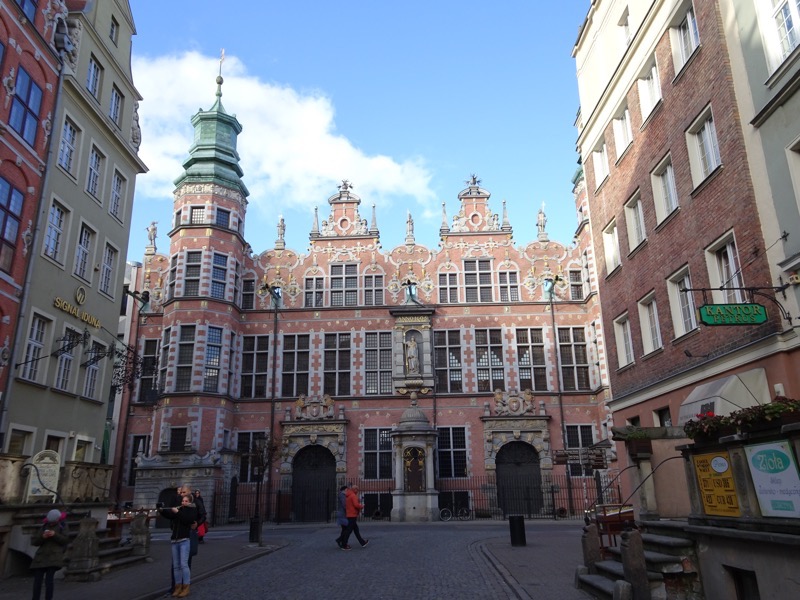
 Directly outside the armoury, the entire street is largely taken over by amber shops and by souvenir shops. You can face in any direction in this town and see amber for sale.
Directly outside the armoury, the entire street is largely taken over by amber shops and by souvenir shops. You can face in any direction in this town and see amber for sale.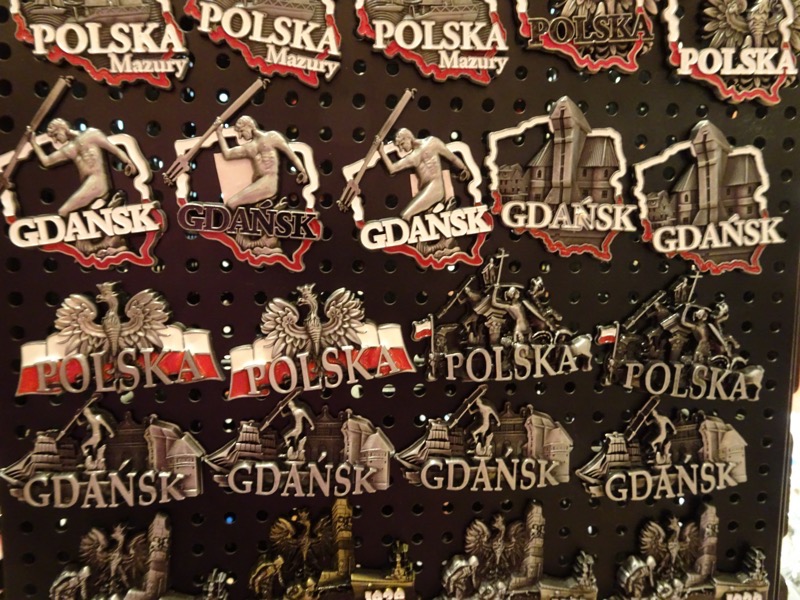
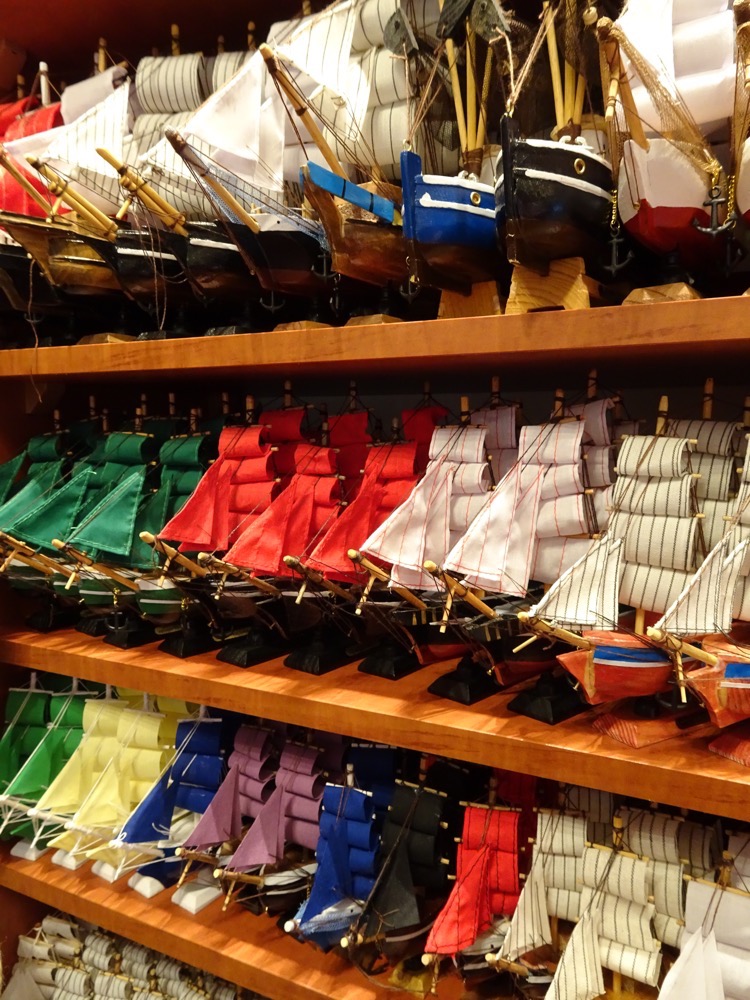
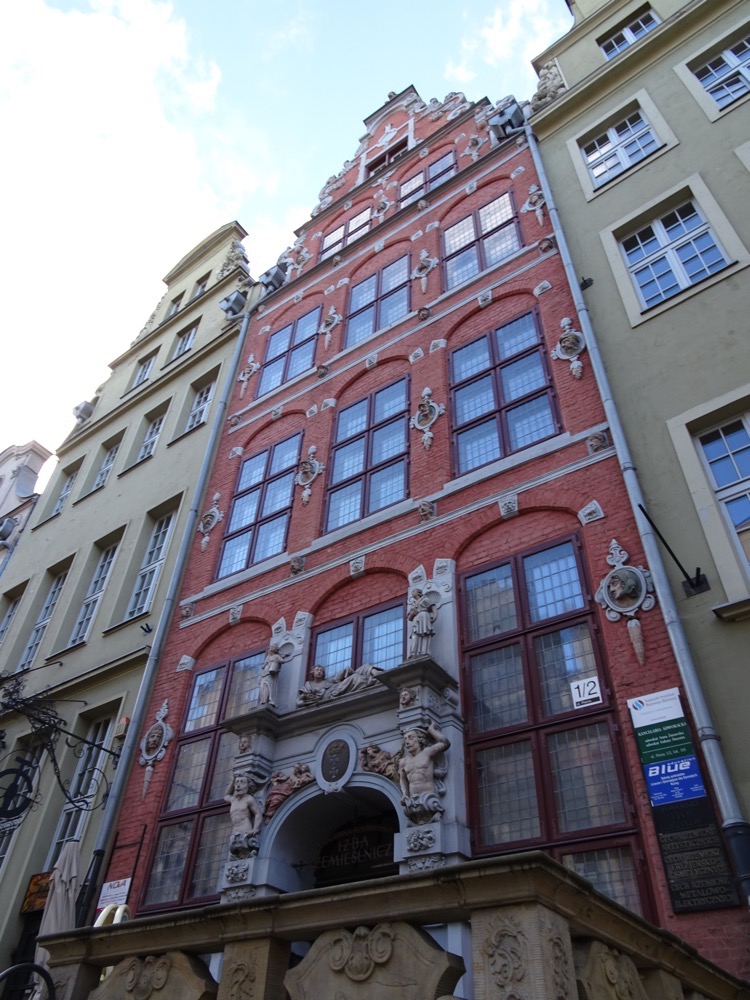
Over onto the end of the Long Market now, you can see the Golden Gate which is one of the most notable tourist attractions of the city and is located at one end of the Royal Route (the Green Gate is at the other river end). 
The Golden Gate was built in 1612–14 to replace an old 13th-century gothic gate, which formed part of the old city fortifications. Both sides of the gate have figures symbolizing the qualities of an ideal citizen. They were designed in 1648 by Jeremias Falck and then reconstructed in 1878 due to the originals being damaged by weathering and oxidising over time.
On the west side these qualities are: (in Latin, of course) On the west side of the gate, the listed qualities are (in Latin of course):
Pax (Peace)
Libertas (Freedom)
Fortuna (Wealth)
and Fama (Fame)
On the East (Long Lane) side of the gate, they have listed:
Concordia (Agreement)
Iustitia (Justice),
Pietas (Piety)
and Prudentia (Prudence).
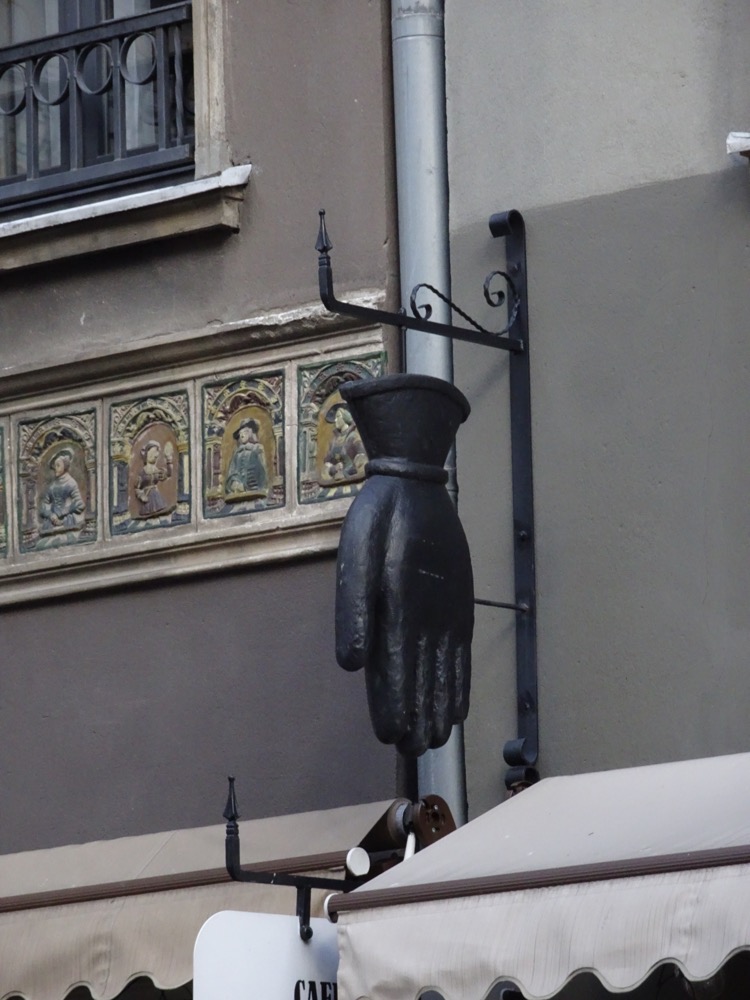 There are just too many very fancy and impressive buildings in the Long Market. I can’t describe them all, but have included many photographs to show how stunning this town is.
There are just too many very fancy and impressive buildings in the Long Market. I can’t describe them all, but have included many photographs to show how stunning this town is.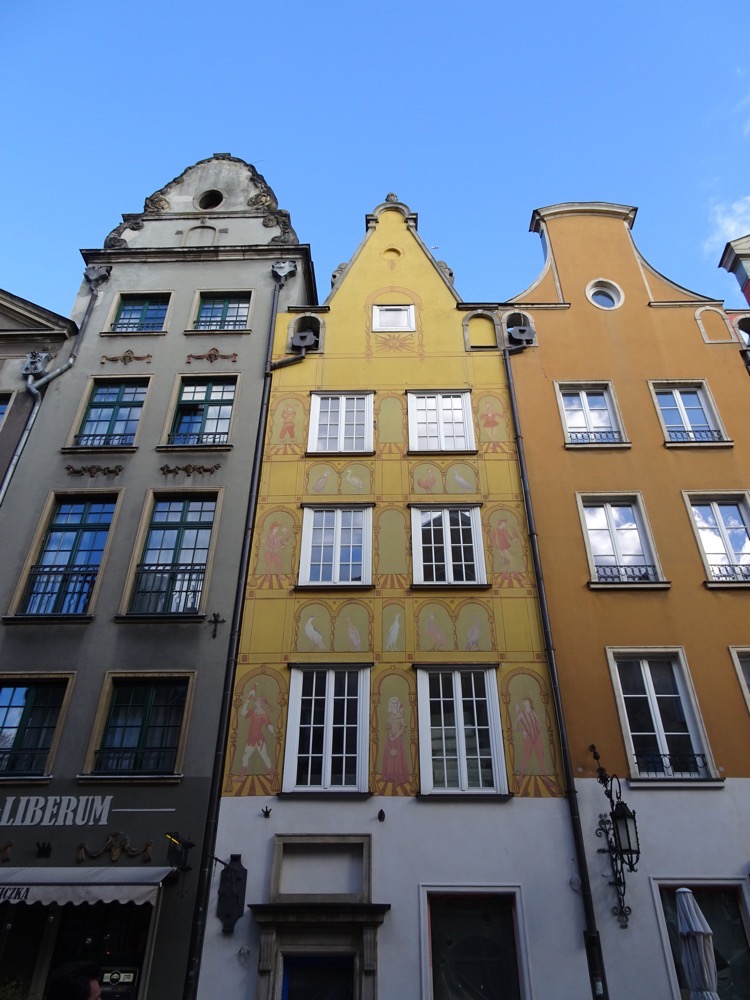
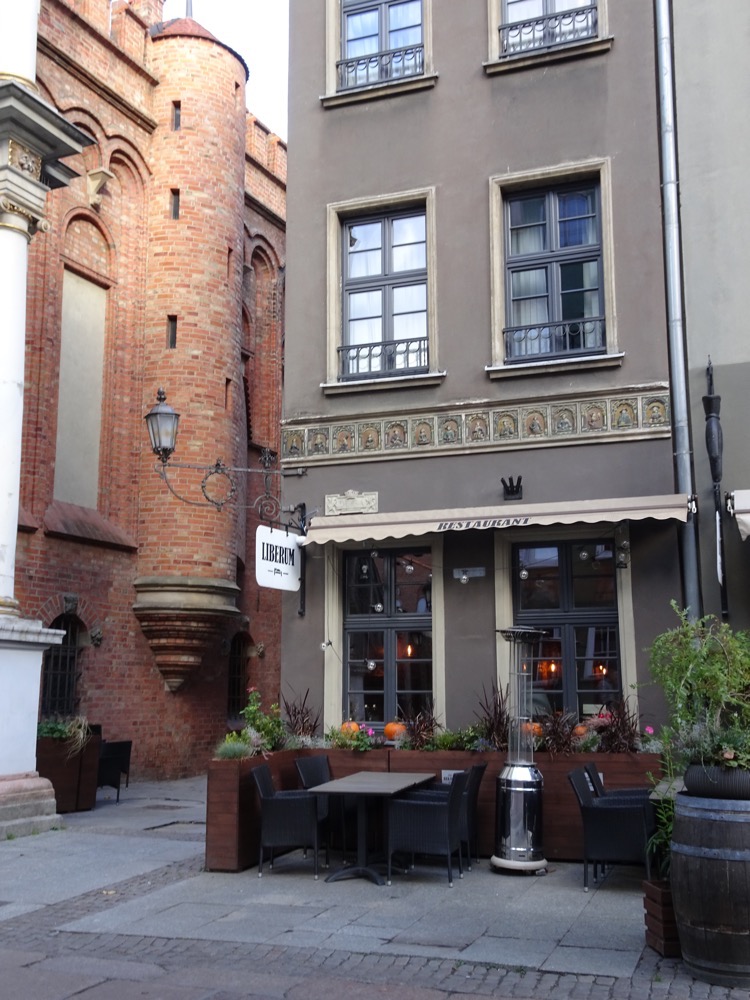
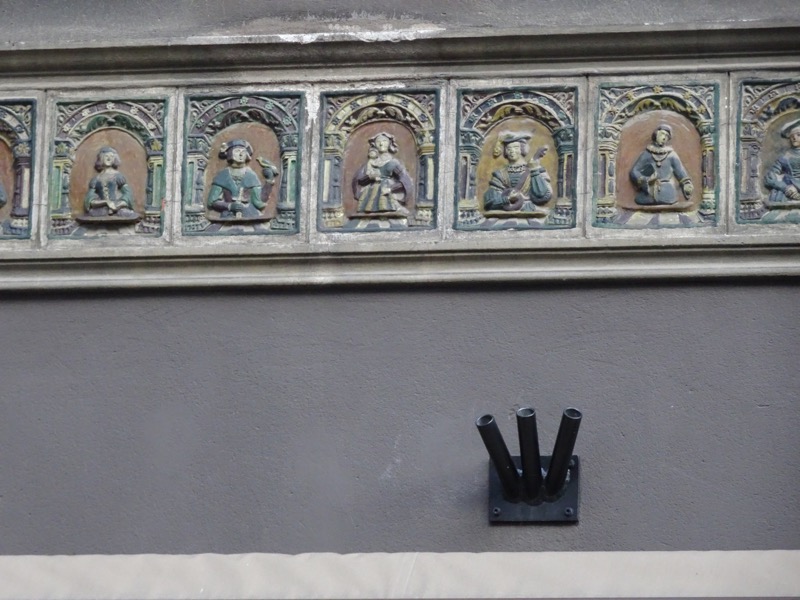 The older High Gate which is attached to the Golden Gate is a Renaissance city gate now at the main vehicular entrance to the Old Town.
The older High Gate which is attached to the Golden Gate is a Renaissance city gate now at the main vehicular entrance to the Old Town. 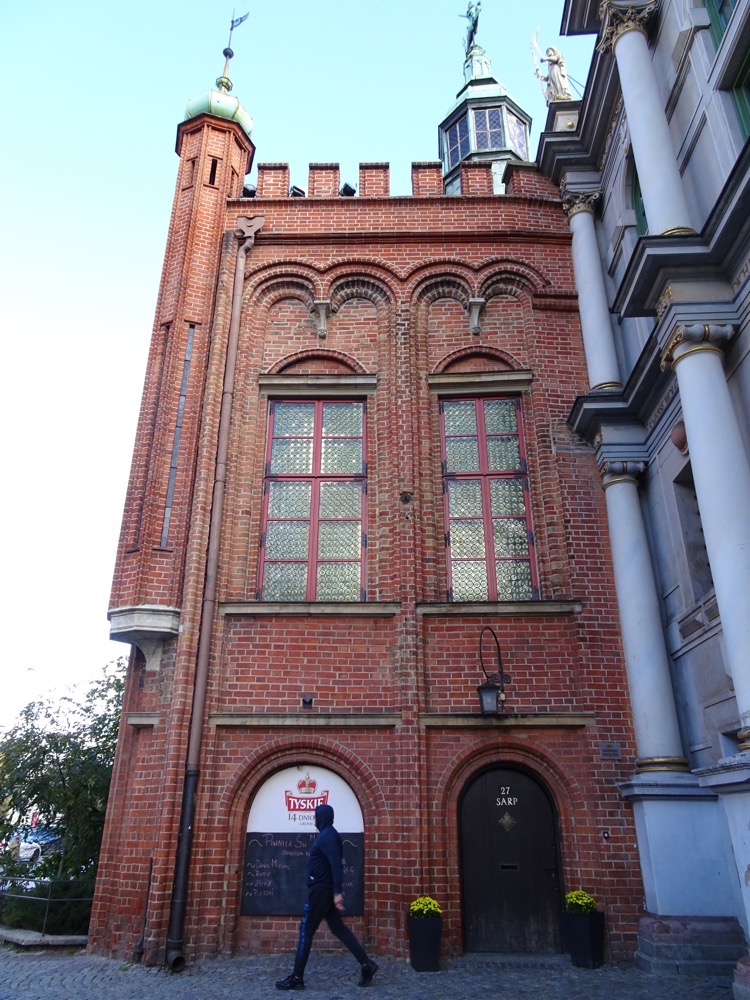
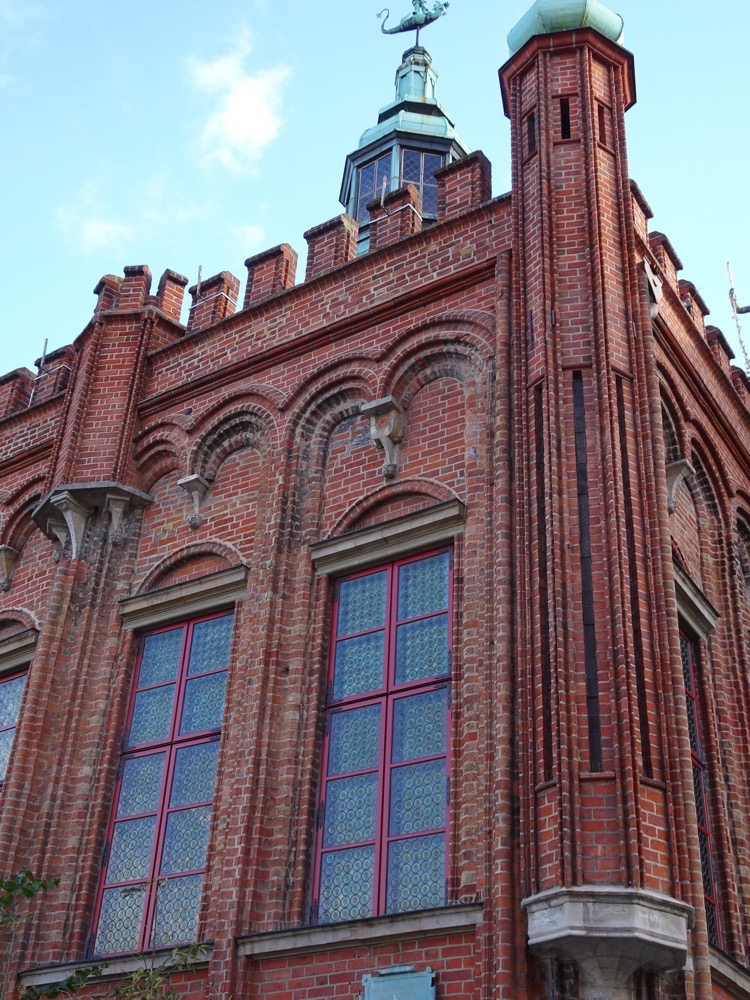
Directly opposite the High Gate and the Golden Gate is the Prison Tower. It was established as part of the medieval fortifications, and the foundations of the Prison Tower are from the beginning of the 14th century. The Tower has a long-tower with a pointed arch and a rectangular courtyard. These were built at various stages between 1379-1382 and 1416-1418. Henryk Hetzel was the architect and he allegedly erected the highest level a “donkey back”, but I can’t see it. Michał Enkinger later came along and topped the Tower with a tent roof which burned down in 1577 during the siege of Gdańsk by Stefan Batory’s army (long story omitted here).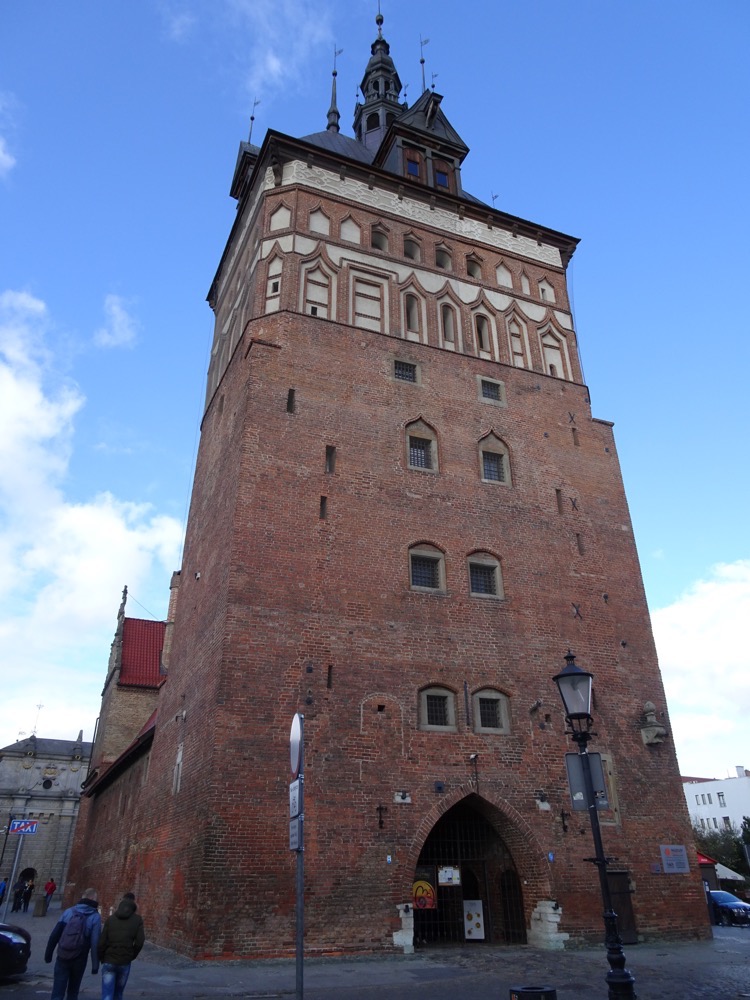 For over two centuries, from 1604 to 1858, this was the largest prison in Europe. Records show no known successful escape attempts, so we can guess it was a pretty effective one at that. Also located in the Prison Tower were Torture Chambers and the hangman’s headquarters which look like a small renaissance palace.
For over two centuries, from 1604 to 1858, this was the largest prison in Europe. Records show no known successful escape attempts, so we can guess it was a pretty effective one at that. Also located in the Prison Tower were Torture Chambers and the hangman’s headquarters which look like a small renaissance palace.
Today, the Prison Tower contains a Torture Museum (pass) and an Amber Museum (also pass), so we had a look around the medieval building but didn’t visit inside.
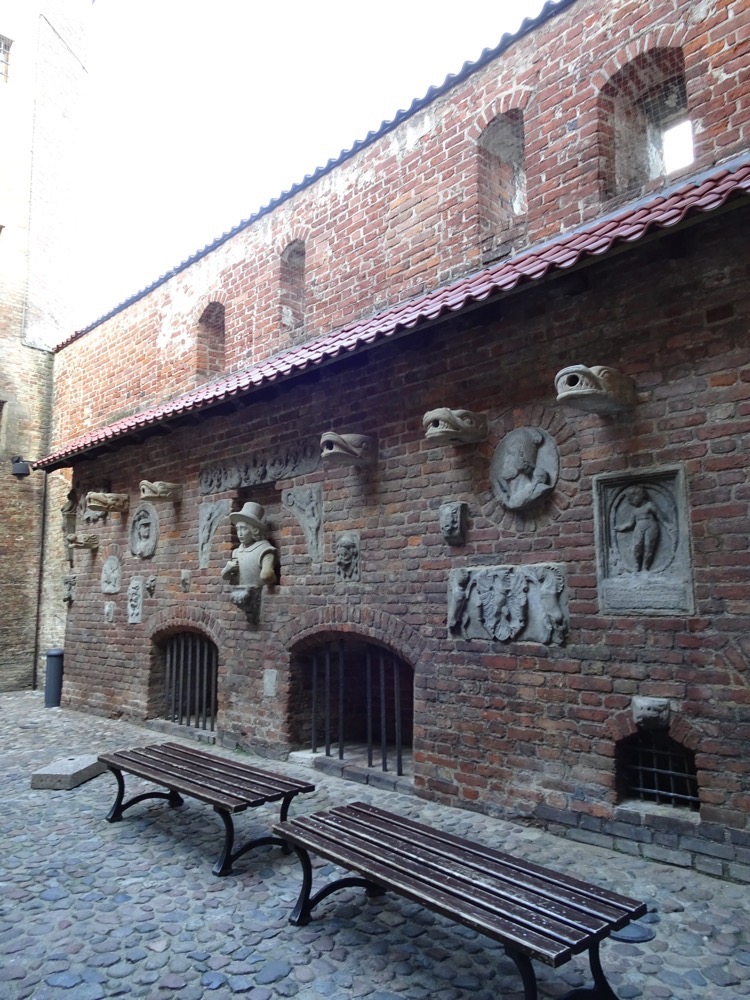
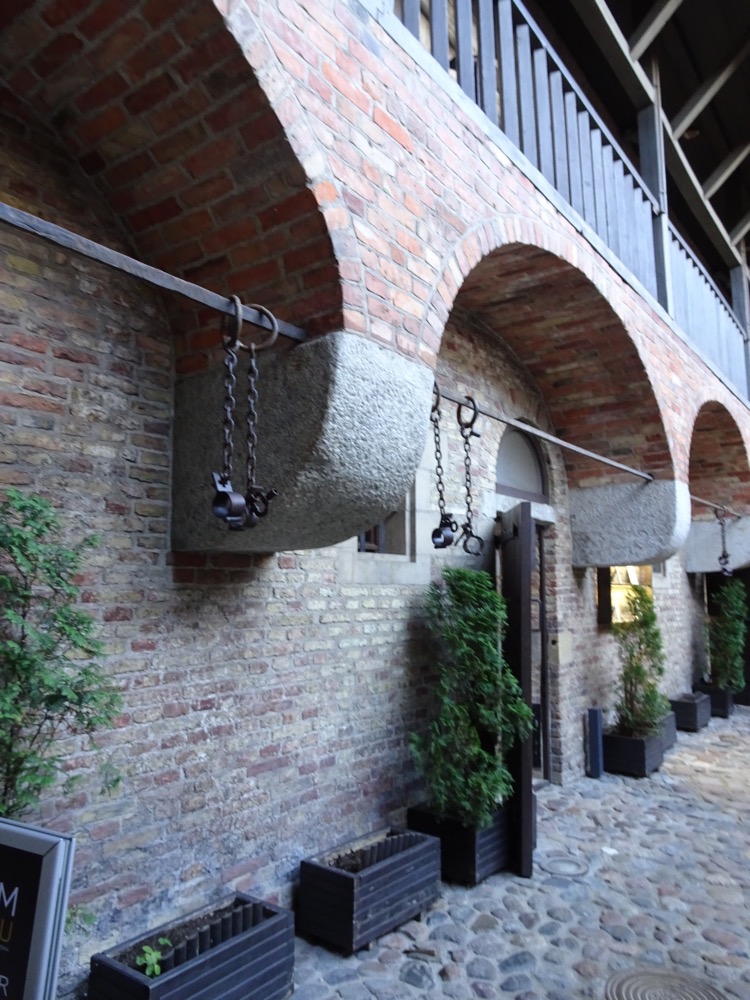

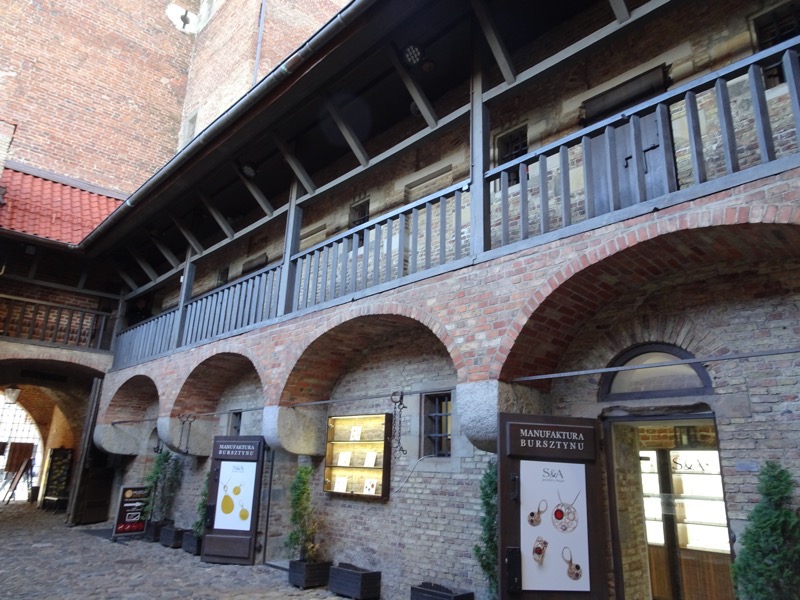

The Brama Wyżynnai gate is another gate built in 1588 gate and at one time was the main entrance to the city. It features many symbols of Gdansk, but also of Prussia & Poland. After this we went through the Golden Gate and back into the Long Market to marvel at the beautiful tennement buildings.
After this we went through the Golden Gate and back into the Long Market to marvel at the beautiful tennement buildings. The Gdańsk Main Town Hall is a historic building located in the middle of the Long Market and it is considered to be one of the best the Gothic-Renaissance style historic buildings in the city. It is built at the intersection of the Long Lane and Long Market, and currently houses the History Museum of the City of Gdańsk and a weird modern art exhibition of Kazakhstani photographers?!
The Gdańsk Main Town Hall is a historic building located in the middle of the Long Market and it is considered to be one of the best the Gothic-Renaissance style historic buildings in the city. It is built at the intersection of the Long Lane and Long Market, and currently houses the History Museum of the City of Gdańsk and a weird modern art exhibition of Kazakhstani photographers?! 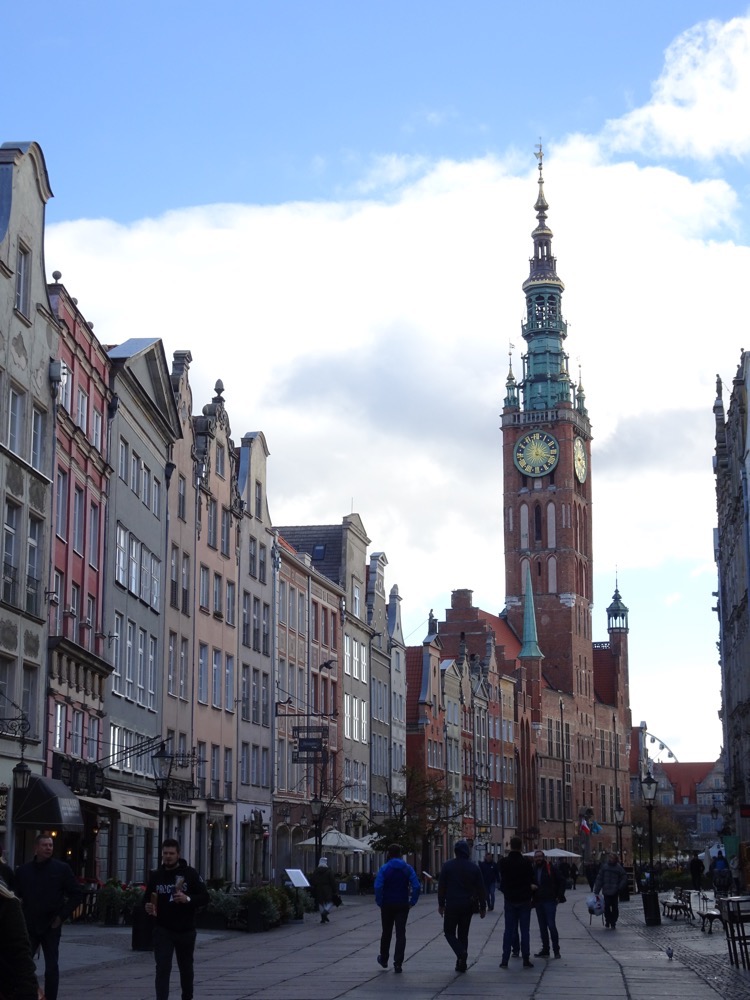
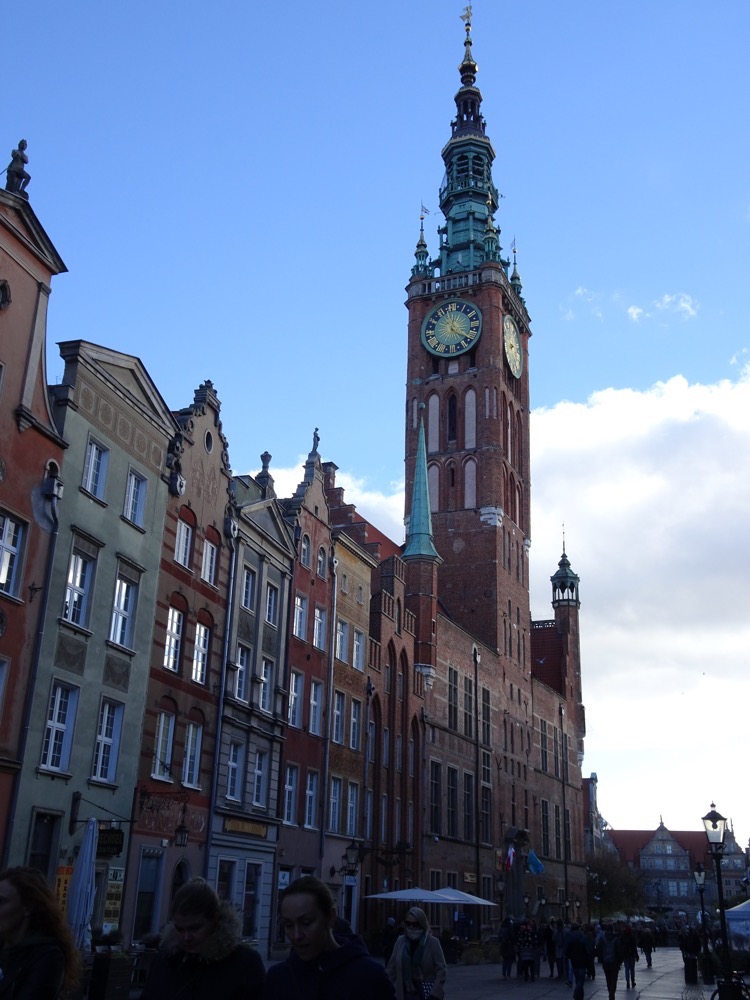
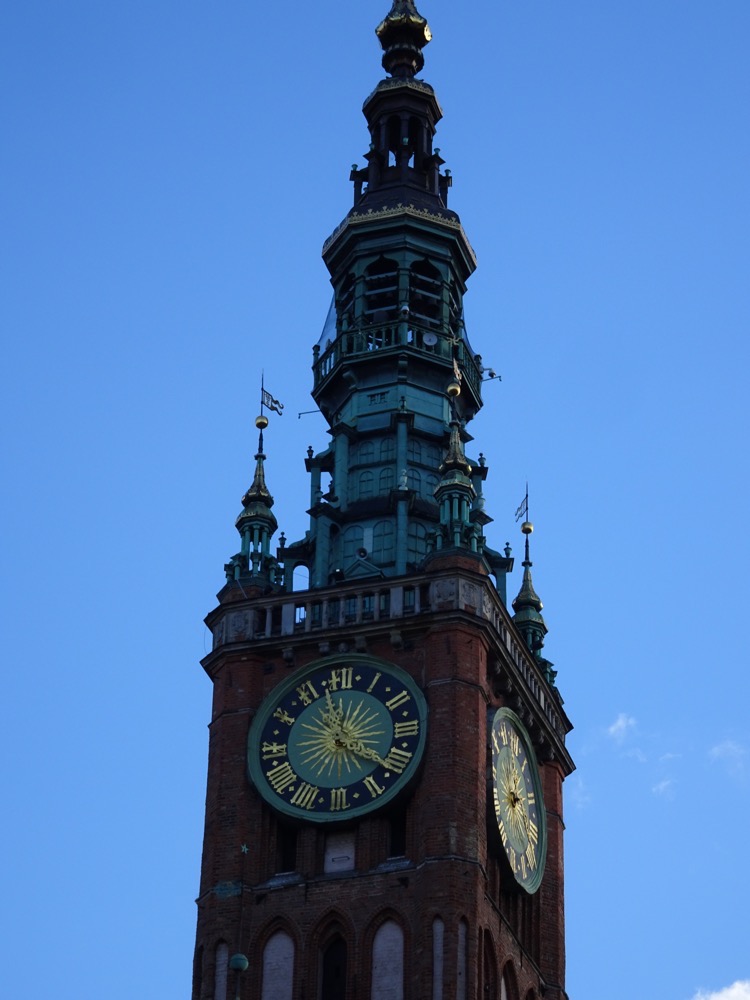 So many of these beautiful tenement houses have a long and distinguished history all of their own – for example, this red building below is called, the Schumann House. It was designed and built for a man named, Hans Conert the Younger, by an unknown architect in around 1560. The building was known as the King’s House as the top of the house has a sculpture of Zeus. Now, it houses a Tourist Information Centre… but my point is, every one of these buildings has a history.
So many of these beautiful tenement houses have a long and distinguished history all of their own – for example, this red building below is called, the Schumann House. It was designed and built for a man named, Hans Conert the Younger, by an unknown architect in around 1560. The building was known as the King’s House as the top of the house has a sculpture of Zeus. Now, it houses a Tourist Information Centre… but my point is, every one of these buildings has a history.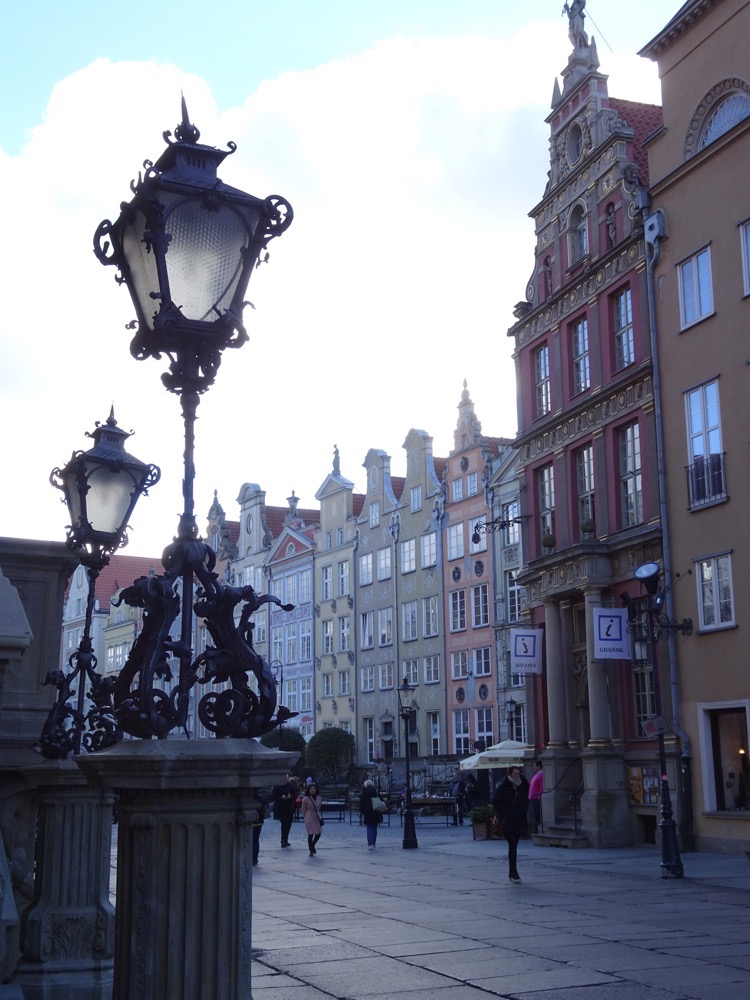 It’s nearly midday and the tourists are finally up and about – I am very glad I came out earlier and took some photos of the empty streets.
It’s nearly midday and the tourists are finally up and about – I am very glad I came out earlier and took some photos of the empty streets.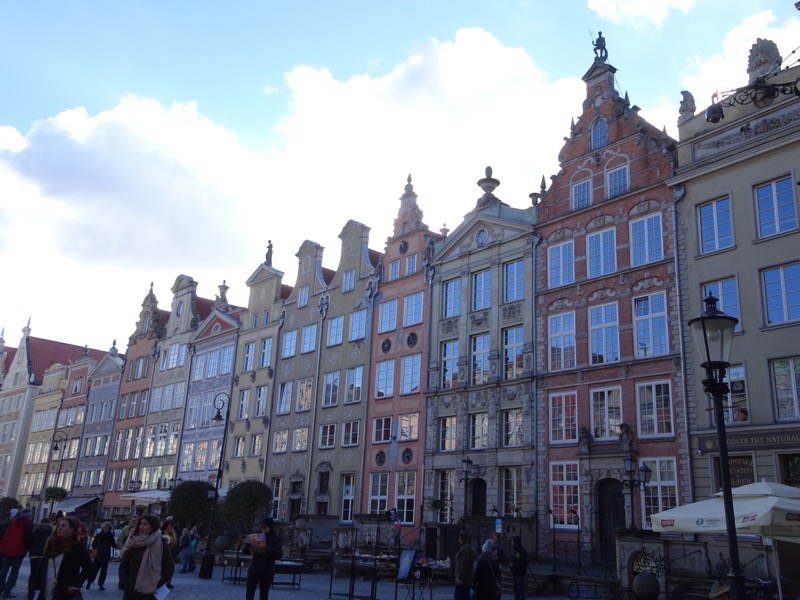

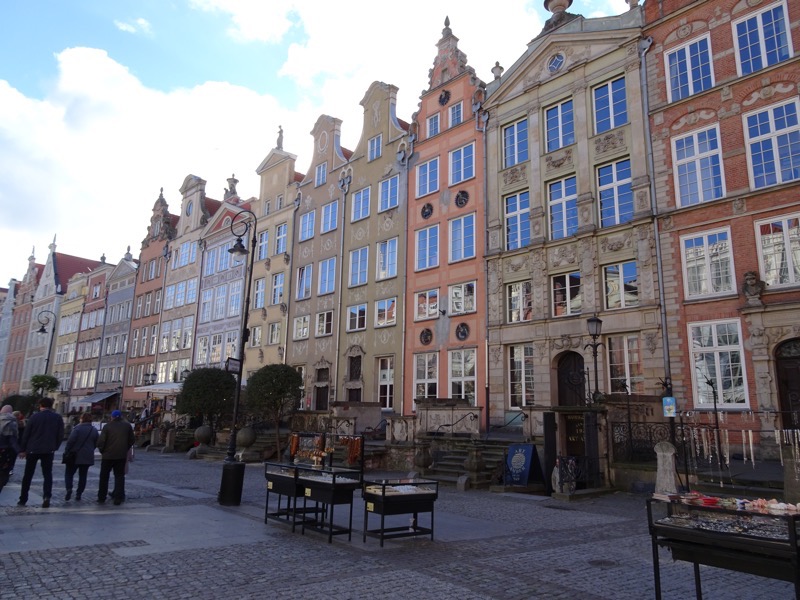
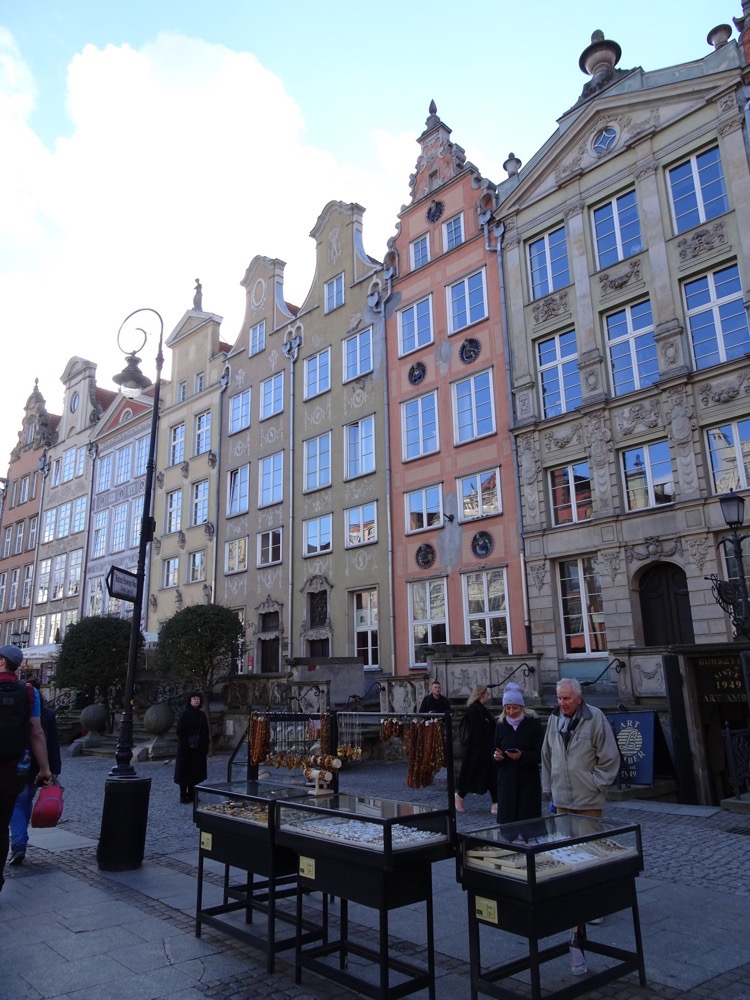
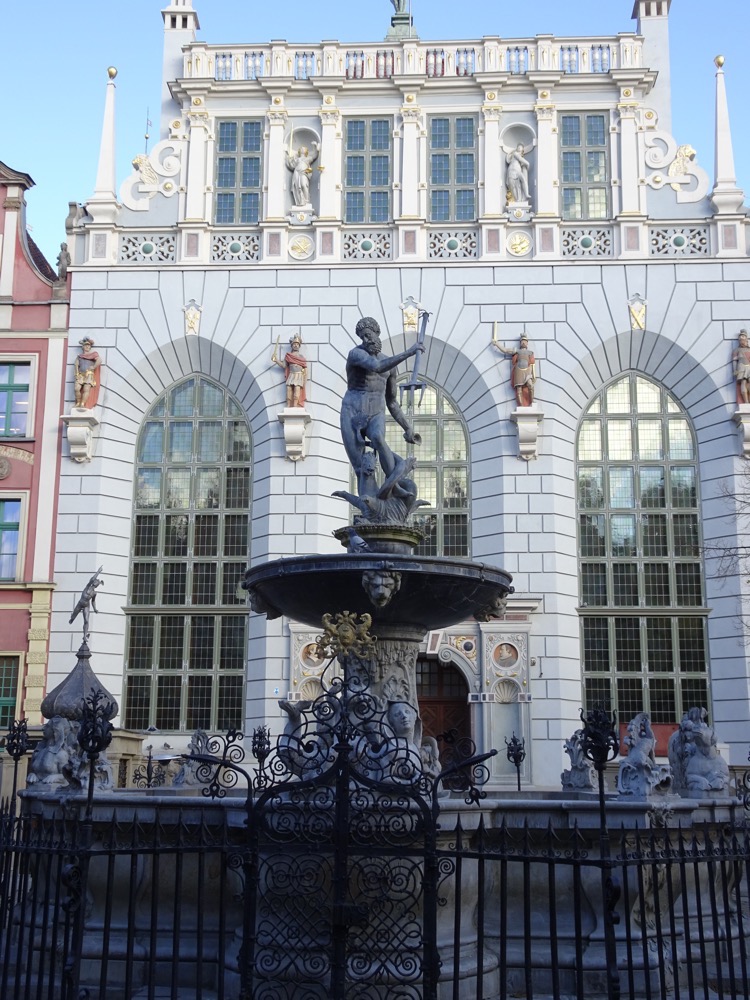 Neptune’s Fountain – is an iconic fountain of Gdańsk. It was constructed by a local Mayor, Bartłomiej Schachmann in 1549 and is located outside a building called Artus Court because there was a natural well here. The fountain was proposed and approved in 1549 but didn’t ‘open’ until 1633 due to a series of construction delays – the Artus Court building was being renovated, there were problems with the water system, and then the terribly inconvenient Thirty Years’ War.
Neptune’s Fountain – is an iconic fountain of Gdańsk. It was constructed by a local Mayor, Bartłomiej Schachmann in 1549 and is located outside a building called Artus Court because there was a natural well here. The fountain was proposed and approved in 1549 but didn’t ‘open’ until 1633 due to a series of construction delays – the Artus Court building was being renovated, there were problems with the water system, and then the terribly inconvenient Thirty Years’ War.
The fountain was renovated in 1927, the fountain was renovated but got badly damaged during World War II, so they moved it to Parchów, and didn’t return it to its place until July 1957. It was renovated again in 1988, and again in September 2011 and April 2012… seems these things are pretty high maintenance.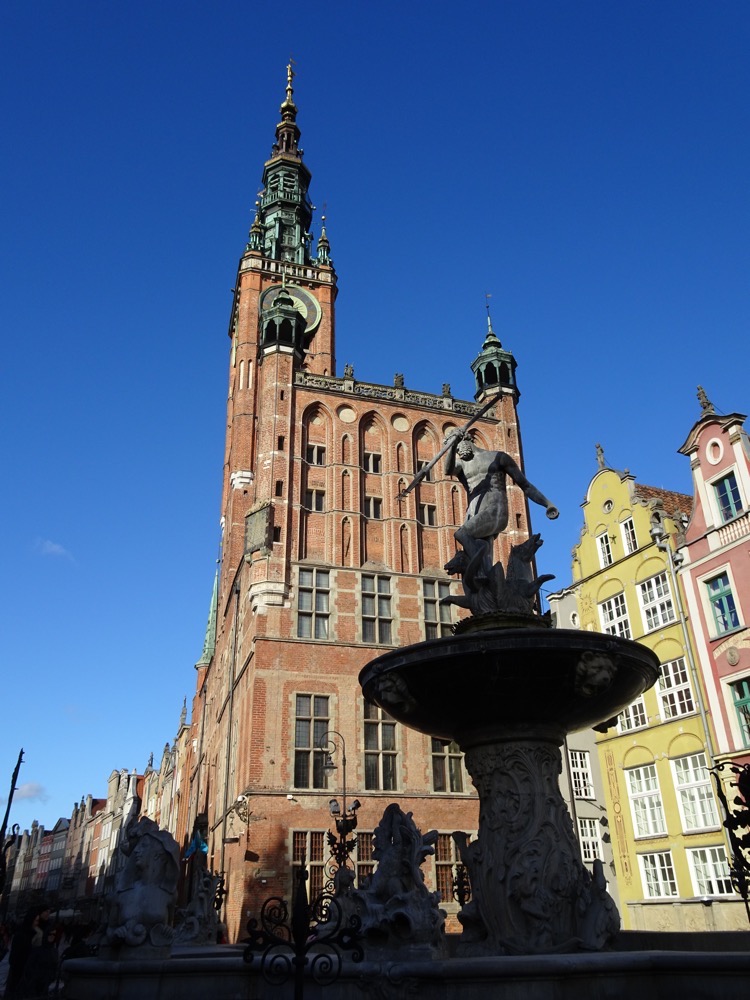
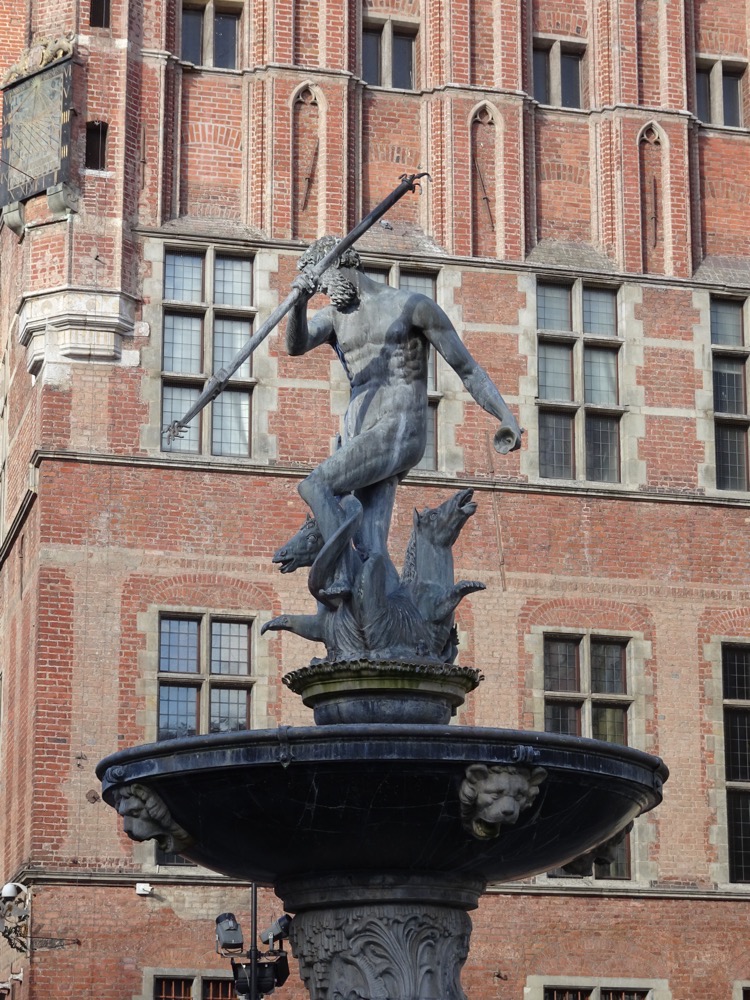
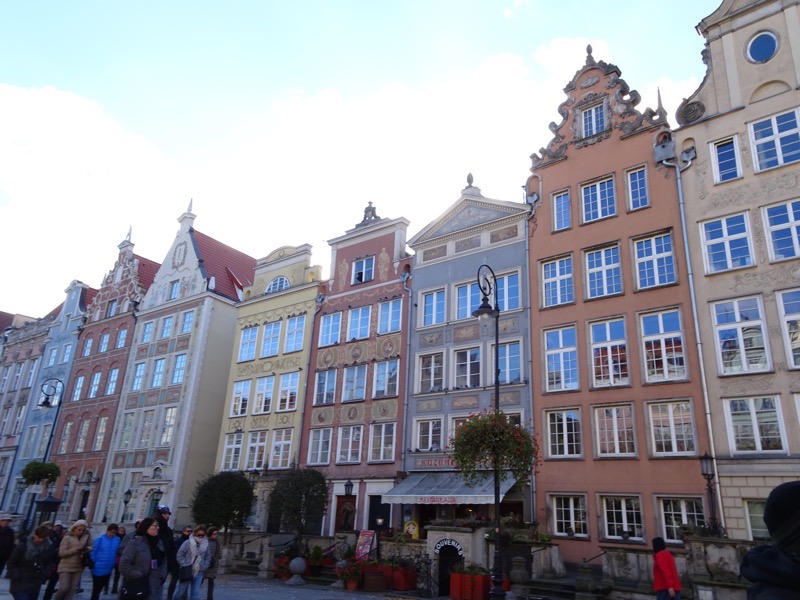 At the other end of the Long Market – the back of the Green Gate.
At the other end of the Long Market – the back of the Green Gate.
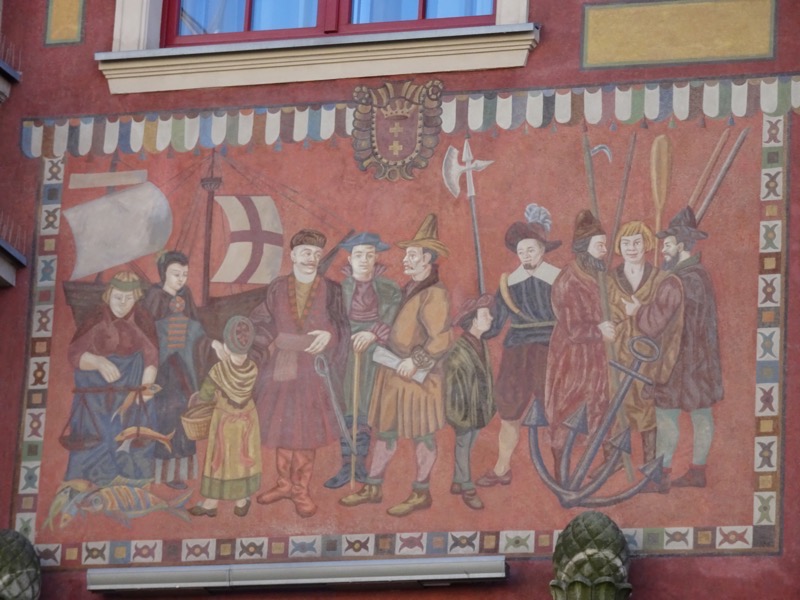 So many beautiful buildings! It’s simply overwhelming… so many beautiful facades to look at and so many wonderfully detailed frontages.
So many beautiful buildings! It’s simply overwhelming… so many beautiful facades to look at and so many wonderfully detailed frontages.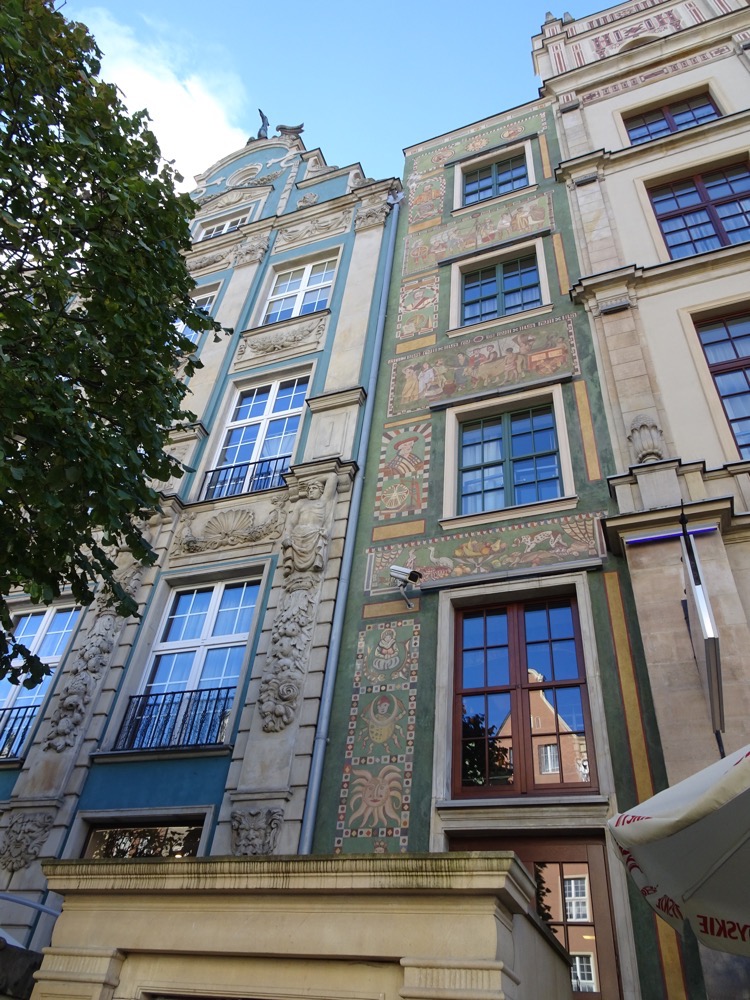
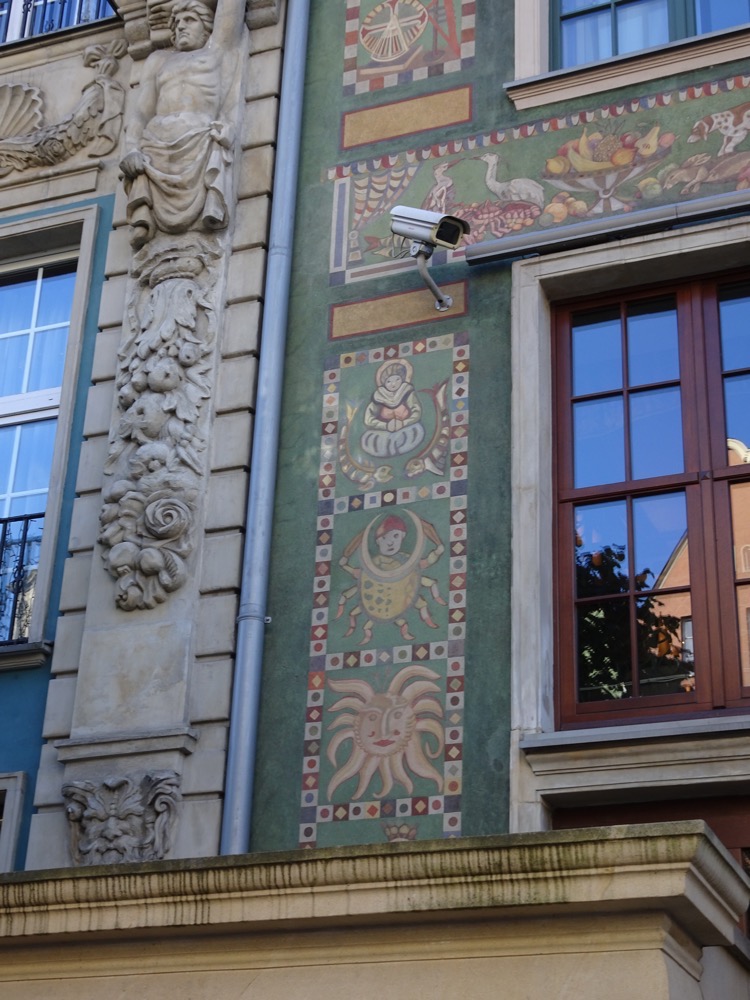
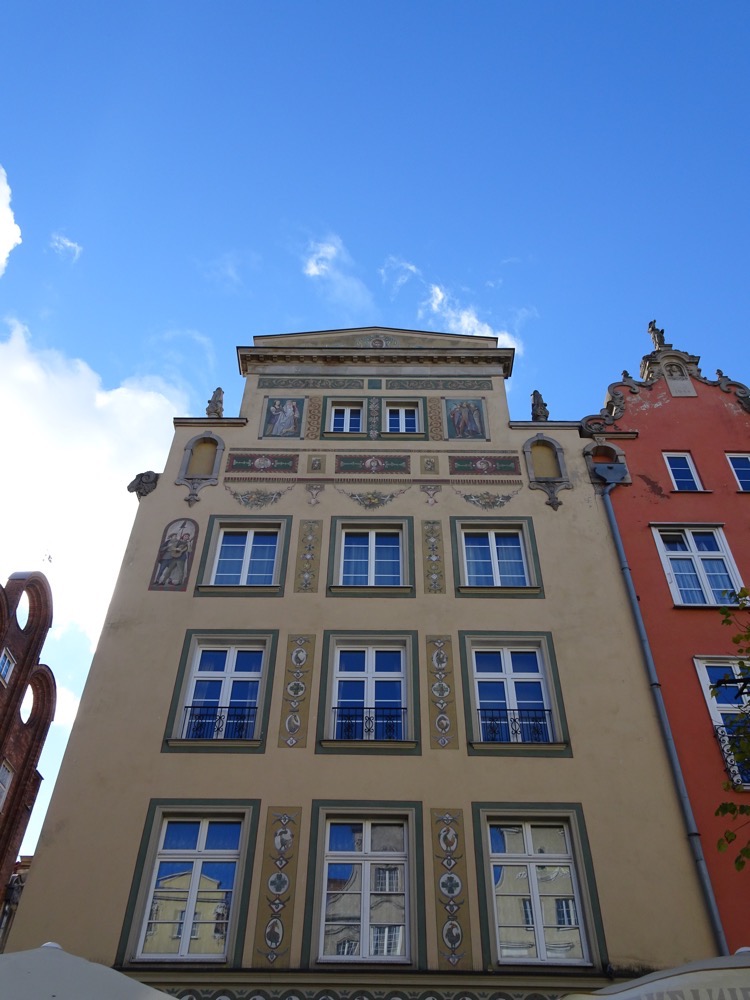
The Green Gate is on the river end of the Long Market and marks the start of the Royal Route. 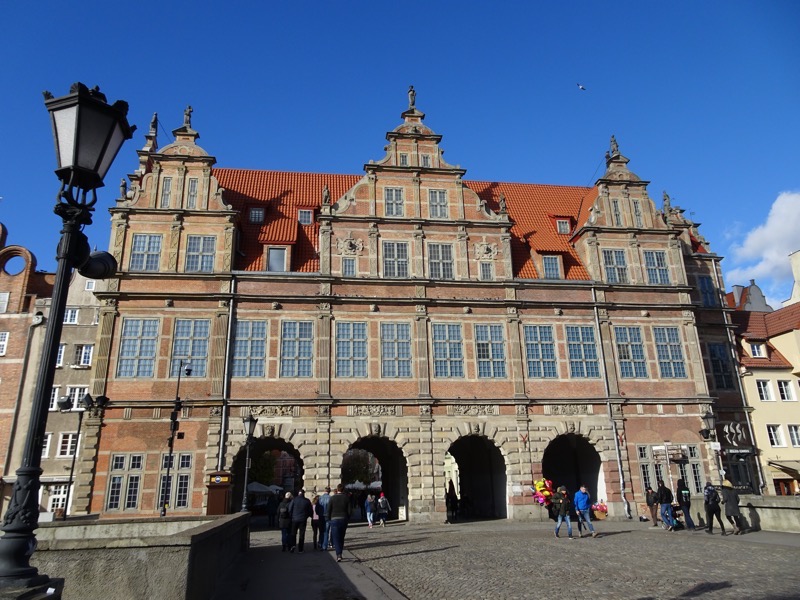
The Green Gate was apparently inspired by the Antwerp City Hall building and was built in 1568-71 as a residence for the Polish Monarchy. It was commissioned from the master architect, Regnier (or Reiner van Amsterdam), and bring some Flemish architectural influence to Gdańsk.
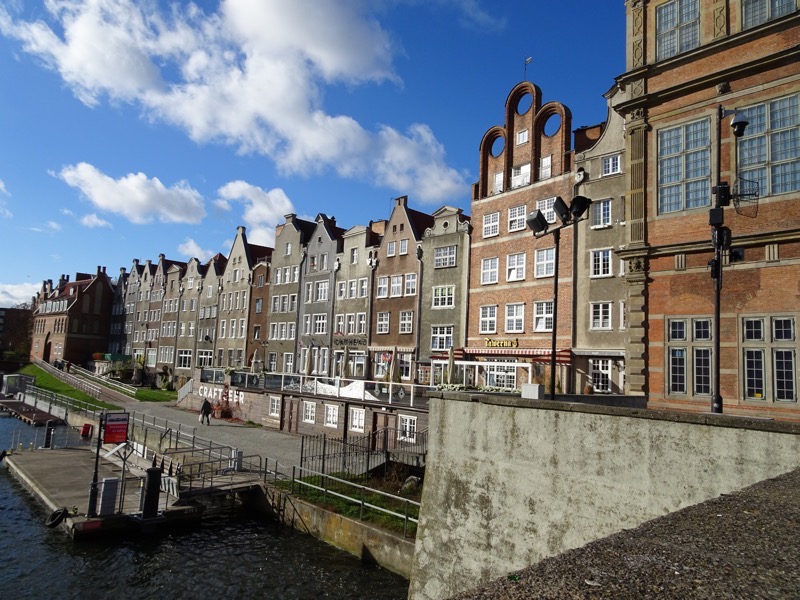 More tenement buildings lining the river to either side of the Green Gate.
More tenement buildings lining the river to either side of the Green Gate. Across the river is Granary Island – we popped over there very briefly, but it seemed full of modern hotels, a ferris wheel (called the Amber Sky of course) and several bars that appeared to largely cater to American tourists (Jack Lives Here).
Across the river is Granary Island – we popped over there very briefly, but it seemed full of modern hotels, a ferris wheel (called the Amber Sky of course) and several bars that appeared to largely cater to American tourists (Jack Lives Here).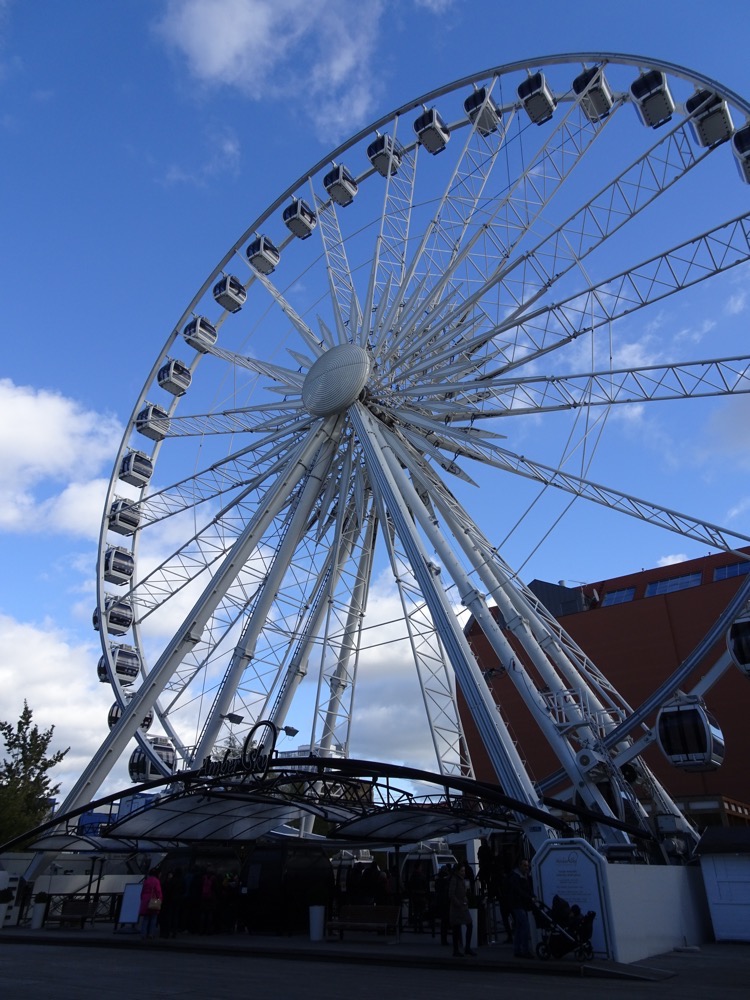
 So we made our way along the waterfront and back into the Old Town to meander through more back streets.
So we made our way along the waterfront and back into the Old Town to meander through more back streets.
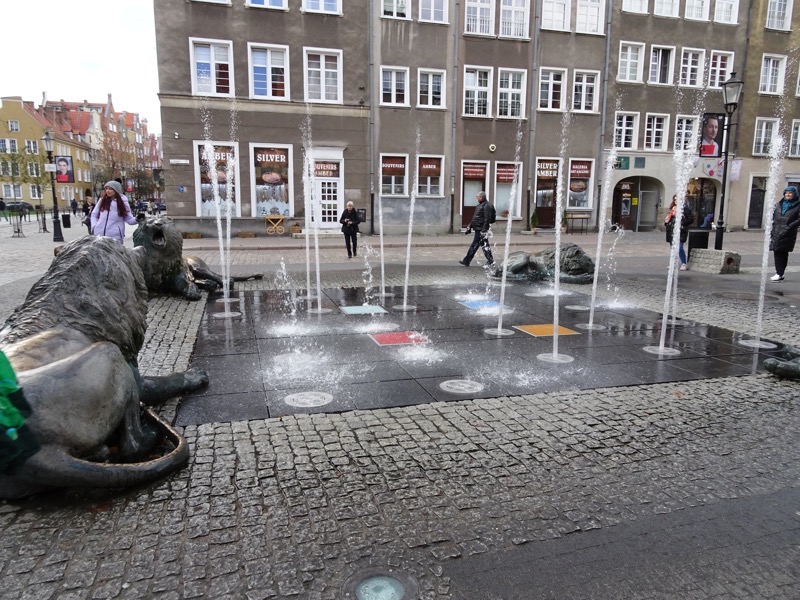
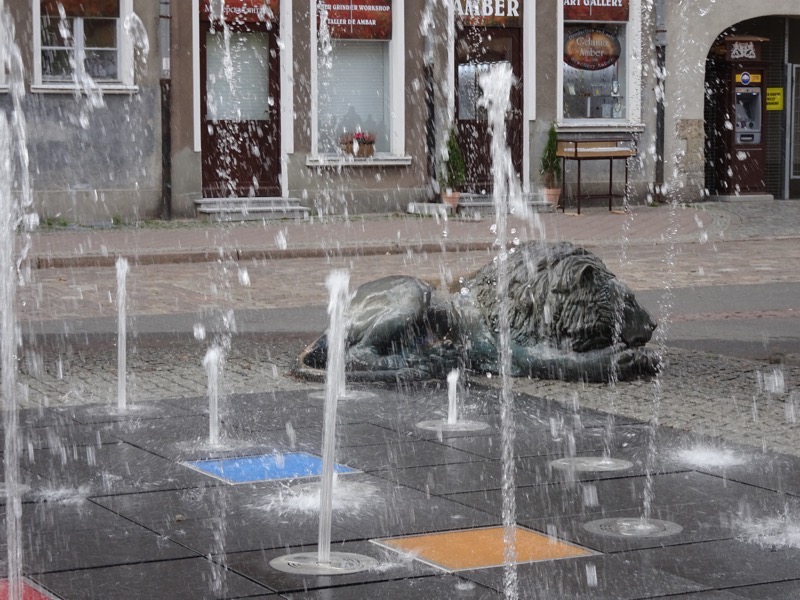 The seemingly modest, Royal Chapel.
The seemingly modest, Royal Chapel.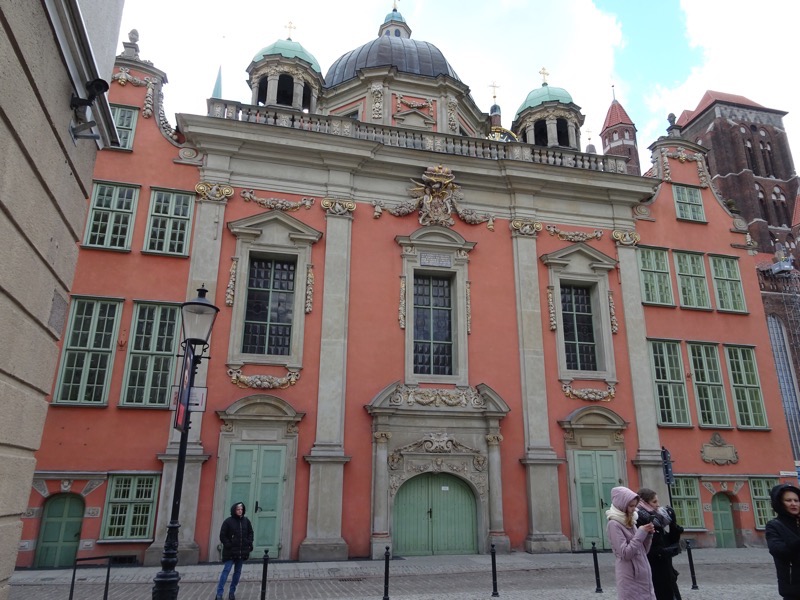 The famous Gdansk treadwheel crane – originally built in 1366, the crane was operated by men in the treadwheel to hoist heavy weights onto ships.
The famous Gdansk treadwheel crane – originally built in 1366, the crane was operated by men in the treadwheel to hoist heavy weights onto ships.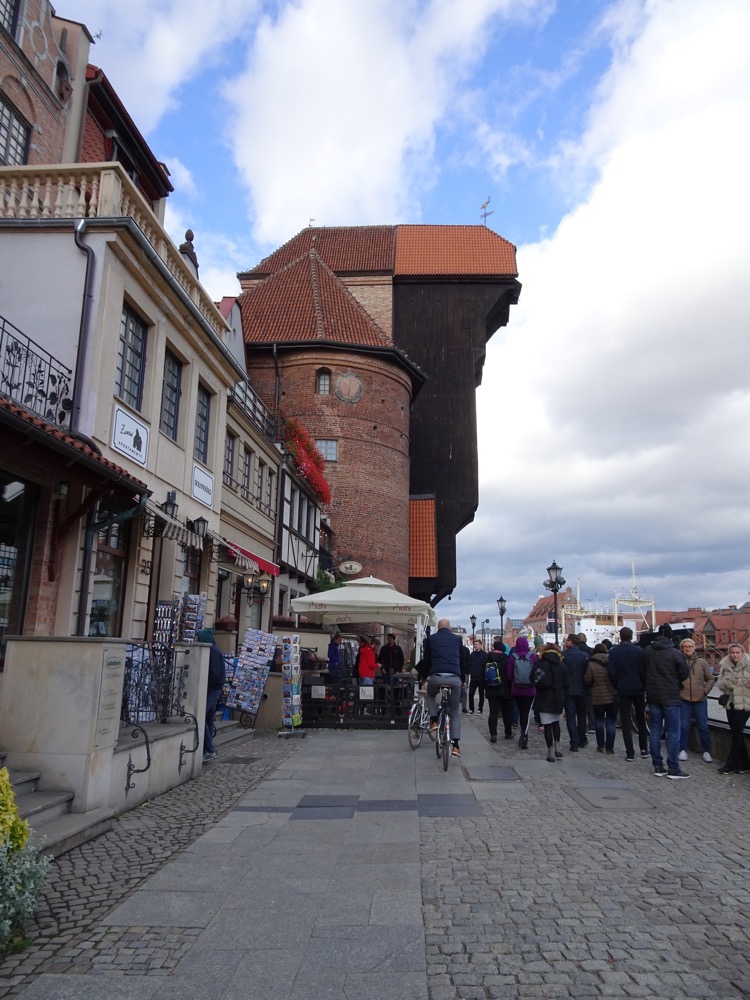
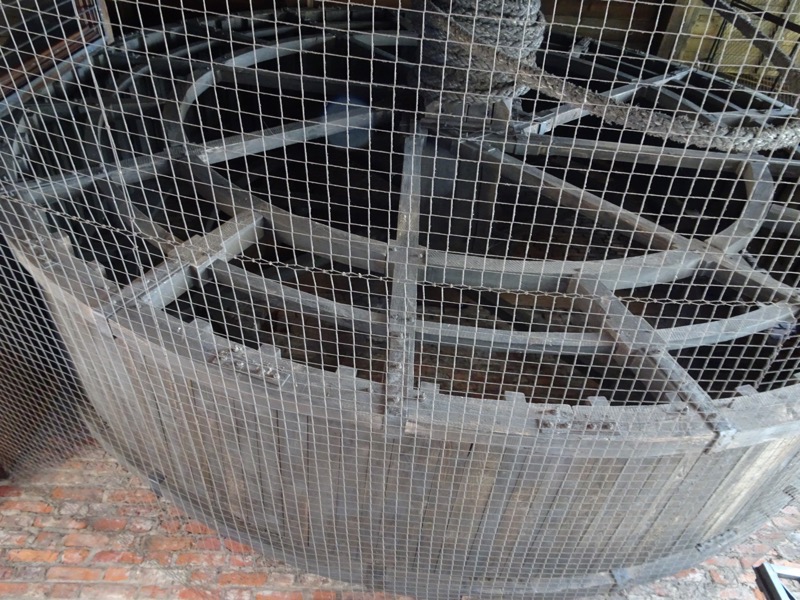
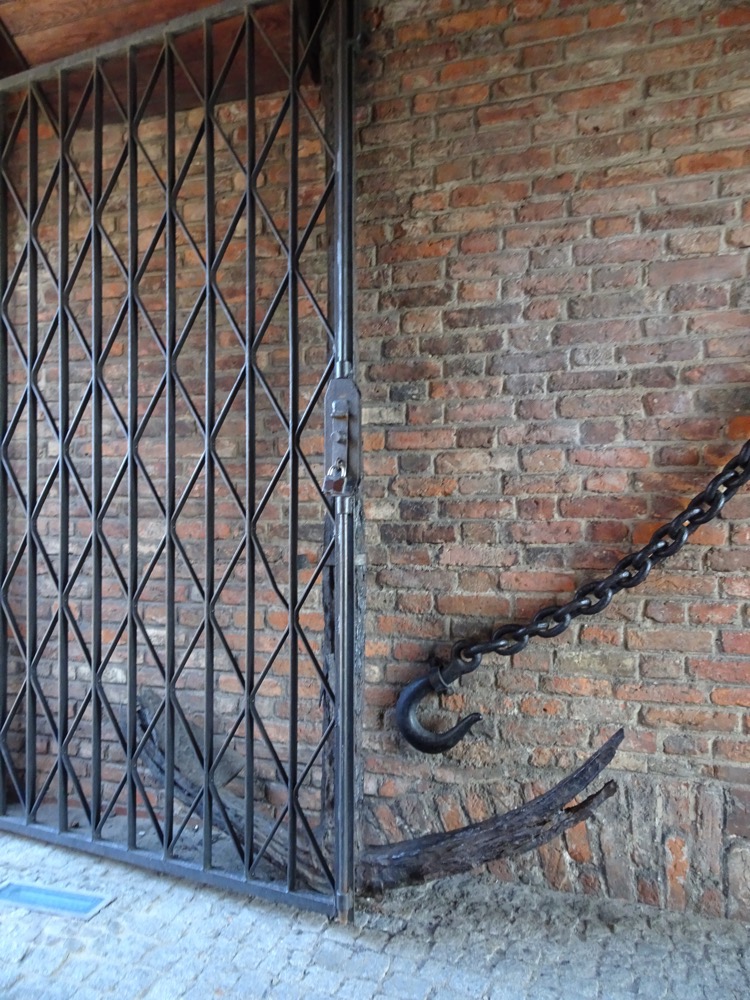
Right beside the riverside and the Treadwheel Crane is the Gdansk Archeological Museum. We had a nice visit in the museum, though there were absolutely zero plaques in English telling us what we were looking at. So I’m guessing your educated guesses are as good as mine on these artefacts.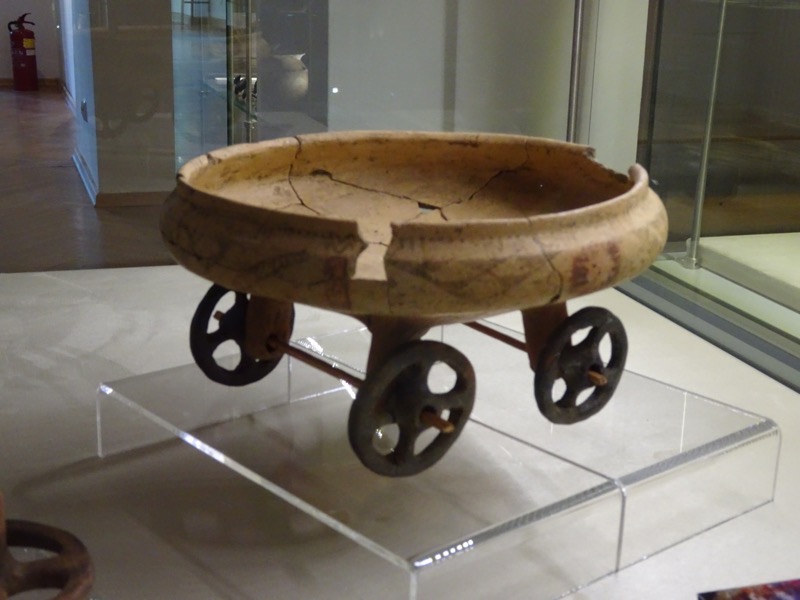
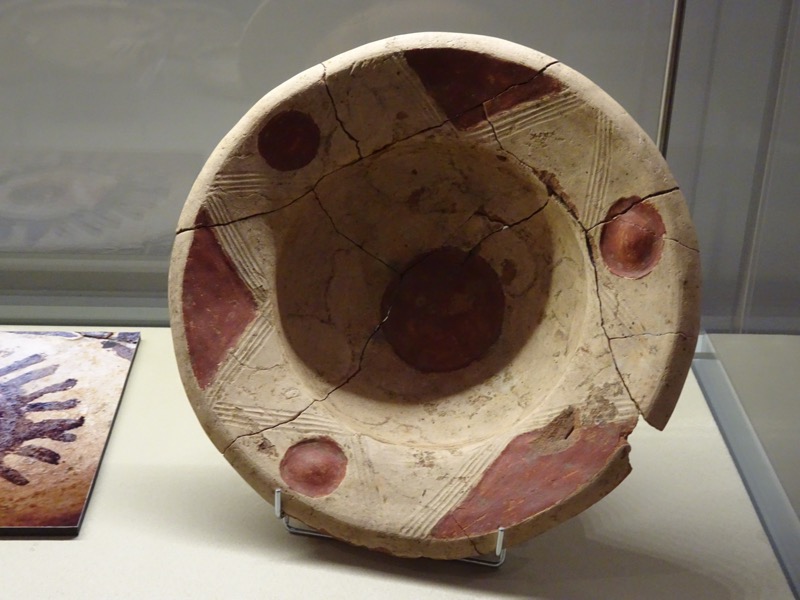
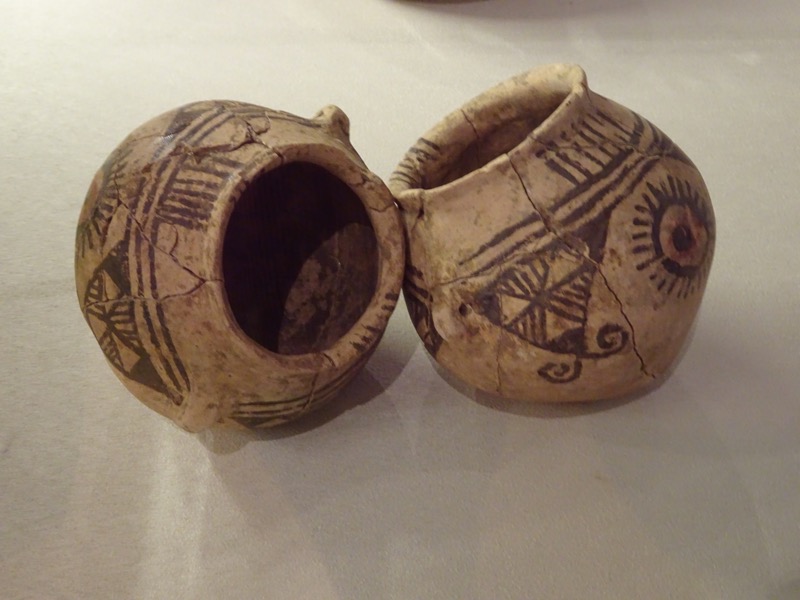
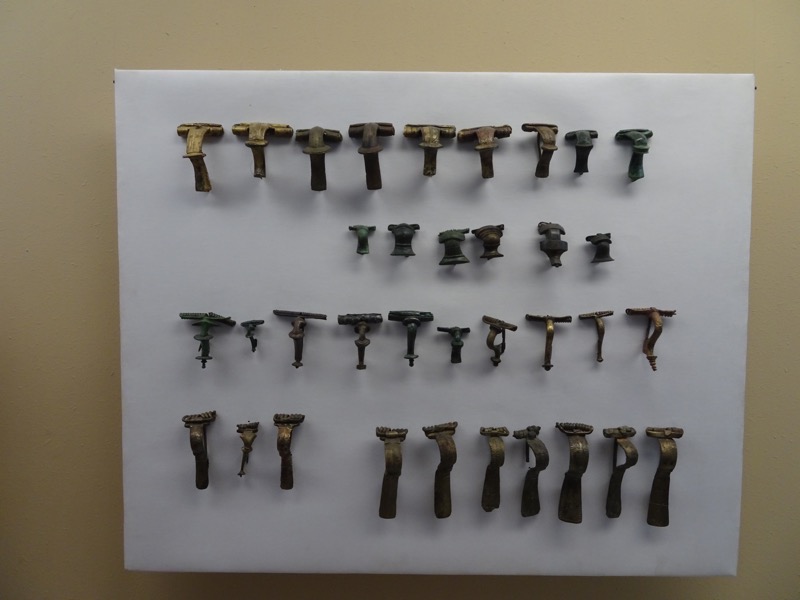
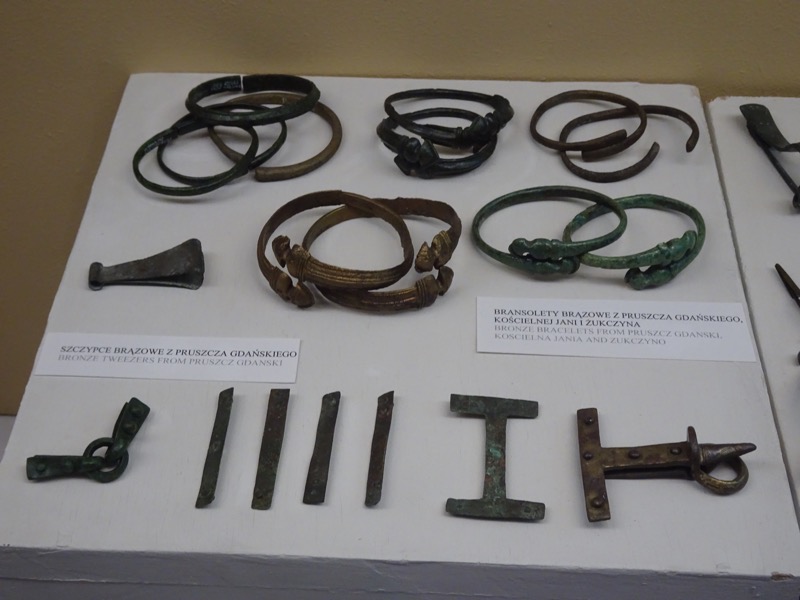
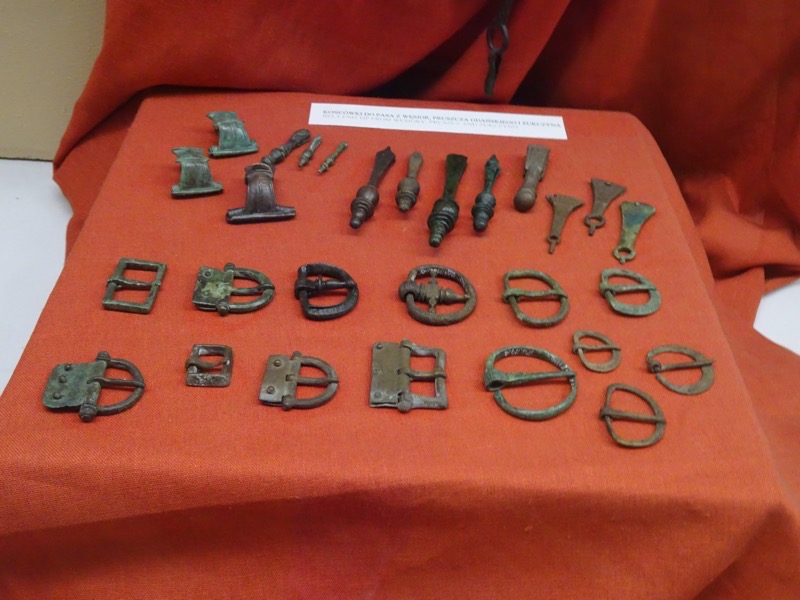
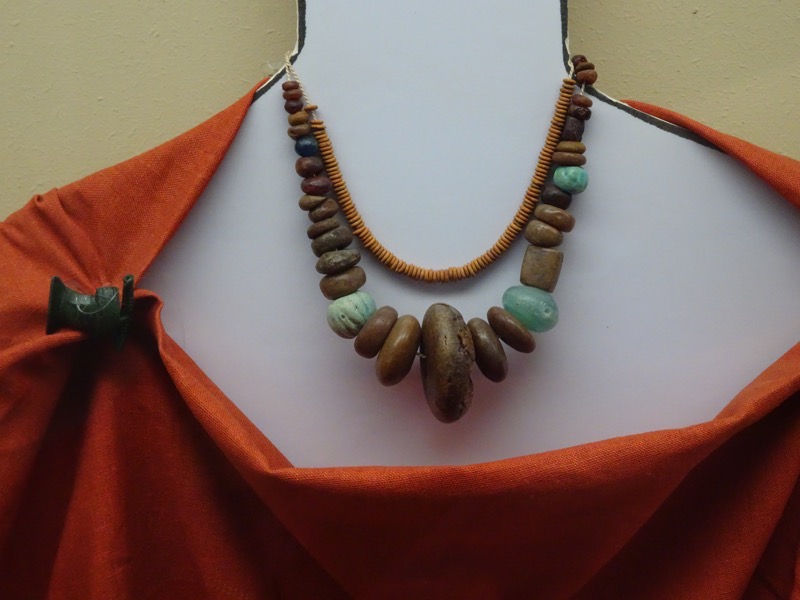


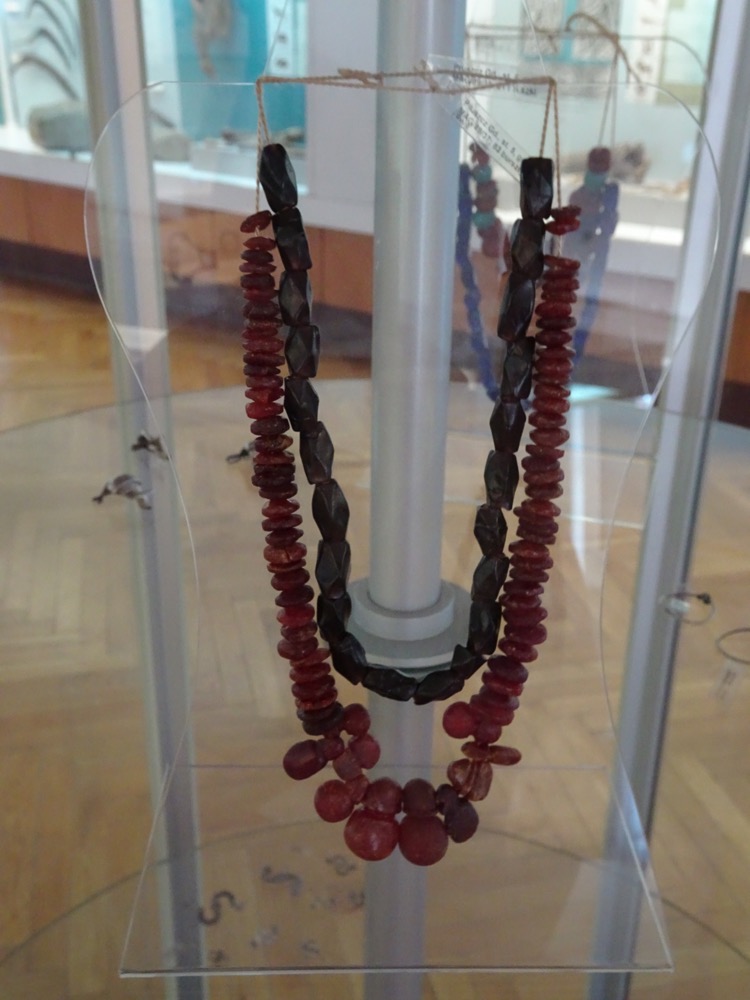
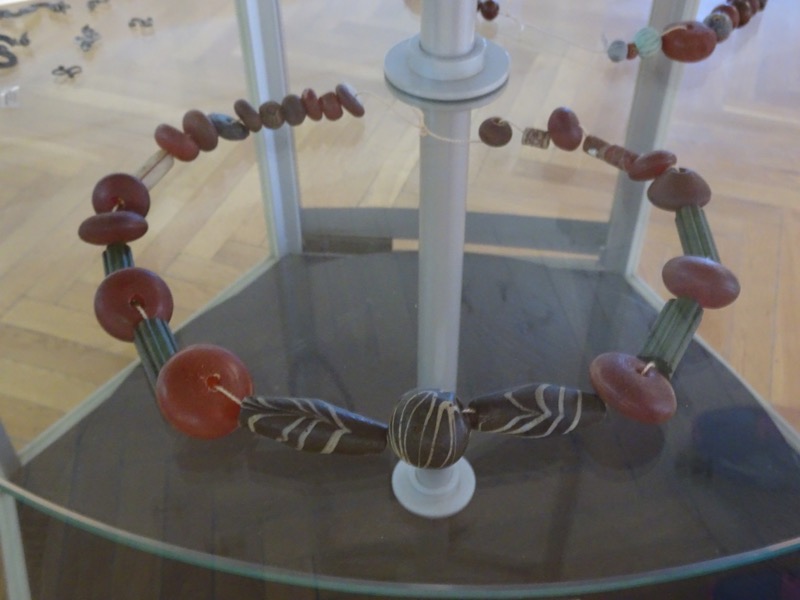

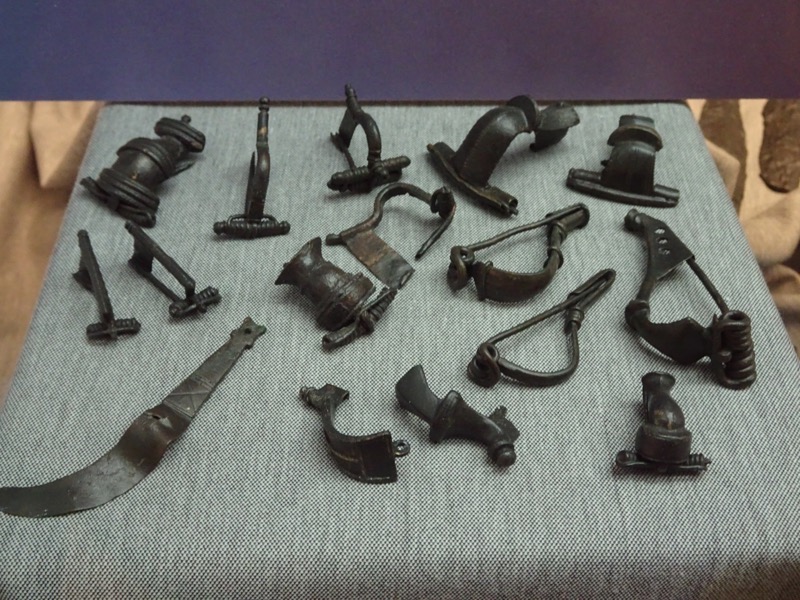
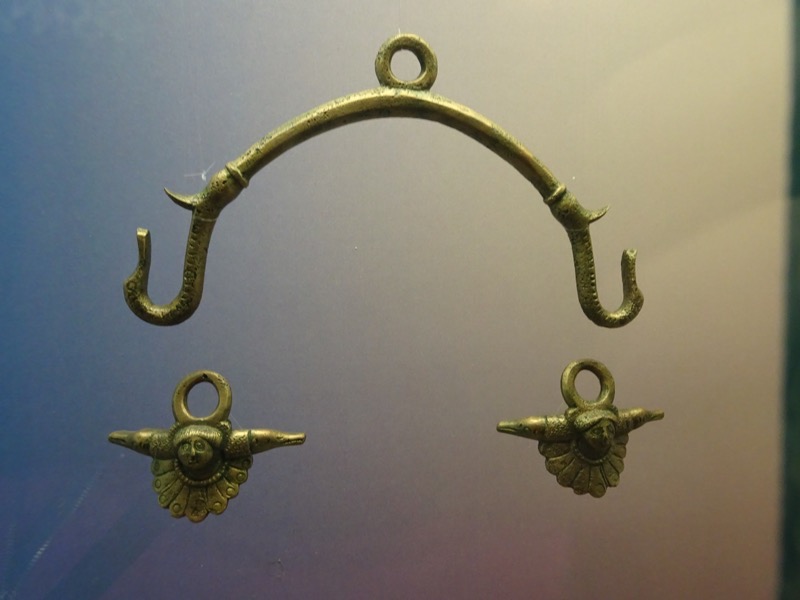

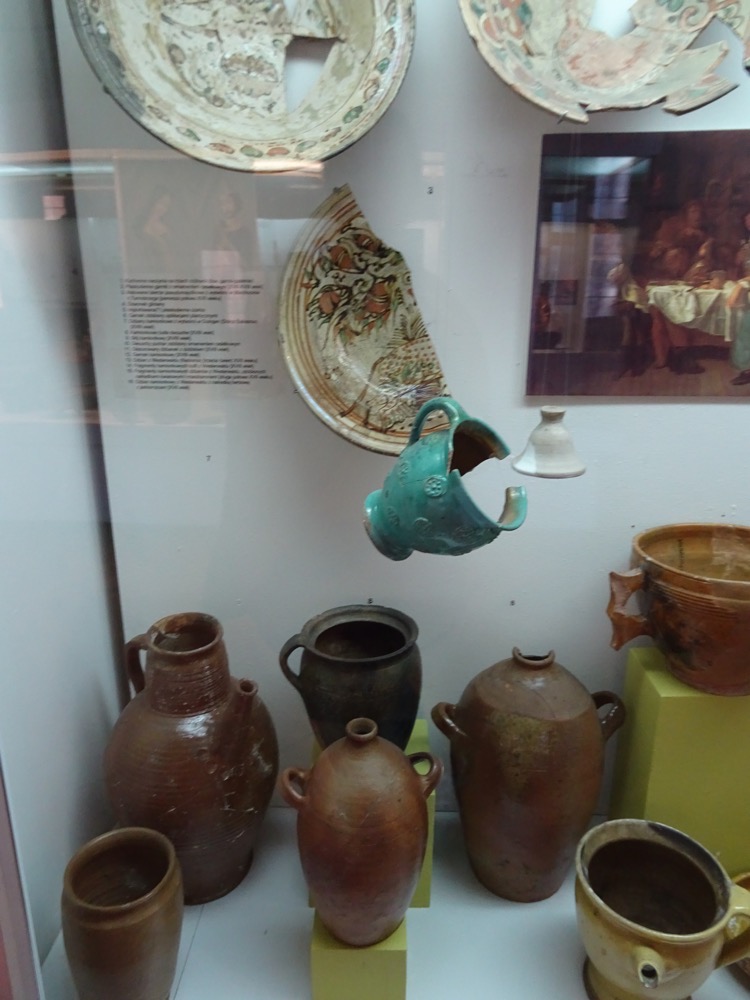
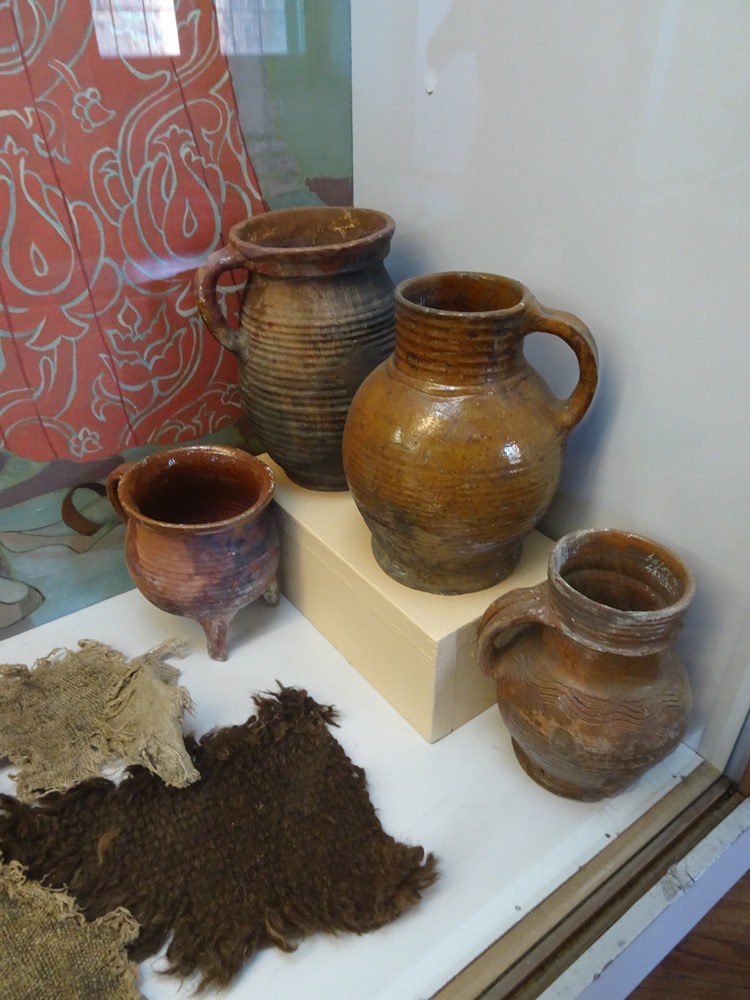
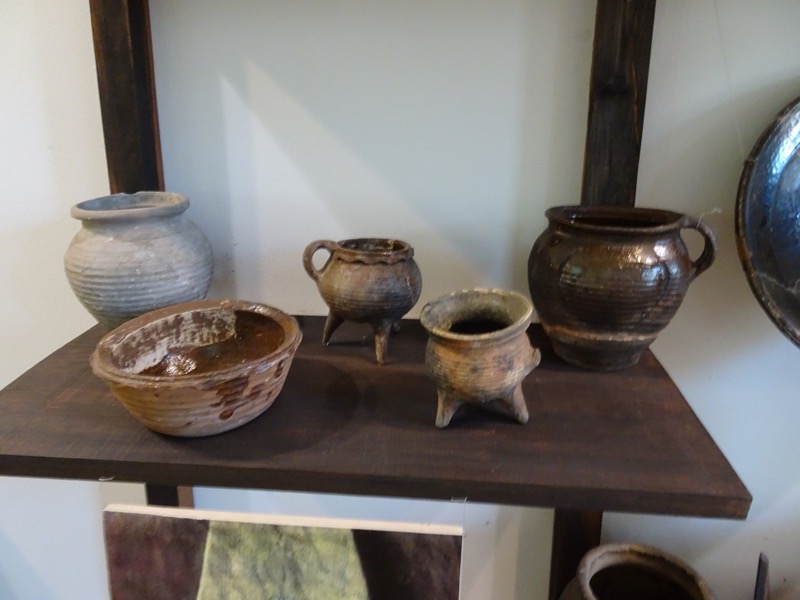


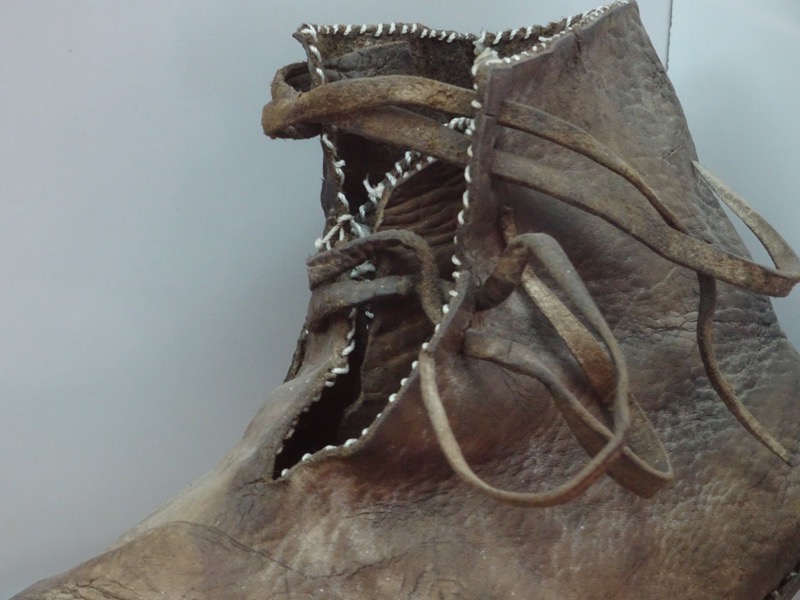
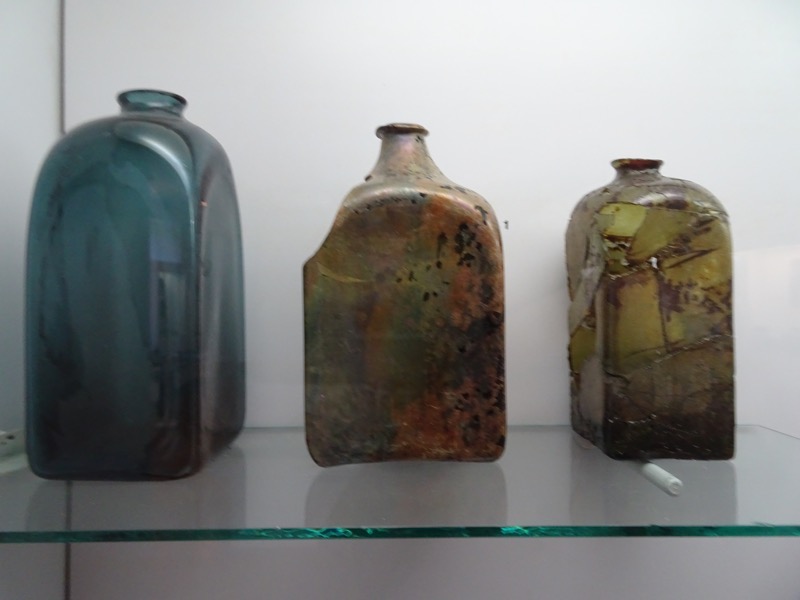 This was marked – it’s a 10th century viking longboat most likely used for trading and not so much for the war and the pillaging bit.
This was marked – it’s a 10th century viking longboat most likely used for trading and not so much for the war and the pillaging bit.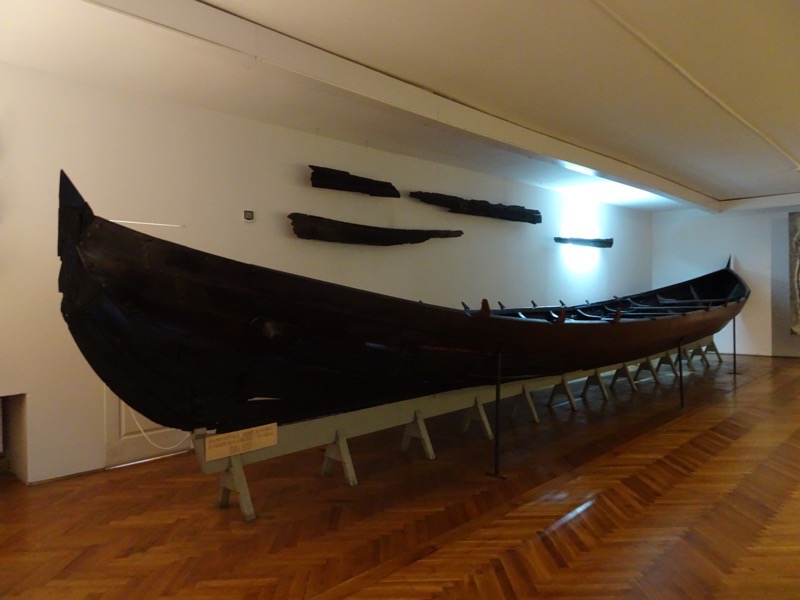
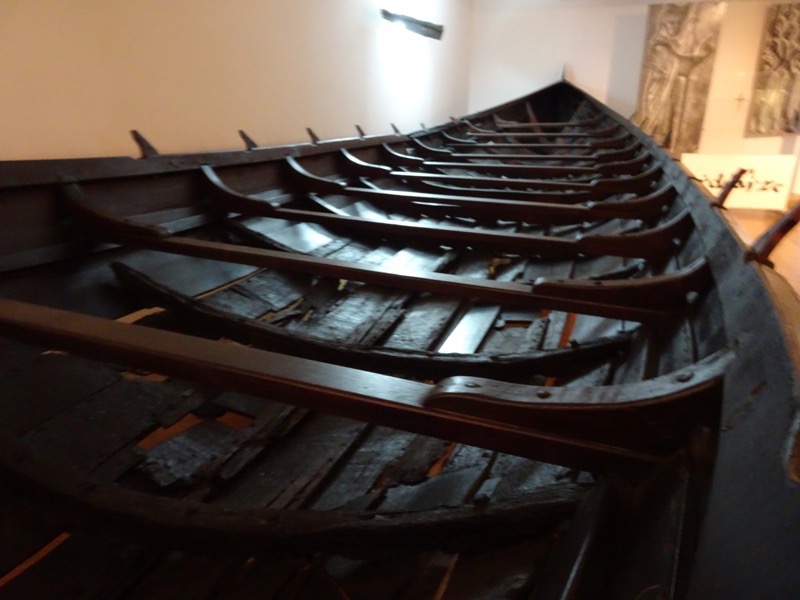
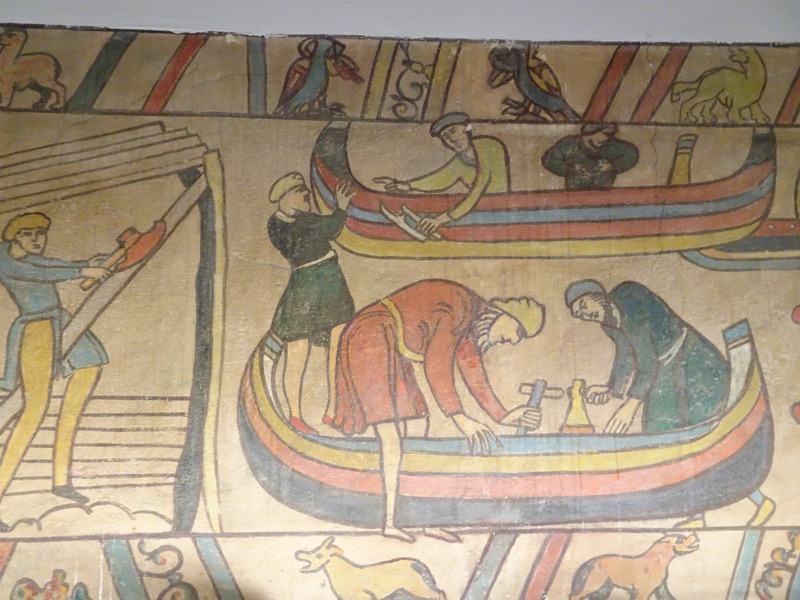


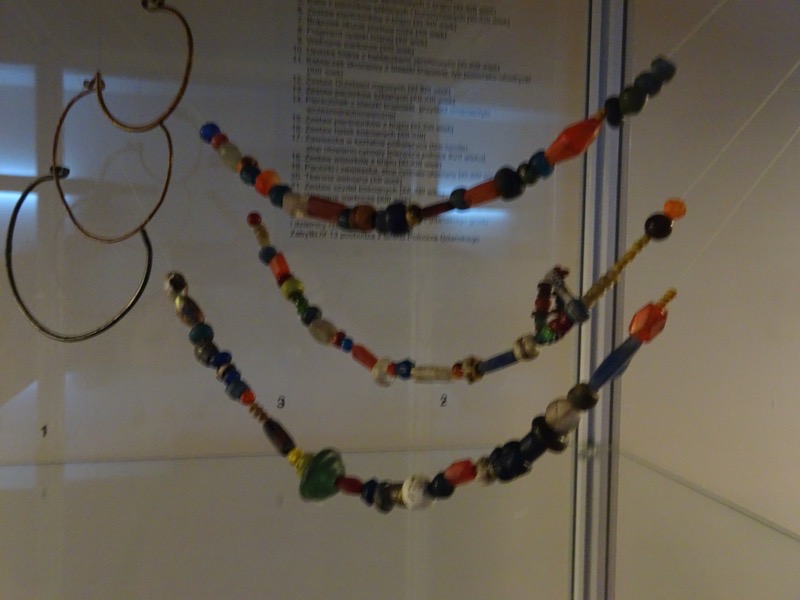 The most noteable thing about the Gdansk Archeological Museum is how much of their collection was so completely lost during World War II. The Museum apparently had a remarkable collection of artefacts and now it is a hodge podge of what remains.
The most noteable thing about the Gdansk Archeological Museum is how much of their collection was so completely lost during World War II. The Museum apparently had a remarkable collection of artefacts and now it is a hodge podge of what remains.
After a wonderful day out exploring the city, we decided to look for one of Gdansk’s finest dining establishments – with some leftover Zloty, we thought we’d find somewhere really nice… and with fingers crossed, we might even find some friendly service too! We ended up at ‘Chef, Food & Friends’ and because we have a very early start tomorrow, we went out for a 7pm dinner (read: an unusually early meal time on the Continent) so we had the restaurant entirely to ourselves.
Wines and lager ordered, we then took a moment to drool over the menu.
I had the Beef Tartare with Black Truffles, and it was really good. A lighter on the vinegar than you might expect, but lovely citrus and onion flavours with just the right hint of truffle. yale splashed out and ordered the Fried Foie Gras which was served with a beetroot sponge and truffle mousse – the sponge was light and fluffy as to be souffle-like, and the foie gras was rich and in a really meaty flavoursome sauce.
yale splashed out and ordered the Fried Foie Gras which was served with a beetroot sponge and truffle mousse – the sponge was light and fluffy as to be souffle-like, and the foie gras was rich and in a really meaty flavoursome sauce. For a main, I ordered the Pork Tenderloin that came wrapped in bacon was served with pearl buckwheat and caramelised red onion jam. Fabulous!
For a main, I ordered the Pork Tenderloin that came wrapped in bacon was served with pearl buckwheat and caramelised red onion jam. Fabulous! And becaue yale is a bottomless pit, he ordered two mains, Greased “Russian” dumplings with curd cheese filling served with bacon sprinkles and sour cream (the Polish love their sour cream!). These were very tasty also but a bit stodgy for my liking.
And becaue yale is a bottomless pit, he ordered two mains, Greased “Russian” dumplings with curd cheese filling served with bacon sprinkles and sour cream (the Polish love their sour cream!). These were very tasty also but a bit stodgy for my liking. And he also had the Guinea Fowl breast served with truffle potatoes and a vegetable ratatouille… which was also really really good.
And he also had the Guinea Fowl breast served with truffle potatoes and a vegetable ratatouille… which was also really really good. After this, we had to decline dessert – as the portions were much larger than you normally encounter in high-end restaurants. But our waiter was having none of that, said we can’t end our meal there and he brought us some complimentary freezing cold, cherry vodka liqueurs to try.
After this, we had to decline dessert – as the portions were much larger than you normally encounter in high-end restaurants. But our waiter was having none of that, said we can’t end our meal there and he brought us some complimentary freezing cold, cherry vodka liqueurs to try. This stuff is amazing -Lubelska Wisniowka Cherry Vodka – I’m not normally one for cherry flavoured anything, but served freezing cold, it certainly warmed the cockles quicker than anything I’ve ever tried. Only 30% alcohol, I could have had two more.
This stuff is amazing -Lubelska Wisniowka Cherry Vodka – I’m not normally one for cherry flavoured anything, but served freezing cold, it certainly warmed the cockles quicker than anything I’ve ever tried. Only 30% alcohol, I could have had two more.
I would certainly recommend this amazing restaurant, Chef Food & Friends – the food was divine, the prices were very reasonable, our meal including alcohol was just over AUD$100 (not looking forward to paying for meals in Euros again), and it was the first time we encountered service staff that seemed friendly and helpful too.
All up we had a great day out in Gdańsk and I would love to come back as there is so much more to see – so many museums we either couldn’t see (Sunday) or didn’t have time to see. I nearly forgot to mention just how completely annihilated Gdańsk was during World War II… it suffered so badly as to look nothing like its current beautiful self. It is a testament to the will and perseverance of the people here, that they have taken the decades necessary to rebuild the city to reflect its previous glory, and not just bulldoze the lot and build parking lots. I feel so thankful that there were obviously people here who survived the war and cared enough about their cultural heritage to rebuild rather than reinvent.
I <3 Gdańsk!
